Journal of Mathematics Vol.1
Matrices, Pixels, and RGB
Exploring Recursive Sequences with Eigenvalues and Eigenvectors
An Introduction to Combinatorial Partitions

Calculating Implied Volatility using the Black-Scholes Model
Countably and Uncountably Infinite Sets
Introduction to Chaos Theory Investigating the Theoretical and Practical Applications of Fractals
Singular Value Decomposition and a Recommendation Algorithm
Natural Eigenvectors in High Number Systems
Evaluating Epidemiological Solutions through S-I-R Modeling
EDITOR’S LETTER
Welcome to our groundbreaking project that brings together math enthusiasts to dive into the depths of diverse mathematical concepts and applications! This mini-mathematical journal that showcases the passion and expertise of our math club members. We want to provide an opportunity for everyone in the school community to engage with the exciting and fascinating world of math.
Through this journal, readers will discover innovative and insightful research articles that delve into a wide range of mathematical topics. We aim to make these complex ideas accessible to all, without sacrificing academic rigor.
We invite you to join us on this exciting journey as we pave the way for a vibrant and stimulating mathematics-focused community at our school!
Gyulim Jessica Kang, Frank Xie Editors-in-Chief55
43
Singular Value Decomposition and a Recommendation Algorithm
Frank Xie
49
Natural Eigenvectors in High Number Systems
Gaurav Goel Evaluating Epidemiological Solutions through S-I-R Modeling
Gaurav Goel
64 Finding an Alternate Model to Malthusian Population Growth Model
Irene Choi, Morgan Ahn, Vyjayanti Vasudevan
69 Application of Eigenvectors and Eigenvalues: SVD Decomposition in Latent Semantic Analysis
Gyulim Jessica Kang
77 Creating a Machine Learning Pipeline to Perform Topological Data Analysis
Gyulim Jessica Kang
82 Evaluating Affirmative Action in School Choice: Comparing Mechanisms with Minority Reserves
Gyulim Jessica Kang
Matrices, Pixels, and RGB
Written by Hyeonseo KwonMatrices,Pixels,andRGB(ATLAProject)
HyeonseoKwon
kwon49627@sas.edu.sg
TeacherReviewers: Mr.Zitur,Mr.Craig
Abstract
FromInstagramtoTiktok,socialmediahasgrowntobean intrinsicpartofmodernsocietytoday.Outofmany,oneof itsmostprominentfeaturesthatcaughtmyattentionwasthe differenttypesoffacefiltersinstalledincamerasofsocial mediaapps.Withsocialmedia,thereisnolimittohowyou wantyourphotostolook.Ithoughtthiswasparticularlyinteresting.UsingtheconceptsofmatrixmanipulationofRGB excelpixels,Idecidedtogoastepfurtherandexploretheapplicationofmatrixcalculationsincreatingfacefilters.
Keywords:matrices,RGB,Gaussianblur
1PixelProject
Let’sbreakdownthebasicprinciplesofhowthepixels ofimagesworkinExcel.Whendigitalphotosareturnedinto excelspreadsheets,eachpixelisdividedintothreeRGBvalues:Theamountofred,green,andbluestoredinthepixel. Therefore,performingmatrixmultiplicationtoeachpixel’s setofRGBvaluesallowsustomanipulatethevaluesinthe photosandchangehowtheyappearonthescreen.
thiscalculationisdoingisscalingdowntheRGBmatrix oftheoriginalimagetoacertainlevel(forexample,0.5), scalingdowntheRGBmatrixofthefiltertoanumberthat isthescalefactoroftheRGBmatrixoftheoriginalimage subtractedfrom1(whichinthiscasewouldbe0.5),and addingthetwomatricestogethertocreateanewmatrixthat istheresultofthematrixcalculation.Toputthisintothe perspectiveofnumbercalculations,let’ssayoneofthepixel valuesoftheoriginalimagehasanRGBmatrixof[206,192, 175],andoneofthepixelvaluesofthefilterhasanRGB matrixof[189,131,120].
Figure1:Overlayingavintagefilteronanimage
Here,Iwasabletocreateacolorfilterbybreaking theimageaboveintopixelsandmultiplyingtheportionof thevaluesofthisimagebytheportionofthevaluesofthe originalimage.Theformulausedtoperformthiscalculation was DA1$A$228+(1-$A$228)HA1,where DA1 wasthe locationofthefirstpixeloftheoriginalimageand HA1 was thelocationofthefirstpixelofthe“filter.”Essentially,what
Iwantedtousetheseconceptstocreatefiltersthat somewhatimitatetheactualfiltersthatcanbeseeninsocial mediaapps.
2Extension1

IfirstconvertedtwophotosintoRGBpixelsand pastedthemontoExcel.
Idecidedtosettheopacityto50%asit madethemostsense.Then,Iusedtheformula
A1*$A$611+(1-$A$611)*HA1 (thecolumnand rownumberchangesforeachpixel)whichsetstheopacity ofthephotosto50%andcombinethemtogethertocreate asingleimage.Thisprocessallowedmetogeneratean averagefacebetweentheyoungerandolderversionof AudreyHepburn.Iwasaimingtoimitatethefiltersthattake yourbabyfaceandcreateahypotheticalversionofyour olderself.
Thisisbecausethecolorsgetbrighterapproachwhite astheRGBvaluesgetcloserto255.Forexample,ifapixel intheoriginalimagehadtheRGBvaluesof[100100100], andamatrixof[303030]wasadded,theresultwouldbe [130130130]pixelwouldachieveagreaterRGBvaluethus alightercolor.Here,matrix A representstheRGBvalues oftheoriginalimage,andmatrix B representsthe“filter”. Iusedtheinverseoftheidentitymatrixtocreateamirroringfilter.Thismatrixallowsthevaluesinthematrixtobe mirroredliketheexamplebelow.Here,youcanseethatmultiplyingtheinverseoftheidentitymatrixflipsthelocation of ac and bd.
3Investigation2/Extension2(Coding)
Formysecondextension,IwantedtocreateafilterwithcodingthatimitatesthePhotoshopfilterslikeface brighteningormirroringeffects.Toachievethis,Iusedbasic matrixcalculationprincipleslikematrixadditionandmultiplyingtheinverseofanidentitymatrix.Forthebrightening effect,Iusedthefollowingformula:
Ithoughtitwasparticularlyinterestinganddecidedto employthismethodtotrymirroringimagesaswellusing thesameprinciple.
1 # Whitening skin
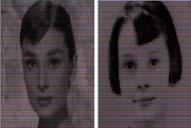
2 img=cv2.imread("face.jpg",cv2. IMREAD_COLOR)
3 mag=img.shape
4
5 whiten=np.zeros((mag[0],mag[1],3))
6 7 whiten[:,:,0]=np.ones([mag[0],mag [1]])*30

8 whiten[:,:,1]=np.ones([mag[0],mag [1]])*30
9 whiten[:,:,2]=np.ones([mag[0],mag [1]])*30
10
11
cv2.imwrite(’whiten.jpg’,whiten)
12 whiten=cv2.imread("whiten jpg",cv2. IMREAD_COLOR) 13 14 applied=cv2.add(img,whiten) 15 cv2.imshow(’original’,img) 16 17 cv2.imshow(’applied’,applied)
1 (6720,4480,3)
Theprintedvaluefromthesecondbox(6720,4480, 3)showsthesizeofthematrixofthephotos.Thismeans thattheoriginalphotohadthreematriceswiththesizeof 6720 × 4480,eachmatrixbeingeitherthered,green,or
bluecomponentofthepixels.Withthisoriginalmatrix, A, thefiltermatrix, B,wouldalsobe6720 × 4480withthe samevalue(inthiscase,it’s30)inallentries.Thissnippetof codeallowstheimagetogainhigherRGBvaluesfollowing thematrixadditionrule.Thus,the B matrixhastobeadded toallthreematricesof A,andthethreematricesaltogether showthefinalimage.
Thesecondstepwastocreateamirroringfilterthatreversestheimage.InUnit1,whiledoingthecartoonproject, thematrixthatallowedtheplotstobereflectedagainstthe y -axiswasthefollowingmatrix.
C = 10 01
However,becausewearedealingwithRGBvaluesin thisproject,thismatrixcannotbeused(colorintensitycan notbenegative).Thereforethealternativematrixthatcould beusedherewastheinverseoftheidentitymatrix.
1 # getting mirror image
2
3 img_flig_lr=cv2.flip(img,1)
4 cv2.imshow(’flip’,img_flip_lr)
5
6 #display image for 20 seconds
7 cv2.waitKey(20000)
8 cv2.destroyAllWindows()
Thiscodesnippetfollowsthesameprincipleasthe matrixcalculationwiththeinverseoftheidentitymatrix, which,asshownabove,resultsinaflippedimage.Thiscode printsthefollowingmirroredimage.
ThethirdthingIdecidedtoaddwasablurringfilter thatintentionallyblursthephoto.ThisisoftenusedtoPhotoshoppeople’sskinandremoveanyblemishesorpimples. TheformulausedherewastheGaussianblur.

TheGaussianfilterformulacalculatestheweighted averageofthecurrentpixelandneighboringpixelvalues toreplacethecurrentpixelvalue.Theclosertothecurrentpixel,thegreatertheweight,andthefarther,thesmaller theweight.Whenthisformulaisusedinimages,itreduces noiseandsmoothenstheimage.However,theborderofthe imageisalsoblurred.Inordertopreservetheborders,the originalformulaismodified:


1 blur=cv2.bilateralFilter(applied ,50,75,75)
2 # bilateralFilter(src, dst1, 5, 250, 10) ;
3 blur2=cv2.cvtColor(blur,cv2. COLOR_BGR2RGB)

4 plt.subplot(121),plt.imshow(img2),plt. title(’Original’)
5 plt.xtics([]),plt.yticks([])
6 plt.subplot(122),plt.imshow(blur2),plt. title(’Blurred’)
7 plt.xticks([]),plt.yticks([])
8 plt.show()
9
10 cv2.imshow("before",applied)
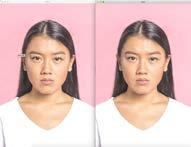
11 cv2.imshow("after",blur)
12 cv2.waitKey(3000)
13 cv2.destroyAllWindows()
ThiscodesnippetemploystheGaussianblurformula andblursthephoto.The(50,75,75)inthefirstlineofthe coderepresentthediameter,sigmaColor,andsigmaSpace, respectively.Thelargerthediameteris,theblurrierthephoto getsduetothefactthatlargerdiameterscoverlargerareas.
ZiturLinearAlgebra-1.7.6PixelPictures.(2023). Retrieved31January2023,from https://sites.google.com/a/sas.edu.sg/zitur-linearalgebra/home/unit-1/1-2-5-pixel-into-pictures?authuser=0
31January2023,from https://parklanda.tistory.com/15761458
4Summary
Overall,Ireallyenjoyedthefreedomofchoosingthe topicandtinkeringwithdifferenttypesofcomputersoftware.Comingupwithanideawasdefinitelychallengingat first,butIwaseventuallyabletogenerateoriginalideasthat reallyhelpedmepropeltheprojectforward.Althoughmy extensionswerenotperfect,Igenuinelyenjoyedtheprocessandwassatisfiedwithmyproduct.Tosummarize,this projectusesthebasicprinciplesofmatrixcalculationand appliestheminabroadercontextfromtheperspectiveof images.Themainthemeofthisprojectwasfacefilters,and Iaimedtoimitatepopularfiltersonsocialmediaorcamera appsonmyownusingExcelandJupyternotebook.Itwasa veryinterestingexperiencebeingabletomergevisualswith mathtogetherandunderstandhowthereisalwayssomesort ofmathbeneatheverything.
References
ApplicationsofLinearAlgebrainImageFilters[PartI]Operations.(2020).Retrieved31January2023,from https://medium.com/swlh/applications-of-linear-algebra-inimage-filters-part-i-operations-aeb64f236845 opencv-python.(2022).Retrieved31January2023,from https://pypi.org/project/opencv-python/ Python—BilateralFiltering-GeeksforGeeks.(2019). Retrieved31January2023,from https://www.geeksforgeeks.org/python-bilateral-filtering/ Rosebrock,A.(2021).OpenCVLoadImage(cv2.imread)PyImageSearch.Retrieved31January2023,from https://pyimagesearch.com/2021/01/20/opencv-load-imagecv2-imread/
아름다움의 정상, 오드리 햅번의 생애 .(2013).Retrieved
Exploring Recursive Sequences with Eigenvalues and Eigenvectors
Written by Akshay AgarwalExploringRecursiveSequenceswithEigenvaluesandEigenvectors
AkshayAgarwal agarwal45366@sas.edu.sg
TeacherReviewer:
Mr.Son
Abstract
Abstract
Recursivesequencesarewell-knownandwell-studied.Generally,whenlearningabouttheminearliermathclassessuch asPrecalculusandAlgebra,theonlywaytheywerecomputed were...recursively.Forinstance,thefibonaccisequencetends tobecalculatedbymanuallyaddingtheterms 0+1=1+1= 2+1=3...However,representingrecursivesequencesinthis mannerhidesalotoftheintricaciesandbeautyinrecursive sequences...especiallythefibonaccisequence.Afterexploringthefibonaccisequence,wegoontogenerateourown spiralswithcomplexeigenvaluesandcalculatethetransformationsthatformthespiral.
Keywords: Fibonaccisequence,eigenvalues,eigenvectors, complexnumbers,transformations,matrices
1TheFibonacciSequence
TheFibonaccisequenceisawell-knownsequence, whichconsistsof:
youlistenoughnumbers,theratiooftwoconsecutiveterms inthesequencegetscloserandcloserto
Thus,findingandsolvingthecharacteristicpolynomialyields: (1 λ) ·−λ 1= λ2 λ 1=0
Bythequadraticformula, λ = 1+√( 1)2 +4 1 2 = 1+√5 2 = ϕ
WhichISthegoldenratio!
FibonacciSequenceisn’tUnique?
Aswe’vealreadyfoundtheeigenvaluesofthefibonaccimatrix,itnaturallyfollowstofindtheeigenvectors
Reducingthematrix:
Astheeigenvalueisalso ϕ,thatmeansthatitshould beaneigenvectorforanystartingvalue,asthey-coordinate willeventuallybecome ϕ timesthex-coordinate.Let’stest this:
2RecursiveSequenceswithComplex Eigenvalues
GeneratingtheRecursiveSequence
Ascalculatingtheeigenvalue, λ,fora 2x2 matrixrequiresusingthequadraticformula,ifthecharacteristicpolynomialofthematrix’sdiscriminantisnegative, λ willbe complex.
Ihadtofindamatrixwithcomplexeigenvaluesthat stillfunctionedasaseries,whichmeantthatmymatrix A hadtobeintheform: ab 10 aswhenmultiplying an an 1 = ab 10 an 1 an 2 , thebottomvalueoftheresultantmatrixwillbe an 1 ,which createstheidealsequence.
Next,thematrixneedstohavecomplexeigenvalues, thecharacteristicpolynomialofthematrix a λb 1 λ
is λ2 + λa b =0
Thediscriminantofthispolynomialis a2 +4b,where a2 +4b< 0 needstobesatisfied.Ichoseasimplesolution where a =2,b = 2,suchthat a2 +4b =22 +4( 2)=
Thus,thematrixIcreatedforthisextensionis A = 2 2 10 .
Thismeansthatmyrecursivesequenceisdefinedas
Whengraphingthissequence,aninterestingrelationshipisdiscovered:
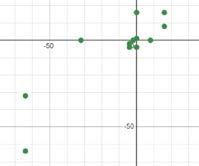
Figure3:Complexeigenvaluebasedrecursivesequence graphedonthe x-y plane.
Asopposedtoaregularspiral,thisspiralseemstobe tilted,asifit’srotatedaboutanellipse.Aderivationofthe transformationsthatleadstothisisthepremiseofmyextension.
DerivingtheTransformations
Inordertocomputethetransformations,theeigenvaluesandeigenvectorswouldlikelybenecessary,sothey shouldbecalculatedfirst.
Fortheeigenvalues,simplysolvethecharacteristic polynomialwederivedearlierof λ2 2λ +2=0,where λ = 2±√ 4 2 =1 ± i
Astheeigenvaluesareconjugates,theeigenvectors willlikelybetoo...let’scomputetheeigenvectorwhen λ = 1+ i.Theresultingmatrixtorowreduceisthen: 1 i 20 1 1 i 0 ∼ 1 1 i 0 000 ,somy
eigenvectoris 1+ i 1
Now,asissimilartoseparatingthebasisofasolutionset,wecanseparatetherealandimaginarypartsofthe eigenvectortoformamatrixwhosecolumnsrepresentthe eigenvector:
P = 11 10 ,asthefirstcolumnaretherealcomponentsandthesecondaretheimaginarycomponents.
Now,usingdiagonalization,wecantriviallyfindthe transformationmatrixwith P 1 A P = 11 11 ,by matrixmultiplication.
Now,inthespiralwesawearlier,it’sintuitivethatthe transformationstakingplaceforeachiterationisarotation andscalar(that’showthespiralshapeforms).Thiscanalso beverifiedbylookingattheformofourtransformationmatrix.
Thegenericformofascalarmatrixis r 0 0 r ,while
thegenericformofarotationmatrixis cos(θ ) sin(θ ) sin(θ )cos(θ )
Multiplyingthesematricesyields:
r cos(θ ) r sin(θ )
r sin(θ ) r cos(θ ) ,whichisinthesameformas thetransformationmatrixwegotasthetop-leftandbottomrighttermarethesame,whilethetop-rightandbottom-left termarenegativeinversesofeachother.
Thescalarshouldsimplybethemagnitudeofthe eigenvalue, λ = i + i,whichgives √12 +12 = √2
Wethenget, 11 11 = √2cos(θ ) √2sin(θ ) √2sin(θ ) √2cos(θ ) As cos(θ )= 1 √2 , θ = π 4 , whichmeansthatthespiralshownscalesthepointsby √2 androtatesthemby 45 degrees.
WhatIcoulddeduceaboutthereasoningforthetilt isthatthetransformationmatrixwegotwillsimplygraph thestraightspiral,butbecauseweseparatedtheeigenvector intotherealandimaginarycomponents,multiplyingbymatrix A transformsitinthebasisoftherealandimaginary components 1 1 and 1 0 ,respectively.
Therefore,foranysequencewithcomplexeigenvalues,thespiraltransformationscanbederivedinthismethod.
3Conclusion
Here,weinitiallyinvestigatedfibonaccisequencesto seehoweigenvaluesandeigenvectorscanrevealnewinsightsaboutthem.Then,weextendedthatknowledgeto tryingtounderstandhowrecursivesequenceswithcomplex eigenvalueswork;eventuallyformingspiralsandcomputing thetransformationswhichdefinethem.Thisisreallyjust thebrinkofthesurfacewhenitcomestoexploringcomplexeigenvaluesandeigenvectors,astheonlypatternswe deducedarethoseofthetransformations,whereasonecan alsoinvestigatethelimits,theslope,andseveralothercharacteristicsofanyspiral.Agoodsupplementmayalsobeexploringifthespiralsdifferwhenthestartingmatrixdoesn’t definearecursivesequence.
References
Aron.(n.d.).reference—p5.js.P5js.org.RetrievedApril6, 2023,fromhttps://p5js.org/reference/group-IO FibonacciNumbers,T.(n.d.).Fibonaccinumbersfrom eigenvectorsandeigenvalues.RetrievedApril6,2023,from
https://www.d.umn.edu/mhampton/m3280f12/FibonacciNumbers.pdf Ph.D,A.C.(2021,August18).TheLinearAlgebraViewof theFibonacciSequence.Medium. https://medium.com/@andrew.chamberlain/the-linearalgebra-view-of-the-fibonacci-sequence-4e81f78935a3
An Introduction to Combinatorial Partitions
Written by Akshay AgarwalAnIntroductiontoCombinatorialPartitions
AkshayAgarwal
agarwal45366@sas.edu.sg
TeacherReviewer: Ms.Poluan
Abstract
Thispaperpresentsanintroductiontoamajorpartofmoderndaycombinatoricsandnumbertheory:partitions.Thedefinitionofapartitionofanypositiveinteger n issimplyinvestigatingthewaysonecanwrite n asasumof positive integers.MathematicianssuchasRamanujanhavebeendelving intopartitionsforhundredsofyears,findingidentitiesand formulaeregardingthetypeofpartition,howthey’reconstructed,andhowthey’remodeled,whichforthosewhoare well-accustomedtocalculus,isagreatsupplementtothispaper.Butthispaperwillbefocusingonthecombinatorialside ofpartitions,whichiscountingthembasedonanumberof restrictions.Thecontentinthispaperisinterestingfroma puremathview(withafew,newlyderivedformulae),butalso servesasanexpositorypieceforthosewhoarecompetingin mathcompetitions.
Keywords: StarsandBars,combinations,one-to-onecorrespondence,recursive
1AnIntroductiontoPartitions
Incolloquialterms,apartitionofanumber n canbe thoughtofasanactionofputting n ballsintoboxes,such thatifyouhave 5 ballsandput 1 inonebox, 2 inanother box,and 1 inathirdbox,thepartitionwillbe 1+2+1 Thus,wecanthinkaboutpartitionsinfourdifferentcategories,listedbelow:
1. Ballsareidenticalandboxesaredistinguishable.
2. Ballsareidenticalandboxesareidentical.
3. Ballsaredistinguishableandboxesareidentical.
4. Ballsaredistinguishableandboxesaredistinguishable.
Noticehowincase 1 wheretheboxesaredistinguishable, 1+2+1 willbeconsideredadifferentcasefrom 2+1+1,whereasitwouldbeconsideredasonepossibility incase 2.Thispaperwillprimarilybecoveringthefirsttwo cases,wherethefirsttool,StarsandBars,willaddresscase 1,andthesecond,recursivetool,willaddresscase2.
2StarsandBars
Forsomecontext,asampleproblemwhichissolved bystarsandbarsispresented:
Example1.0.1 Dr.Evil’s5thgradeclasshas6students. Dr.Evilhas6identicalcandiestogivetothe6students.
However,asDr.Evilisevil,hedoesn’tnecessarilywantto give1toeachstudent.Howmanywaysarethereforhimto givethesecandiestothestudents?
Whenreadingthisproblem,it’seasytonoticetwo things.First,thisfollowsourguidelineofidenticalballsand distinguishableboxes.Inthiscase,thecandiesareidentical, andevidently,thestudentsaredistinguishable.
Secondly,ifweweretophysicallycountthembylistingthemallout,itwould (a) beextremelytime-consuming and (b) beextremelyeasytomiscount;thisiswhereStars andBarscomesin.
StarsandBarsasaPicture
Tostartgettinganideaofhowtousestarsandbars, let’sutilizeexample1.0.1.Letusimagineeachofthe identicalcandiestobecircles/ballsasshownbelow.
[color=black!60,fill=white!5,verythick](-1,0)circle(0.25); [color=black!60,fill=white!5,verythick](-1,0)circle(0.25); [color=black!60,fill=white!5,verythick](-1,0)circle(0.25); [color=black!60,fill=white!5,verythick](-1,0)circle (0.25); [color=black!60,fill=white!5,very thick](-1,0)circle(0.25); [color=black!60, fill=white!5,verythick](-1,0)circle(0.25);
Letusimagineputtinglinesorbarsinbetweengaps ofthecirclestoseehowmanycandieseverystudentgets.A smallexampleisdemonstratedbelow.
[color=black!60,fill=white!5,verythick](-1,0)circle(0.25);[black,thick](-1,0.5)–(-1,-0.5); [color=black!60,fill=white!5,verythick](-1,0)circle(0.25);[black,thick](-1,0.5)–(-1,-0.5); [color=black!60,fill=white!5,verythick](-1,0)circle(0.25);[black,thick](-1,0.5)–(-1,-0.5); [color=black!60,fill=white!5,verythick](-1,0)circle(0.25);[black,thick](-1,0.5)–(-1,-0.5); [color=black!60,fill=white!5,verythick](-1,0)circle(0.25); [black,thick](-1,0.5)–(-1,-0.5);[color=black!60, fill=white!5,verythick](-1,0)circle(0.25);
[color=black!60,fill=white!5,verythick](-1,0)circle (0.25);
Intheconfigurationabove,wehavedividedthecandiesintosixpartitionsusingfivelines.Eachpartitionhas sizeone,meaningeverystudenthasonecandy.Now,letus
lookatanotherconfigurationandbasesomeconclusionson that.
[color=black!60,fill=white!5,verythick](-1,0)circle(0.25); [black,thick](-1,0.5)–(-1,-0.5);[black,thick](-0.75,0.5) –(-0.75,-0.5);[color=black!60,fill=white!5,very thick](-1,0)circle(0.25);
[color=black!60,fill=white!5,verythick](-1,0) circle(0.25);[black,thick](-1,0.5)–(-1,-0.5);[black, thick](-0.75,0.5)–(-0.75,-0.5);[color=black!60, fill=white!5,verythick](-1,0)circle(0.25);
[color=black!60,fill=white!5,verythick](-1,0) circle(0.25);[black,thick](-1,0.5)–(-1,-0.5); [color=black!60,fill=white!5,verythick](-1,0)circle(0.25); [color=black!60,fill=white!5,verythick](-1,0)circle (0.25);
Intheconfigurationshownabove,weagainhavedividedthecandiesintosixpartitionsusingfivelines.Yet, thepartitionsizesarevarying,meaningthateachstudent getsavariedamountofcandies.Thenumberofcandiesare 1, 0, 2, 0, 2, 1 perstudentfromlefttoright.
Thesetwoconfigurationsinformusofseveralthings. Firstofall,wecannowbesurethattheballsareidentical, andthattheboxesaredistinguishable.Theballsareidenticalbecausewearepartitioningthe interchangeable balls. Inaddition,withthesticks,wecanrepeatedlychangethe candydistribution(toaccountforallthevariouscases).For example,inthesecondconfigurationshown,thedistribution ofcandiesis1-0-2-0-2-1,yetthedistributioncouldalsobe 2-0-1-2-1-0.Here,weseethattheindividualnumberscan beidentical,yettheorderisdifferent.Therefore,theboxes havetobedistinctiveforustousethistechnique.
Addingtoabove,puttingthebarsindifferentgapsbetweentheballswillyielduseverypossiblearrangement, thusensuringwewon’tbeover-countingorunder-counting. Now,therewillbetwosolutionspresentedtoexample1.0.1. Theinitialsolutionwillbea“bogus”solution,whichisan incorrectsolution,butitwillindicateacommonmistake. Thesecondsolutionwillaccuratelyutilizethestrategywe developedabove.
Example1.0.1:Dr.Evil’s5thgradeclasshas6students. Dr.Evilhas6identicalcandiestogivetothe6students. However,asDr.Evilisevil,hedoesn’tnecessarilywantto give1toeachstudent.Howmanywaysarethereforhimto givethesecandiestothestudents?
Solution1(Bogus): Wecannowtrytouseournewdiscoveriestothisproblem.Let’sdrawall6balls,representingthe 6candies.
[color=black!60,fill=white!5,verythick](-1,0)circle(0.25); [color=black!60,fill=white!5,verythick](-1,0)circle(0.25); [color=black!60,fill=white!5,verythick](-1,0)circle(0.25); [color=black!60,fill=white!5,verythick](-1,0)circle (0.25); [color=black!60,fill=white!5,very thick](-1,0)circle(0.25); [color=black!60, fill=white!5,verythick](-1,0)circle(0.25);
Now,letusmarkallthegapsinwhichwecaninsert thelinesaswedidabove.Notethatanypersoncanhave0 candies,whichiswhywehavetocountthegaptotheleft
oftheleftmostballandthegaptotherightoftherightmost ball.
[black,thick](-1.25,-0.25)–(-0.75,-0.25); [color=black!60,fill=white!5,verythick](-1,0)circle (0.25);[black,thick](-1.25,-0.25)–(-0.75,-0.25); [color=black!60,fill=white!5,verythick](-1,0)circle (0.25);[black,thick](-1.25,-0.25)–(-0.75,-0.25); [color=black!60,fill=white!5,verythick](-1,0)circle (0.25);[black,thick](-1.25,-0.25)–(-0.75,-0.25); [color=black!60,fill=white!5,verythick](-1,0)circle (0.25);[black,thick](-1.25,-0.25)–(-0.75,-0.25); [color=black!60,fill=white!5,verythick](-1,0)circle (0.25);[black,thick](-1.25,-0.25)–(-0.75,-0.25); [color=black!60,fill=white!5,verythick](-1,0)circle (0.25);[black,thick](-1.25,-0.25)–(-0.75,-0.25); Intherepresentationabove,wecanseethatwemarked 7gapsforustoputthelines.Also,aswepreviouslysaw,we need5linestosplittherowofcandiesinto6differentparts. Therefore,wehavetochoose5outof7gapstoputthelines. Theansweristhen 7 5 = 21 .
So,whyisthissolutionincorrect?Wecanlookatthe 2ndconfigurationwemadeonpage5.There,weputtwo linesonthesamegaptoallow anyone toget0candies.Inthe gapsweidentifiedinsolution1,onlythefirstandlaststudent couldget0candies,meaningweseverelyundercounted. However,addingintheextragapsisnotveryeasy. Everygapbetweentheballscouldhaveupto5(allofthe lines)linesinsideofit.Asweinitiallyhadsevenslots,we wouldnowhave 7 5=35 slots.Wenowfaceanannoying, yettrueconundrum.Ifwehavefivegapsbutonlyputone line,it’sidenticalifthelineisonthe1stgap,the2ndgap, the3rdgap,the4thgap,orthe5thgap.
Thediagrambelowshowsanexampleofthisbeing true.Assumethegapsareinbetweentwoballs.
[color=black!60,fill=white!5,verythick](-1,0)circle(0.25); [black,thick](-1.25,-0.25)–(-0.75,-0.25);[black,thick](1,0.25)–(-1,-0.75);[black,thick](-1.25,-0.25) –(-0.75,-0.25); [black,thick](-1.25,-0.25)–(-0.75,-0.25); [black,thick](-1.25,-0.25)–(0.75,-0.25);[black,thick](-1.25,-0.25)–(-0.75,0.25);[color=black!60,fill=white!5,verythick](-1,0) circle(0.25);
Puttingjustonelineinthefirstslotlikethatisequivalenttoputtingjustonelineonanothergap,asshownbelow. [color=black!60,fill=white!5,verythick](-1,0)circle(0.25); [black,thick](-1.25,-0.25)–(-0.75,-0.25); [black,thick](-1.25,-0.25)–(-0.75,0.25);[black,thick](-1.25,-0.25)–(-0.75,-0.25); [black,thick](-1.25,-0.25)–(-0.75,-0.25);[black,thick](1,0.25)–(-1,-0.75);[black,thick](-1.25,-0.25) –(-0.75,-0.25);[color=black!60,fill=white!5,very thick](-1,0)circle(0.25);
Therefore,usingitlikethiswillseverelyovercount thenumberofcases.Sohowdowemakesurewedon’t undercountlikewedidinsolution1,butalsonotover countlikewe’redoinghere.Instead,wecouldlookatthe linesalittlebitdifferently.Insteadofputtinglines,let’sput
filledcircles,asshownbelow.
[color=black!60,fill=white!5,verythick](-1,0)circle(0.25); [color=black!60,fill=white!5,verythick](-1,0)circle(0.25); [color=black!60,fill=white!5,verythick](-1,0)circle(0.25); [color=black!60,fill=white!5,verythick](-1,0)circle(0.25); [color=black!60,fill=white!5,verythick](-1,0)circle(0.25); [color=black!60,fill=white!5,verythick](-1,0)circle(0.25); [color=black!60,fill=white!5,verythick](-1,0)circle (0.25);[color=black!60!,fill=black!60,verythick](1,0)circle(0.25);[color=black!60!,fill=black!60, verythick](-1,0)circle(0.25);[color=black!60!, fill=black!60,verythick](-1,0)circle(0.25); [color=black!60!,fill=black!60,verythick](-1,0)circle(0.25);[color=black!60!,fill=black!60,very thick](-1,0)circle(0.25);
Let’strytosimulateoneoftheconfigurationsusing thispicture.
[color=black!60!,fill=black!60,verythick](-1,0)circle(0.25);[color=black!60,fill=white!5,verythick](1,0)circle(0.25);[color=black!60,fill=white!5, verythick](-1,0)circle(0.25);[color=black!60, fill=white!5,verythick](-1,0)circle(0.25); [color=black!60!,fill=black!60,verythick](-1,0)circle(0.25);[color=black!60,fill=white!5,verythick](1,0)circle(0.25);[color=black!60,fill=white!5, verythick](-1,0)circle(0.25);[color=black!60!, fill=black!60,verythick](-1,0)circle(0.25);
[color=black!60,fill=white!5,verythick](-1,0) circle(0.25);[color=black!60!,fill=black!60,verythick](1,0)circle(0.25);[color=black!60,fill=white!5,very thick](-1,0)circle(0.25);
[color=black!60!,fill=black!60,verythick](-1,0)circle(0.25);
Inthisconfiguration,thefilledinmarkersseparated thecandiesinto0-3-2-0-1-0.Therefore,withthismethod, wewillbeabletocounteverything,including0’s.Sowe nowknowthecorrectsolution2.
Solution2: Letusfirstdrawoutourfilledcirclesand regularcircles.
[color=black!60,fill=white!5,verythick](-1,0)circle(0.25); [color=black!60,fill=white!5,verythick](-1,0)circle(0.25); [color=black!60,fill=white!5,verythick](-1,0)circle(0.25); [color=black!60,fill=white!5,verythick](-1,0)circle(0.25); [color=black!60,fill=white!5,verythick](-1,0)circle(0.25); [color=black!60,fill=white!5,verythick](-1,0)circle(0.25); [color=black!60,fill=white!5,verythick](-1,0)circle (0.25);[color=black!60!,fill=black!60,verythick](1,0)circle(0.25);[color=black!60!,fill=black!60, verythick](-1,0)circle(0.25);[color=black!60!, fill=black!60,verythick](-1,0)circle(0.25); [color=black!60!,fill=black!60,verythick](-1,0)circle(0.25);[color=black!60!,fill=black!60,very thick](-1,0)circle(0.25);
Aswesawabove,wejustneedtofindthenumberof wayswecanarrangethefilledcircles.Asthereare11total positionsand5filledcircles,thetotalnumberofwaysis 11 5
=462 .And462isindeedthecorrectanswer.
DerivingtheFormulas
Nowthatwehaveadecentunderstandingofwhatstars andbarsisandhowtovisualizeit,letustrytousethese techniquestogeneralizeaformula.
Wearegoingtoderivetwoformulaspertainingtostars andbars.Thefirstdirectlyfollowsfromexample1.0.1.Ifwe consider n tobethenumberofcandiesand r tobethenumberofstudentsDr.Evilhastodistributethemto,wehadto arrange r 1 filledballs(asittakes r 1 barstomake r partitions),inagroupof n + r 1 balls,leadingtotheformula:
Theorem1.2.2 Ifweneedtosplit n identicalitemsto k distinguishablegroups,whereeachgroupcanhave0ormore items,thetotalnumberofwaystodistributeitis n+k 1 k 1 Followingfromthat,whatifwemodifiedtheinitial questionslightly,suchthatnow,eachstudentmustreceive atleast 1 candy.
Example1.2.1 Dr.Evilhastodistribute6identicalcandies to3students,suchthateachstudenthasatleastonecandy. Howmanywaysaretheretodothis?
Itmaybeintuitivethatnow,wedon’thavetoworry aboutmultiplesticksoverlappingona 0 spot,meaningwe justhavetoarrange r 1 barsin n 1 spots,simplyleading totheformula:
Theorem1.2.1 Ifwehavetosplit n identicalitemsinto k distinguishablegroups,whereeverygrouphasatleastone item,thenumberofwaystodosois n 1 k 1
Thisisessentiallywhatstarsandbarsis.Inthenext section,we’lllookattheconceptofpartitionsrecursively, whichsometimesoverlapswithstarsandbarsproblems.
3PartitionsRecursively
Thissectionwillbetargetingcase2,wherewe’re dealingwithidenticalballsandidenticalboxes.Aswecan nolongerusetheStarsandBarsmethod,arecursiveconcept willbepresented.Asusual,webeginwithaproblem:
Example1.3.1 Howmanywayscan3positivenumberssumto10iftheorderoftheaddendsdoesn’tmatter? Byorderoftheaddendsdoesn’tmatter,itmeans 3+3+4 isthesameas 4+3+3. We’llstartbydrawingourexampleintheproblem 4+3+3 intoadiagram.
[color=black!60,fill=white!5,verythick](-1,0)circle(0.2); [color=black!60,fill=white!5,verythick](-1,0)circle(0.2); [color=black!60,fill=white!5,verythick](-1,0)circle (0.2);[color=black!60,fill=white!5,verythick](-1,0) circle(0.2);[color=black!60,fill=white!5,verythick](-3.1,0.5)circle(0.2);[color=black!60,fill=white!5,very thick](-3.1,-0.5)circle(0.2);[color=black!60, fill=white!5,verythick](-3.1,-0.5)circle(0.2); [color=black!60,fill=white!5,verythick](-4.5,-1)circle (0.2);[color=black!60,fill=white!5,verythick](-4.5,-
1)circle(0.2);[color=black!60,fill=white!5,very thick](-4.5,-1)circle(0.2);
Thinkingaboutthisdiagramrecursivelymeanstoreducethediagramtoasimpleronewhichwealsohavecontrolover.Here,thislookslikecreatinga one-to-onecorrespondence,atermwhichmeanstomakeachangetothe scenario,whilekeepingtheanswerconstant.
We’lldrawalinethroughthediagram,whichsignals removingthecirclesthelineintersects.
[color=black!60,fill=white!5,verythick](-1,0)circle(0.2); [color=black!60,fill=white!5,verythick](-1,0)circle (0.2);[color=black!60,fill=white!5,verythick](-1,0) circle(0.2);[color=black!60,fill=white!5,very thick](-1,0)circle(0.2);[color=black!60,fill=white!5,very thick](-3.1,-0.5)circle(0.2);[color=black!60, fill=white!5,verythick](-3.1,-0.5)circle(0.2); [color=black!60,fill=white!5,verythick](-3.1,-0.5) circle(0.2);[color=black!60,fill=white!5,verythick](4.5,-1)circle(0.2);[color=black!60,fill=white!5, verythick](-4.5,-1)circle(0.2);[color=black!60, fill=white!5,verythick](-4.5,-1)circle(0.2);[black,very thick](-5.9,-1)–(-5.9,0);
Let’sthinkaboutwhatwecandowiththis.Ifwefind thenumberofwaysthreenumbers x1 + x2 + x3 =10,andif welet x′ i = xi +1,thenthenumberofsolutionsto x′ 1 + x′ 2 + x′ 3 =7,isthesameasthenumberofsolutionstotheprior equation.Thisisbecauseeverysolutionto x′ 1 + x′ 2 + x′ 3 =7 isjustasolutionto x1 + x2 + x3 =10 ifyouadd1toeach oftheaddends.
Sowe’vereducedthenumber 10 toamuchsimpler numberwithoutchangingtheactualscenario.
Ifwelet p(n,k )= thenumberofways k positive numberscansumto n,weunfortunatelycannotgeneralize theabovetosay p(n,k )= p(n k,k )...thiscanbeseenby drawingtheYoungDiagramwithadifferentconfiguration.
Thistime,letusdrawtheYoungDiagramwithadifferentconfigurationthatsumsto10.Specifically, 6+3+1 [color=black!60,fill=white!5,verythick](-1,0)circle(0.2); [color=black!60,fill=white!5,verythick](-1,0)circle(0.2); [color=black!60,fill=white!5,verythick](-1,0)circle(0.2); [color=black!60,fill=white!5,verythick](-1,0)circle(0.2); [color=black!60,fill=white!5,verythick](-1,0)circle(0.2); [color=black!60,fill=white!5,verythick](-1,0)circle(0.2); [color=black!60,fill=white!5,verythick](-4.5,-0.5)circle (0.2);[color=black!60,fill=white!5,verythick](-4.5,0.5)circle(0.2);[color=black!60,fill=white!5,very thick](-4.5,-0.5)circle(0.2);[color=black!60,fill=white!5, verythick](-5.9,-1)circle(0.2);
Now,youmaynoticethatifweweretodrawaline totrytodothe1to1correspondenceagain, k wouldbe reducedasthesmallestnumberis 1.Thisisshowninthediagrambelow. [color=black!60,fill=white!5,verythick](-1,0)circle(0.2); [color=black!60,fill=white!5,verythick](-1,0)circle(0.2); [color=black!60,fill=white!5,verythick](-1,0)circle(0.2); [color=black!60,fill=white!5,verythick](-1,0)circle(0.2); [color=black!60,fill=white!5,verythick](-1,0)circle(0.2); [color=black!60,fill=white!5,verythick](-1,0)circle(0.2); [color=black!60,fill=white!5,verythick](-4.5,-0.5)circle (0.2);[color=black!60,fill=white!5,verythick](-4.5,-
0.5)circle(0.2);[color=black!60,fill=white!5,very thick](-4.5,-0.5)circle(0.2);[color=black!60,fill=white!5, verythick](-5.9,-1)circle(0.2);[black,verythick](-5.9,-1) –(-5.9,0);
Therefore,wewewouldn’tbeabletosubtractanother 3 from n asthatguaranteesthateachpartitionisatleast 2 Therefore,wecantryandcoverthecaseswhereapartition is 1 inaseparatecase.
Letustryremovingthatlone1inthebottomleft corner.[color=black!60,fill=white!5,verythick](-1,0)circle(0.2); [color=black!60,fill=white!5,verythick](-1,0)circle(0.2); [color=black!60,fill=white!5,verythick](-1,0)circle(0.2); [color=black!60,fill=white!5,verythick](-1,0)circle(0.2); [color=black!60,fill=white!5,verythick](-1,0)circle(0.2); [color=black!60,fill=white!5,verythick](-1,0)circle(0.2); [color=black!60,fill=white!5,verythick](-4.5,-0.5)circle (0.2);[color=black!60,fill=white!5,verythick](-4.5,0.5)circle(0.2);[color=black!60,fill=white!5,very thick](-4.5,-0.5)circle(0.2);
Now,wehaveasituationwherewehavetwonumbers sumto9.Asthisisthecasewhereatleastoneofthenumbersis1,wecanjustputa1asthethirdnumber.Therefore, thisderivationworks!
Puttingitinthe p(n,k ) notationweusedbefore,we getthiscaseis p(n 1,k 1) aswe’relosingonegroupand onenumber.Wecanputthistogetherwithour p(n k,k ), todevelopourfirstformula.
Theorem1.3.1 Given p(n,k ) isthenumberofways k positivenumberscansumupto n,wheretheorderdoesn’tmatter, p(n,k )= p(n k,k )+ p(n 1,k 1)
Usingthis,let’ssolveexample1.3.1.
Solution2: Inthisproblem,wewanttofind p(10, 3).Using whatwelearnedpreviously, p(10, 3)= p(7, 3)+ p(9, 2)= p(4, 3)+ p(6, 2)+ p(9, 2) p(4, 3)=1,astheonlywayis 1+1+2 p(6, 2)=3,astheonlywaysare 5+1, 4+2,and 3+3 p(9, 2)=4,astheonlywaysare 8+1, 7+2, 6+3, 5+4.Summingthesevaluesup,weget 4+3+1= 8 . Butnow,whatifwechangeonewordintheproblem statement?
Example1.3.2 Howmanywayscan3positive distinct numberssumto10iftheorderoftheaddendsdoesn’tmatter?Byorderoftheaddendsdoesn’tmatter,itmeans 3+5+2 isthesameas 5+3+2
Ourinitialformulaunfortunatelyaccountsforall cases,notjustdistinctcases,meaningwe’llhavetoderive somethingelse.Asshouldbeexpectedbynow,let’sstart outbydrawingtheYoungDiagramfor 5+3+2.
[color=black!60,fill=white!5,verythick](-1,0)circle(0.2); [color=black!60,fill=white!5,verythick](-1,0)circle(0.2); [color=black!60,fill=white!5,verythick](-1,0)circle(0.2); [color=black!60,fill=white!5,verythick](-1,0)circle(0.2); [color=black!60,fill=white!5,verythick](-1,0)circle(0.2); [color=black!60,fill=white!5,verythick](-3.8,-0.5)circle (0.2);[color=black!60,fill=white!5,verythick](-3.8,0.5)circle(0.2);[color=black!60,fill=white!5,very thick](-3.8,-0.5)circle(0.2);[color=black!60,fill=white!5, verythick](-5.2,-1)circle(0.2);[color=black!60, fill=white!5,verythick](-5.2,-1)circle(0.2);
Onceagain,wecanmakea1to1correspondence.Ifeverynumberisdistinctandifwesubtract onefromeachofthenumbers,thenthey’llstaydistinct. Therefore,wecandrawalinethroughthefirstcolumn likewedidwhenwewerederivingthe p(n,k ) formula. [color=black!60,fill=white!5,verythick](-1,0)circle(0.2); [color=black!60,fill=white!5,verythick](-1,0)circle(0.2); [color=black!60,fill=white!5,verythick](-1,0)circle(0.2); [color=black!60,fill=white!5,verythick](-1,0)circle(0.2); [color=black!60,fill=white!5,verythick](-1,0)circle(0.2); [color=black!60,fill=white!5,verythick](-3.8,-0.5)circle (0.2);[color=black!60,fill=white!5,verythick](-3.8,0.5)circle(0.2);[color=black!60,fill=white!5,very thick](-3.8,-0.5)circle(0.2);[color=black!60,fill=white!5, verythick](-5.2,-1)circle(0.2);[color=black!60, fill=white!5,verythick](-5.2,-1)circle(0.2); [black,verythick](-5.9,-1)–(-5.9,0);
Letussay q (n,k )= thenumberofways k distinct numberscansumton.Withwhatwedidabove,wethink q (n,k )= q (n k,k ),asthereare k fewerballs.Wecan nowstartansweringtheexample!
Asyou’reprobablysuspecting,wehavetoaccountfor thecasewhereoneofthenumbersis1.Asexpected,wewill drawourYoungDiagramagain,thistimewith 6+3+1 [color=black!60,fill=white!5,verythick](-1,0)circle(0.2); [color=black!60,fill=white!5,verythick](-1,0)circle(0.2); [color=black!60,fill=white!5,verythick](-1,0)circle(0.2); [color=black!60,fill=white!5,verythick](-1,0)circle(0.2); [color=black!60,fill=white!5,verythick](-1,0)circle(0.2); [color=black!60,fill=white!5,verythick](-1,0)circle(0.2); [color=black!60,fill=white!5,verythick](-4.5,-0.5)circle (0.2);[color=black!60,fill=white!5,verythick](-4.5,0.5)circle(0.2);[color=black!60,fill=white!5,very thick](-4.5,-0.5)circle(0.2);[color=black!60,fill=white!5, verythick](-5.9,-1)circle(0.2);
Ourfirstinstinctwouldbetodowhatwedidwith p(n,k ) andremovethatsingularballinthebottomleftcorner.Let’stakeitoutfromourdiagram.
[color=black!60,fill=white!5,verythick](-1,0)circle(0.2); [color=black!60,fill=white!5,verythick](-1,0)circle(0.2); [color=black!60,fill=white!5,verythick](-1,0)circle(0.2); [color=black!60,fill=white!5,verythick](-1,0)circle(0.2); [color=black!60,fill=white!5,verythick](-1,0)circle(0.2); [color=black!60,fill=white!5,verythick](-1,0)circle(0.2); [color=black!60,fill=white!5,verythick](-4.5,-0.5)circle (0.2);[color=black!60,fill=white!5,verythick](-4.5,0.5)circle(0.2);[color=black!60,fill=white!5,very thick](-4.5,-0.5)circle(0.2);
Althoughitseemslikewecandoour1to1correspondencewiththiscaseinthismanner,weareactuallyover counting.Thatisbecauseinanyofthetworemainingrows, therecanbeoneball.Then,whenweaddathirdgroupof oneball,we’llhavetwogroupsofoneball,whichmeansthat they aren’tdistinct.Therefore,wehavetothinkofsomethingelsetodo.
Tocomeupwithacorrespondencethatactuallysatisfiesthecasewithonegrouphavinga1,wecantrytoremove theentirecolumnjustlikewedidwiththe1stcase. [color=black!60,fill=white!5,verythick](-1,0)circle(0.2);
[color=black!60,fill=white!5,verythick](-1,0)circle(0.2); [color=black!60,fill=white!5,verythick](-1,0)circle(0.2); [color=black!60,fill=white!5,verythick](-1,0)circle(0.2); [color=black!60,fill=white!5,verythick](-1,0)circle(0.2); [color=black!60,fill=white!5,verythick](-1,0)circle(0.2); [color=black!60,fill=white!5,verythick](-4.5,-0.5)circle (0.2);[color=black!60,fill=white!5,verythick](-4.5,0.5)circle(0.2);[color=black!60,fill=white!5,very thick](-4.5,-0.5)circle(0.2);[color=black!60,fill=white!5, verythick](-5.9,-1)circle(0.2);[black,verythick](-5.9,-1) –(-5.9,0);
Thisactuallyworks!Becausewearegoingtoadd1to eachofthefirsttworows,neitherofthemcouldbe1.So, wearesurethey’redistinct!Usingour q (n,k ) notation,this yieldsus q (n k,k 1) aswearelosingonegroupwhen wetakeoutonecolumn,andwehave k lessballs.
Wecanaddthistoourinitial q (n k,k ) toobtainour secondformula!
Theorem1.3.2 If q (n,k ) isthenumberofways k distinct positivenumberssumto n, q (n,k )= q (n k,k )+ q (n k,k 1)
Withthisinmind,thesolutiontotheexampleisrudimentary:
SolutiontoExample1.3.2: Weneedtofind q (10, 3).Usingtheformulawederivedearlier, q (10, 3)= q (10 3, 3)+ q (10 3, 3 1)= q (7, 3)+ q (7, 2)= q (4, 3)+ q (4, 2)+ q (7, 2) q (4, 3) isobviously 0 q (4, 2)=1,astheonlyconfigurationthatworkare 3+1 q (7, 2)=3,astheconfigurationsthatworkare 6+1, 5+2,and 4+3.Summingthese valuesup, 0+1+3= 4
Asexpected,wewillbederivingourfinalformulausingaproblemaswell.
Example1.3.3 Howmanywaysaretherefortwoormore positiveintegerstosumto10,suchthattheordermatters? (forexample, 6+3+1 isdifferentfrom 1+3+6). Letusfirstdraw10balls,eachrepresentingone,ina row.
[color=black!60,fill=white!5,verythick](-1,0)circle (0.2);[color=black!60,fill=white!5,verythick](1,0)circle(0.2);[color=black!60,fill=white!5, verythick](-1,0)circle(0.2);[color=black!60, fill=white!5,verythick](-1,0)circle(0.2); [color=black!60,fill=white!5,verythick](-1,0)circle(0.2); [color=black!60,fill=white!5,verythick](-1,0)circle(0.2); [color=black!60,fill=white!5,verythick](-1,0)circle(0.2); [color=black!60,fill=white!5,verythick](-1,0)circle(0.2); [color=black!60,fill=white!5,verythick](-1,0)circle(0.2); [color=black!60,fill=white!5,verythick](-1,0)circle(0.2); Iwillbeusingtwodifferentsymbolstorepresentdifferentthings: + toseparatetheaddendsand ∗ tocombine theballswithinanaddend.
Thediagrambelowsimulateshowwe’reinterpreting thesymbols.
[color=black!60,fill=white!5,verythick](-1,0)circle (0.2);
+ [color=black!60,fill=white!5,verythick](-1,0) circle(0.2);
∗ [color=black!60,fill=white!5,verythick](-1,0) circle(0.2);
Thesimulationaboveshows 1+2,asthe ∗ combines 1and1.
Theexampleaboveperhapsgivesyouanideaofwhat wecandotosolvethisproblem.Betweenanytwoballs,we caneitherputa + or ∗,whichmeansthereare2choices foreverygap.Asthereare 10 1=9 gaps,wehave 29 possibilities.However,wecannotcombineallofthemasthe questionasksforatleasttwopositiveintegers.Therefore, ouransweris 29 1= 511 .Thisisthesolutiontoexample 1.3.3!
Hopefully,youwillbeabletogeneralizethisto n numberstoobtainourthirdandfinalformula.
Theorem1.3.3 Ifwewanttofindthenumberofwaystwo ormorepositivenumberssumto n,wheretheordermatters, thenumberofwaysis 2n 1 1.
4Conclusion
Thispaperisanintroductiontotheworldofpartitions andaimstoprovidethefundamentalknowledgenecessary forfurtherexploration.Theconceptsandformulaspresented herearederivedusingrudimentarylogicandmathematics. Therefore,youareencouragedtoextendthepresentedconceptstotryderivingmoreformulasonyourown,especially forthelasttwotypesofpartitions.
References
N/A.
References
N/A
04 Calculating Implied Volatility using the Black-Scholes Model
Written by Benjamin CheongCalculatingImpliedVolatilityusingtheBlack-ScholesModel(ATLAProject)
BenjaminCheong cheong43465@sas.edu.sg
TeacherReviewers: Mr.Zitur,Mr.Craig
Abstract
OptionstradersoftenusetheBlack-Scholesmodelorsome extensionofittoestimatethevalueofoptions.TheBlackScholesmodelemploysdifferentmathematicalconceptsincludingpartialdifferentialequations,stochasticcalculus,and probabilitytheorytoestimatethevalueofaEuropeancalloption.Despiteitslimitations,theBlack-Scholesmodelremains largelyunrivaledintermsofmathematicalmodelsestimating thevalueofoptions.
Inthispaper,IwillexplaintheintuitionbehindtheBlackScholesformula.Inmyextension,Iwillanalyzethevolatility oftheSPDRS&P500ETFTrust(SPY),anETFthatclosely representstheUSequitymarket.IplantocalculatethehistoricalvolatilityofSPYandcompareitwiththeimpliedvolatilityofSPYatdifferentexerciseprices.Finally,Iwillhighlight afewlimitationsofthemodelthatmayhaveaffectedmycalculationsrelatingtotheimpliedvolatilityofSPYshares.
Keywords: Black-Scholesmodel,partialdifferentialequations,stockmarket,totalderivative,volatility
1TheBlack-ScholesModel
1.1HistoryandBackground
Developedin1973byFischerBlack,MyronScholes,and RobertC.Merton,theBlack-Scholesmodelwascreatedto calculatethevalueofaEuropeancalloption.Thecreation ofthemodelledtoasignificantincreaseinoptionstradingvolumeandearnedScholesandMertontheNobelPrize inEconomics.TounderstandtheBlack-Scholesmodel,it isfirstimportanttounderstandwhatEuropeanoptionsare. Optionsarefinancialderivativesthatallowsomeonetobuy orsellsharesatapredeterminedpriceonaspecificdate. EuropeanoptionsdifferfromAmericanoptionsintheway thattradersofEuropeanoptionsareonlyallowedtoexercisetheiroptionsontheoptionexpirydatewhiletradersof Americanoptionscanexercisetheiroptionsanytimebefore theexpirydate,thereforesimplifyingthemathematicsrequiredtoestimateavalueforEuropeancalloptions.Hereis anexampleofaEuropeancalloptiontoprovidethereader withabetterunderstandingofit:
Let’ssayBobbuysaEuropeancalloptionfromDanfor $10.Thecalloptionstatesthatintwodays,Bobhasthe optiontobuyoneNestlesharefromDanfor$200.Twodays later,oneNestlesharenowcosts$300.Bobexerciseshis
option,buysoneNestlesharefromDanfor$200,andsells thatsharefor$300,makinga$90profitsincehehadtopay Dan$10inthebeginning.
TheBlack-Scholesmodel,ifemployedcorrectly,helpsa traderaccuratelyvalueoptions,enablingthetradertospot arbitrageopportunitiesinthemarkettogenerateprofit.
1.2TheModel
TheBlack-ScholesModelcanbebrokendownasfollows:
C =calloptionvalue
S =sharepriceofunderlyingstock
K =exerciseprice
r =risk-freeinterestrate
N (d) =cumulativedistributionfunctionfornormaldistribution
t =timetoexpirationofoption
σ =volatility/standarddeviationoflognormalfunction
Inlayman’sterms,acalloptionisvaluedbydeducting theshareprice(S )bythediscountedpresentvalue(e rt ) oftheexerciseprice(K ),bothofwhichareweightedby aprobabilityfactor N (d1 ) and N (d2 ) respectively.Wecan illustratethismoreclearlyatcalloptionmaturitywhenthe valueofthecalloptionisessentiallythesharepriceminus theexerciseprice.
N (d1 ) and N (d2 ) aremoredifficulttounderstandbutintuitively N (d1 ) istherisk-adjustedprobabilitythattheoptionwillnotexpirein-the-moneywhile N (d2 ) istheriskadjustedprobabilitythattheoptionwillexpirein-the-money.
1.3PresentValueAdjustmenttoCallOption Price
Weneedtodiscounttheexercisepricetocalculatethe presentvalueoftheexerciseprice.Sincetheoptionexercise isatafuturedate,weneedtotakeintoaccountthevalueof
theoptionnowversusthevalueatthetimeofexpiration.We canusetheformulaforcontinuouscompoundinginterest, e rt ,where r istherisk-freeinterestrateand t isthetimeto maturitytodiscountthecalloptionexerciseprice.
NPVofcalloptionprice= Ke rt
1.4HighlightsofMathematicalDerivation
ThemathematicalderivationoftheBlack-Scholesmodel isverycomplex,combiningdifferentbranchesofcalculus includingpartialdifferentialequations,stochasticcalculus, martingales,andIt ˆ o’slemma.Wewillexaminesomeofthe conceptsusedinthederivationoftheBlack-Scholesmodel below.
TheBlack-ScholesmodelassumesthatsharepricesfollowageometricBrownianmotionwithmeangrowthrate µ, volatility σ and W isaWienerprocessorBrownianmotion. Brownianmotionisarandomprocessandiswidelyusedto modelpercentagechangesinshareprices.
dS S = µdt + σdW
WeapplyabranchofcalculuscalledIt ˆ o’slemmatocalculatethepayoffofanoption V asfollows:
risk-adjustedprobabilitythattheoptionwillnotbeexercised.Itisalsotheoptiondeltaorthesensitivityoftheoptionpricetochangesinthesharepriceoftheunderlying stock.
Greatervolatilitymeansthatthecalloptionhasgreater value.Greatervolatilityincreasesthevalueof d1 asthe volatilityinthenumeratorissquaredoverthevolatilityin thedenominator.Thisleadstoahigherprobabilityproduced bythenormaldistributionfunctionandthereforeagreater calloptionvalue.Greatervolatilitydecreasesthevalueof d2 asthevolatilityinthenumeratorissquaredandnegative overthevolatilityinthedenominator.Alower d2 leadstoa lowerprobabilityproducedbythenormaldistributionfunctionandacorrespondinghighercalloptionvalue.
Greatertimetoexpirationmeansthatthecalloptionhas greatervalue.Greatertimetoexpirationaffect d1 and d2 similarly.However,asthevariable t increases,thefunction e t tendstowardszero,decreasingthenegativecomponent oftheequation,thereforeleadingtoagreatercalloption value.
Ahighersharepriceovertheexercisepricewillleadto ahighercalloptionvalue.Similarly,ahigherrisk-freerate willresultinahighercalloptionvalue.
2ComparingHistoricalCalculatedVolatility toImpliedVolatility
*Notethat ∂f/∂x representsthepartialderivativeof f with respectto x.
Byusingaconceptcalleddelta-hedgeportfolio,weeffectivelyshortoneoptionandlongshares.Thisallowsus toeffectivelyremove dW fromtheequation,thusneutralizingtheeffectoftheBrownianmotion.Astheportfoliois nowfully-hedged,theappropriatereturnistherisk-freerate ofinterest r .ThisallowsustoarriveattheBlack-Scholes partialdifferentialequation.
Iwantedtoinvestigatehowsimilarthehistoricalcalculatedvolatilitywastotheimpliedvolatilityofcalloptions atdifferentexercisepricesoftheSPYETFinthemonthof September2022usingtheBlack-Scholesmodel.
2.1CalculationofHistoricalVolatility
Theequationtocalculatehistorical/annualizedvolatility is:
ln( px px 1 )) × √d 1
HV=historicalvolatility
SD=standarddistributionmodel
d =numberofdaysinthedataset
P (d) =sharepriceonthatday d
N (d) isthecumulativedistributionfunction(0%to 100%)whichisusedtocalculateprobabilitiesunderanormaldistributionfunction. N (d2 ) canbethoughtofasariskadjustedprobabilitythatthefuturestockpricewillbeabove theexercisepriceatexpiration. N (d1 ) isthoughtofasthe
IamcalculatingthehistoricalvolatilityoftheS&P500 ETFindex(SPY),ahighlyliquidanddeeply-tradedETF,usingtheclosingpricesofthetradingdaysofthelastyear-todate.Therewere252tradingdaysfromtheyear-to-dateof 21May2022.Historicalvolatilityisconsideredasthestandarddeviationofthesumofthelogarithmicreturns.First,I usedtheequation ln(px /px 1 ) todeterminethelogarithmic returnsforeverydayexcludingthefirstdayasthereareno valuesfor px 1 .Next,IenteredtheresultintotheSTDEV() standarddeviationfunctioninGoogleSheetstocalculatethe standarddeviationofallthelogarithmicreturns.Finally,I multipliedthehistoricalvolatilitybythesquarerootofthe numberoftradingdaysinmydataset,sincevolatilityisthe squarerootofthevariance,tocalculateannualizedvolatility.Myresultofannualizedvolatilitywas0.1784475146or around17.8448%.
*NotethatIonlyincludedthefirsttendaysofmydataset
2.2CalculationofImpliedVolatilityusing Black-ScholesModel
UsingtheBlack-Scholesmodelandthemarketcalloption valueonYahooFinance,Iestimatedthevariablesoftime toexpirationofoptionandrisk-freeinterestratetoreverse engineertheimpliedvolatilitiesforthemonthofSeptember 2022.
IestimatedthetimetoexpirationoftheoptionbyusingtheNETWORKDAYS()functioninGoogleSheetsthat computedthenumberoftradingdaysbetweentoday’sdate, 21May2022,andthedatethattheoptionswouldexpire, 30September2022.Idividedthattimebythetotalnumber oftradingdaysinayear(253days)tocalculatethetimeto expirationinpercentageform.
Iestimatedtherisk-freeinterestrateforSeptember2022. Idividedthenumberoftradingdayscalculatedaboveby30 days,roughlythenumberofdaysinamonth,tocalculatethe numberofmonthsuntiltheoptionwouldexpire,obtaining theresultof4.4months.Iestimatedtherisk-freeinterest ratebyinterpolatingthe3-monthand6-monthUStreasury interestratesfromtheUSFederalReservewebsiteof1.03% and1.51%respectivelytocalculatetheUStreasuryinterest ratein4.4monthswhentheEuropeancalloptionswould expire.
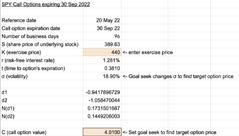

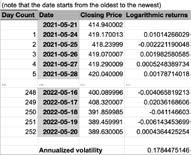
Thedetailedspreadsheetcontainingmycalculationsisinthe GoogleSheetlinkbelow: https://docs.google.com/spreadsheets/d/1 8CwUfFklZNCd 6nyynn6iTug1TH0T3ISeTITq8oZuRI/edit#gid=0
Withallmyvaluescomputedorgiven,Idownloadedand usedtheGoalSeekfunctiononGoogleSheetswhichissimilartothe.solve()functionontheTI-Nspirecalculator.Ienteredthevaluesandbegancomputingtheimpliedvolatilities—thatis,thevolatilitiesrequiredtoobtainthestated calloptionvalues.NotethatIhadtorepeatedlychangethe exercisepriceasmyresearchwaswithregardstothetrends ofvolatilityduetoexerciseprice.
2.3Observations&Analysisof“Trendsof VolatilityduetoExercisePrice”Graph Thereareseveralsignificanttakeawaysfromthe“trends ofvolatilityduetoexerciseprice”graph.
Theimpliedvolatilitystaysabovetheannualizedvolatilityforallthelistedexerciseprices.Impliedvolatilityis baseduponpresentvolatilitywhileannualizedvolatilityis baseduponthevolatilityofthepastyear-to-date.Therefore, thisobservationcanbeexplainedbythehighvolatilityof theAmericanmarketforthelastthreemonthsaftertheRussianinvasionofUkraineinFebruary.Thelowerannualized volatilityisanaverageofasignificantlylargerdatasetand thereforeislessaffectedbytherecenttrend.Inaddition,the impliedvolatilityatdifferentexercisepricesdoesnotfollowacleartrendthroughout,thoughitseemstobelargely decreasingafteritsinitialmaximumataroundthe$390exerciseprice.
Differentexercisepriceschangethevolatility.Basedon furtherresearchfromInvestopedia,thereisaconceptcalled volatilityskewwherein-the-moneyoptionshavehigherimpliedvolatilityvsout-of-the-moneycalloptions.Although mygraphlooksalittleskewed,Isuspectthatthedeviation isfromthecurrentmarketvolatility.

3Limitations
3.1AmericanvsEuropeanOptions
Onelimitationtomycalculationsoftheimpliedvolatility oftheSPYindexisthattheS&P500ETFindex(SPY)isan Americanoption,notaEuropeanoption.Thisissignificant becausethemathematicsbehindtheBlack-Scholesmodelis gearedtowardsthemorestraightforwardEuropeanoption.
WhileEuropeanoptionscanonlybeexercisedonthedayof expiry,Americanoptionscanbeexercisedonanydaybeforetheoptionexpires.IresearchedAmericanoptionpricingmodelsandfoundthattheBjerksund-Stenslandmodel isamodeloftenusedtopriceAmericanoptions,butfound thatthemathistoocomplexforthisdiscussion.
3.2Fat-tails
AnotherlimitationisthattheBlack-Scholesmodelhasa significantflawthatmayhaveimpactedourestimation.The Black-Scholesmodelassumesthatthedistributionoftheoptionvalueislognormal,butthisisnotnecessarilytrue.The modelfailstotakeintoaccountthepossibilityoffattails orkurtosisandBlackSwans,asuddenlargelyunforeseen changeinmarketconditionssuchasthe2007financialcrisis,meaningthatasuddenchangeinhowtheoptionprices aredistributedcanhaveadrasticimpactontheaccuracyof theoptionpricing.Thisisextremelysignificantasitcould causetheuseroftheBlack-Scholesmodeltohighlyundervalueorovervaluecertainoptions,causingtheusersignificantfinancialloss.
3.3HistoricalVolatilityvsCurrentVolatility
AnotherlimitationisthattheannualizedvolatilitythatI calculatedisevidentlynotagoodpredictorofthecurrent impliedvolatilityaccordingtomygraph.Thereasonbehind thedifferencebetweentheannualizedandimpliedvolatility canbeattributedtothehighlyvolatilemarketconditionsthat havebeencausedbytherecentFederalReserveinterestrate hikesandtheuncertaintyovertheRussia-Ukrainewar.Since theimpliedvolatility,whichisbasedonthelastfewmonths, isgreaterthantheannualizedvolatility,whichisbasedon thelastyear-to-date,itisevidentthatannualizedvolatility cannotberelieduponintheincreasingly-volatilemarketof today.
4Conclusion
Inconclusion,throughmyresearch,Ifoundthatthe Black-Scholesmodelisprimarilycomprisedofapresent valueadjustmentequationtakingintoaccounttheprobabilities d1 and d2 ,theprobabilitythattheoptionwillnotexpirein-the-moneyandtheprobabilitythattheoptionwillexpirein-the-moneyrespectively,plottedoveranormaldistribution graph N (d).Throughmyextensioninvestigatingtherelationshipbetweenannualizedvolatilityandimpliedvolatility oftheSPYETFoverthemonthofSeptember2022,Ifound thattheimpliedvolatilitywassignificantlygreaterthanthe annualizedvolatilitywhichcanbeattributedtothegreater volatilityinthepastfewmonthsduetotheuncertaintysurroundingreal-worldevents.Annualizedvolatilitymaynot beagoodpredictorofcurrentandfuturevolatility.
Throughmyresearchoffinancialderivatives,Inoticed thatitishighlydifficulttoderiveequationsthatadequately representtheuncertaintyinfinancialmarkets.Itisevident thateventheBlack-Scholesmodel,whichwonitscreators theNobelPrizeinEconomics,hasseveralsignificantlimitations.Forexample,themodelreliesonanassumption thatoptionpriceisrepresentedbylognormaldistribution
andthereforedoesnotaccountfortheoptionpricefollowingothertypesofdistributionmodelslikefat-tailorkurtosis distribution.
References
”DerivingtheBlack-ScholesEquation”(QuantStart,n.d.). Retrievedfrom
https://www.quantstart.com/articles/Deriving-the-BlackScholes-Equation/.
Hayes,A.(2022,April3).”WhatIstheBlack-Scholes Model?”Investopedia.
https://www.investopedia.com/terms/b/blackscholes.asp. Hayes,A.(2022,February8).”Volatility.”Investopedia. https://www.investopedia.com/terms/v/volatility.asp#tochow-to-calculate-volatility.
”HowtoCalculateHistoricalVolatilityinExcel” (Macroption,n.d.).Retrievedfrom https://www.macroption.com/historical-volatility-excel/. ”Ito’sLemma”(QuantStart,n.d.).Retrievedfrom https://www.quantstart.com/articles/Itos-Lemma/.
Louis(2019,October29).”TheBlackScholesModel Explained”TradeOptionsWithMe.
https://tradeoptionswithme.com/black-scholes-explained/. Nibley,B.(2021,June21).”TheBlack-ScholesModel, Explained.”SoFi.https://www.sofi.com/learn/content/whatis-the-black-scholes-model/.
”ResourceCenter”(U.S.DepartmentoftheTreasury,n.d.). Retrievedfromhttps://home.treasury.gov/resourcecenter/data-chart-center/interestrates/TextView?type=daily treasury yield curve&field tdr date value month=202205.
Turner,E.(2010).”TheBlack-ScholesModeland Extensions.”UniversityofChicago. http://www.math.uchicago.edu/may/VIGRE/VIGRE2010/REUPapers/Turner.pdf. Veisdal,J.(2021,December1).”TheBlack-Scholes Formula,Explained.”Cantor’sParadise. https://www.cantorsparadise.com/the-black-scholesformula-explained-9e05b7865d8a.
Countably and Uncountably Infinite Sets
Written by Benjamin CheongCountablyandUncountablyInfiniteSets
BenjaminCheong
cheong43465@sas.edu.sg
Abstract
Bornin1845,GermanmathematicianGeorgCantorwasa pioneerindevelopingsettheory—inspecific,infinitesettheory.Infinitesettheoryisabranchofmathematicsthatfocuses onstudyingthebehaviorofinfinitecollectionsofnumbers. Inthispaper,wewillestablishthatinfinityisaconceptand examinetheconclusionsCantordrewregardinginfinitesets, relatingtocountabilityandcardinality.Pleasenotethatthis paperwillnotbedescribingproofsinamathematicallyrigorousmanner,butwillratherbeexplaininginamoreeasy-tounderstandmanner.’
Keywords: settheory,infinity,Cantor’sdiagonalizationargument,cardinality,bijective,Cantor’stheorem
1InfinityisaConcept
Infinityonlyexistsasaconceptandhasfundamental flawswhenappliedasanumber.Whenwelaterdelve intoinfinitesets,itisimportanttoregardthatinfinityasa conceptaswell.First,let’sproveinfinitycan’tbeanumber.
1.Thecircumferenceof
Figure2:Twotangentsemicircleswithradius 1 2 linedup
Foursemi-circleswithradius 1 4 ?Thetotalcircumference


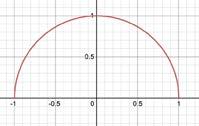
1 4
Eightsemi-circleswithradius 1 8 ?Sixteensemi-circles withradius 1 16 ?Asthenumberofsemi-circlesincreases,the totalcircumferenceremainsthesameat π .Yet,aninfinite numberofsemi-circleseachwithaninfinitelysmallradius wouldresemblealineinstead.Alinewhichis 2 unitslong.

Copyright©2023,AssociationfortheAdvancementofArtificial Intelligence(www.aaai.org).Allrightsreserved.
Therefore,wheninfinityisusedasanumber, π isequiv-
alentto 2.Since π cannotbeequivalentto 2,thereforeit followsthatinfinitycannotbeusedasanumber.Thelimit asthenumberofsemi-circlesapproachesinfinitydoesapproach 2,but,aswelearnincalculus,thelimitcanoftenbe differentfromtheactualanswer.
2.2CountabilityofIntegerSet
Doestheintegersetcorrespondone-to-onetothenatural set?Let’ssee.
Integers 0 1 -1 2
NaturalNumbers 1 2 3 4
Yes,itdoes!Tocorrespondeveryintegertoanaturalnumber,wehavetostartwithzeroandthengotothepositiveand negativeofeachfollowinginteger.Byworkingtobothpositiveandnegativeinfinity,wecancorrespondeverynatural numbertoexactlyonenumberintheintegerset.
2.3CountabilityofthePositiveRational NumbersSet
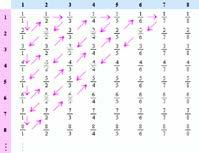
Doesthepositiverationalnumbersetcorrespondone-toonetothenaturalset?Let’ssee. RationalNumber
Forexample,intheabovegraph, f (x)= x2 ,for x =1, and f (x)=3 for x =1.Therefore, limx→1 f (x)=1, while f (1)=3.Therefore,thelimitisdifferentfrom theactualanswerwhenthegraphhasajumporpoint discontinuity.
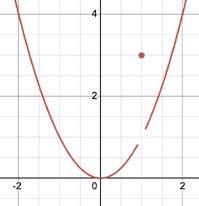
2CountablyandUncountablyInfiniteSets
Todeterminewhetheraninfinitesetiscountableoruncountable,wecanusebijection,amethoddevelopedby Cantor.Abijectionisaone-to-onecorrespondence.Ifthe infinitesetcancorrespondone-to-onetothenaturalset,the infinitesetiscountable.Ifitcannotcorrespondone-to-one tothenaturalset,theinfinitesetisuncountable.Pleasenote thatthenaturalsetofnumbersis {1,2,3,4,5,6,7,... }. Wewilllatershowthatanysubsetofacountablyinfinite set,suchasthenaturalset,andanuncountablyinfiniteset isalsocountablyinfiniteanduncountablyinfinite,respectively.Here,wewillassessthecountabilityofafewinfinite setsandexplainourreasoning.
2.1CountabilityofEvenIntegerSet
Doestheevenintegersetcorrespondone-to-onetothe naturalset?Let’ssee.
EvenIntegers 2 4 6 8
NaturalNumbers 1 2 3 4
Yes,itdoes!Everynaturalnumbercorrespondstoexactly onenumberintheevenintegerset.
Figure6:Allrationalnumbersasfractions
Yes,itdoes!Sinceallrationalnumberscanberepresented asafraction,wecancorrespondeverynumberinthepositiverationalnumbersettoanumberinthenaturalsetby employingadiagonalapproachshownabove.Theblueand pinknumbersrepresentthedenominatorandnumeratorof thenumberrespectively.Allrepeatednumbers(e.g 1 1 , 2 2 , 3
) areskipped.Nootherapproachwouldworkaswecannot gotoinfinityandcomeback(e.g1, 1 2 , 1 3 , 1 4 ,2, 2 3 , 2 5 ,... ). Pleasealsonotethatbyprovingthecountabilityofthepositiverationalnumbersset,wecaneasilyprovethecountabilityoftherationalnumberssetasawholebyaddingzeroin frontandaddinganegativenumberaftereachpositivenumber—similartowhatwedidfortheintegernumberset.All subsetsofcountablyinfinitesetsmustbecountablyinfinite themselvesbecausetheyareeitherfiniteoraremadeupof allthenumbersinanalreadyprovensetandthereforeshare thesamecharacteristics.
2.4CountabilityofRealNumberSet
Doestherealnumbersetcorrespondone-to-onetothe naturalset?Let’sthinkaboutit.
No,itdoesn’t.Thereisnowaytoestablishone-to-one correspondencebetweentherealnumbersetandthenatural set.Althoughitmayinitiallyseemliketheinfinitybetween arealnumbersetfrom [0, 1] shouldbethesameinfinityin apositiveintegerset,thisconclusionfailstoconsiderinfinitelyrepeatingnumberslike 1 3 .Thenumber 1 3 inthereal numbersetisnotrepresentedinthepositiveintegersetasit requiresinfinitedecimalsthatdonotexistinintegers.
Aclearerproofthattherealnumbersetisuncountablecan beshownbyCantor’sdiagonalargument.Cantor’sdiagonalargumentprovesthatarealnumbersetfrom [0, 1] is uncountable,thereforeprovingthatallrealnumbersetsare uncountable.Usingproofbycontradiction,firstassumethat theinfiniterealnumbersetiscountable.
therealnumbersareindeeduncountable.
Pleasenotethatthechangefrom0to1iscompletelyarbitrary.Aslongasyouaresomehowchangingeachofthe red-highlightednumbers,youcanproveCantor’sdiagonal argument.
2.5CountabilityofIrrationalNumberSet
Doestheirrationalnumbersetcorrespondone-to-oneto thenaturalset?Let’ssee.
No,itdoesn’t.Sincetheirrationalnumbersetisinfinite, wecanprovethatitisuncountableusingthesamelogicbehindCantor’sdiagonalizationargument.Pleasenotethatwe cannotstatethattheirrationalnumbersetisuncountablebecauseitisasubsetoftherealnumberset.Otherwise,we wouldbeabletostateafinite,definitelycountablesetwould beuncountable.Instead,wecanstatethattherealnumberset isuncountablebecausetheirrationalnumbersetisaswell. Foruncountablesets,thesubsetdeterminestheoverallset’s countability,nottheotherwayaround.
3CardinalityofInfiniteSets
Thecardinalityisthesizeofaset.Here,wewillbedeterminingthecardinalityoftheinfinitesetspreviouslydiscussed.
3.1CardinalityDefinitions
Definition1:AhasthesamecardinalityasBifthereisa bijectivefunctionbetweenthetwo.
Definition2:AhascardinalitylessthanBifthereis aninjectivefunctionfromAtoBbutnobijectivefunction. Notethatinjectivefunctionsareone-to-onefunctionswhere BmayhavemorepointsthatarenotmappedbyA.
Pleasealsonotethatabijectivefunctionisafunction thatisbothinjectiveandsurjective.Surjectivefunctionsare one-to-onefunctionswhereAmayhavemorepointsthat arenotmappedbyB.
Sinceweassumetheinfiniterealnumbersetiscountable,allrealnumbersshouldexistwithintheinfinitereal numberset.Thepictureaboveisaninfinitelistofinfinite digits.Lookatthered-highlightednumbersandthenlook attheblue-highlightednumbersatthebottom.Iftheredhighlightednumberis1,theblue-highlightednumberinits columnbecomes0.Ifthered-highlightednumberis0,the blue-highlightednumberinitscolumnbecomes1.Thebluehighlightednumbersatthebottomaredifferentfromany numberintheinfinitelist.Theyaredifferentfromthenumberinthefirstrowbythenumberinthefirstcolumn,differentfromthenumberinthesecondrowbythenumberinthe secondcolumn,differentfromthenumberinthethirdrow bythenumberinthethirdcolumn,andsoon.Therefore,the blue-highlightednumbersatthebottomaredifferentfrom allthenumbersintheinfinitelistandyetshouldexistasa numberintheinfinitelist.Suchacontradictionprovesthat
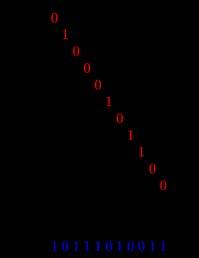
Definition1-CardinalityofCountablyInfiniteSets: Twosetshavethesamecardinalityifthereisabijection betweenthetwo.Sincecountablyinfinitesetsmusthavea bijectionorone-to-onecorrespondencetothenaturalsetto becountable,itfollowsthatallcountablyinfinitesetshave thesamecardinalityasthenaturalsetandeachother.
Definition2-CardinalityofUncountablyInfinite Sets: Thecardinalityofuncountablyinfinitesetsismuch moreinteresting.Countablyinfinitesetshavecardinality lessthanuncountablyinfinitesets.Thereisaninjective functionfromthenaturalsettotherealnumbersetbecause thenaturalsetisasubsetintherealnumberset.Thereal numbersethasintegers,ofwhichthepositivebelongto thenaturalset,anddecimals.Thereisnobijectivefunction fromonetotheothersetbecausethenaturalsetiscountable andtherealnumbersetisuncountable.
4Conclusion
Inconclusion,thispaperhasprovidedaclearintroduction tocountablyanduncountablyinfinitesets.Webeganbyex-
plainingwhyinfinityonlyexistsasaconceptandnotanumber.Next,weexplainedhowonemightdeterminewhether infinitesetsarecountableoruncountableusingbijection,a methoddevisedbyGeorgCantor.Finally,weexaminedthe cardinalityofcountablyanduncountablyinfinitesets.
References
N/A.
Introduction to Chaos Theory: History Examples, Applications
Written by Sunghan Billy ParkIntroductiontoChaosTheory:HistoryExamples,Applications
Sunghan(Billy)Park
park44253@sas.edu.sg
TeacherReviewer: Ms.Poluan
Abstract
Chaostheoryisabranchofmathematicsthatdealswiththe studyofdynamicsystemsandtheirseeminglyrandombehavior.Inthisresearchpaper,weaimtoprovideacomprehensive overviewofchaostheory,coveringitskeyconceptsandexamples,aswellasitsapplicationsinvariousfields.Webeginbydiscussingthehistoryanddevelopmentofchaostheory,includingthepioneeringworkoffiguressuchasHenri Poincar ´ eandEdwardLorenz.Wethendelveintosomeexamplesofchaostheory,suchasthedoublependulumand Newton’sthree-bodyproblem.Finally,weexploresomeof thereal-worldapplicationsofchaostheory,includingitsuse inpredictingweatherpatternsandunderstandingbiological systems.Overall,thisresearchpaperaimstoprovideacomprehensiveandaccessibleintroductiontochaostheoryfor studentsandresearchersinterestedinthisfascinatingandimportantfield.
Keywords: Butterflyeffect,Doublependulum,Newton’s three-bodyproblem
1IntroductionandHistory
Chaostheoryisdefinedasthebranchofmathematicsthat dealswithcomplexsystemswhosebehaviorishighlysensitivetoslightchangesininitialconditions,sothatsmall alterationscangiverisetostrikinglygreatconsequences. ChaostheoryhasitsrootsintheworkofHenriPoincar ´ e, aFrenchmathematicianwhostudiedthestabilityofthesolarsysteminthelate19thcentury.PonderinguponNewton’sthree-bodyproblem,Poincar ´ ediscoveredthattheorbitsofcelestialbodieswerenotaspredictableaspreviously thought,andthatsmallvariationsininitialconditionscould leadtosignificantdifferencesinthelong-termbehaviorof thesystem.
However,itwasnotuntilthe1960sthatchaostheorywas fullydevelopedandrecognizedasadistinctfieldofmathematics.Thedevelopmentofchaostheorycanbeattributed toEdwardLorenz,amathematicianandmeteorologistatthe MassachusettsInstituteofTechnology.Lorenzwasstudyingthebehaviorofweatherpatternsusingcomputersimulations,whenin1961heinadvertentlydiscoveredaninterestingphenomenon.Hewasrunningsimulationsoftwelve weathervariablesusingacomputermodel,buttosavetime, hestartedhalfwaythroughaprevioussimulation.Tohissurprise,hefoundthattheresultswerecompletelydifferent.He
thenrealizedthatthenumbersheusedthistimeweretruncatedtothreedecimalplaces,whiletheprevioussimulation usedsix.Thissmall,seeminglyinsignificantdifferencewas amplified,resultinginacompletelydifferentoutcome.This phenomenon,coinedthe“butterflyeffect”byLorenz(based onthemetaphorthatabutterflyflappingitswingsinBrazil couldcauseatornadoinTexas),becamethecornerstoneof chaostheory.
2Examples
2.1TheDoublePendulum
Oneofthemostnotableexamplesofchaostheoryin actionisthedoublependulum.Thenameisratherselfexplanatory;itisessentiallytwopendulumsconnectedto eachotherwhichcanbespunalonganaxis.Thedoublependulumisquiteunique,solelybecauseofitshighsensitivity toinitialconditions—acommontrendwithinchaostheory.
Asseenabove,droppingthependulumfrom100.00degrees,100.01degrees,and99.9degreeswouldlooksimilar atfirst,buttheirpathswoulddivergedrasticallyovertime.In additiontothis,theslightdifferencesofairpressure,gravity,temperature,andotherminisculedifferenceswouldalso haveanimpact;infact,itissaidthedoublependulumisso sensitivethatthegravitationalattractionofanearbyhuman couldaffectitscourse.
2.2Newton’sThree-BodyProblem
Anotherwell-knownexampleofNewton’sthree-body probleminorbitalmechanics.Thediscoveryofthishypotheticalproblemdatesbackto1687,wherenamesakeas-

tronomerIssacNewtonquestionedwhetherlong-termstabilityispossible—particularlythesystemcomprisingthe Earth,theSun,andtheMoon—inhisbook PrincipiaMathematica.
Theproblemconsistsofthreecelestialobjectsmoving aroundeachother,andthegoalistofindaclosed-formsolutiontopredictthecourseofthesethreeobjects.However, thesmallestdiscrepancies,suchasaslightdifferenceofdistance,canleadtochaosandrandomness.Interestingly,there areafewspecial-casesolutionstothethree-bodyproblem, suchasthefigure-eightsolution(wherethethreebodiesorbiteachotherinafigure-eight)ortheelasticsolution(where thethreebodiesorbiteachotherelastically).
Finally,amoretheoreticalbutinterestingexampleof chaostheoryliesintherealmofapopularconceptfantasized forcenturies:timetravel.Theoretically,ifonewereableto travelbackintimeandmakeasmallalteration,itcouldresultinsignificantchangesinthefuture.Forinstance,imaginegoingbackintimeandstrikingupaconversationwith apasserby.Thispersonwasontheirwaytoadineracross thestreet,andthisshortconversationcausesadelayoften seconds.Becauseofthisdelay,asthepersoniscrossingthe street,heishitbyacarthatwouldhavemissedhimifit wasn’tforthedelaycausedbytheconversation.Thisperson turnsouttobeRobertOppenheimer,themanwhowould latergoontocreatetheatomicbombduringWorldWarII. Asaresult,theUnitedStatesfallsbehindwhiletheAxisdevelopstheirownatomicbombanddefeatstheAllies.Inthis example,aseeminglyinsignificantconversationhasdrasticallychangedthecourseofhistory.However,onedoesnot havetoworryaboutthisastimetravelisnotareality...yet.
3Applications
Theapplicationsofchaostheoryarenotlimitedtorather mundanescenariosofpendulumsorbutterflies;rather,these applicationsarefar-reachingandplayapartinmeteorology, biology,socialscience,andevenbusiness.


AsmentionedbeforewithLorenz,chaostheoryisalso usedinpredictingweatherconditions,whereobservations thatareself-similarinregionshelpreducetheuncertainty posedbytheinitialweatherconditions,therebyreducing errors.Thisiswhywecanpredicttheweathermanydays inadvancewithconfidence—ahugeimprovementfrombefore.
Inbiology,chaostheoryhasplayedapartinpopulation dynamics,whichinvolvesunderstandinghowpopulationsof organismschangeovertime.Thiscanincludefactorssuchas birthanddeathrates,migration,andotherinfluences.Chaos theoryhasbeenusedtomodelthedynamicsofpopulations ofanimals,plants,andotherorganisms,andhashelpedto explainhowsmallchangesininitialconditionscanleadto largechangesinpopulationsizeovertime.Infact,chaos theoryhasevenbeenappliedbybiologiststounderstandand explainthespreadoftheCOVID-19virus.
Chaostheoryhasevenbeenappliedtoconceptsinthe socialsciencesrangingfrompoliticstopsychology.Specifically,forpolitics,chaostheoryhasbeenusedtostudythe factorsthatcontributetopoliticalinstability,suchaseconomiccrises,socialunrest,andchangesinleadership.Researchershaveusedchaoticmodelstoidentifytheconditionsthataremostlikelytoleadtoregimechangeandto predictthelikelihoodofsuchchangesoccurringindifferent countries.Forpsychology,ithasbeenusedtostudythefactorsthatinfluencedecision-makinginsocialgroups,suchas theroleofleadershipandgroupdynamics.Forexample,researchershaveusedchaoticmodelstostudyhowgroupsize andcompositioncanimpactdecision-makingandtoidentify theconditionsthataremostlikelytoleadtogroupconsensus.Chaostheoryhasalsobeenappliedinmentalhealth: itisusedtostudythedynamicsofmentalhealthdisorders, suchasdepressionandbipolardisorder.Researchershave usedchaoticmodelstodeveloppredictionsaboutthelikelihoodofrelapseinpatientsandtoidentifythefactorsthat contributetotheemergenceofthesedisorders.
Finally,intermsofbusinessandthestockmarket,chaos theorycanexplaintoinvestorswhyhealthyfinancialmarketscansuffercrashesandshocks.Byusingchaoticdynamics,investorscananalyzethemovementsofpricesandidentifypatternsthatmaynotbeimmediatelyapparent.
4Conclusion
Inconclusion,chaostheoryisafascinatingandcomplex fieldofstudythathasrevolutionizedourunderstandingof theworldaroundus.FirstdiscoveredbymeteorologistEdwardLorenz,itdealswiththebehaviorofdynamicsystems thatarehighlysensitivetoinitialconditions,oftenreferred toasthebutterflyeffect.Someexamplesofchaostheory includethedoublependulum,Newton’sthree-bodyproblem,andeventimetravel,whilethereal-worldapplications ofchaostheoryincludepredictingweatherpatterns,under-
standingbiologicalsystems,andmodelingstockmarkets.
Overall,chaostheoryoffersanewperspectiveonunderstandingcomplexsystemsandphenomenathatwerepreviouslythoughttobeunpredictable.Ithastransformedour understandingoftheworldaroundusandcontinuestobea valuabletoolinavariousfields.
References
Butterflies,Tornadoes,andTimeTravel.AmericanPhysical Society.(2004).RetrievedJanuary8,2023,from https://www.aps.org/publications/apsnews/200406/butterflyeffect.cfm
Halton,C.(2023,January2). Chaostheorydefinition. Investopedia.RetrievedJanuary8,2023,from https://www.investopedia.com/terms/c/chaostheory.asp:
standingbiologicalsystems,andmodelingstockmarkets. Overall,chaostheoryoffersanewperspectiveonunderstandingcomplexsystemsandphenomenathatwerepreviouslythoughttobeunpredictable.Ithastransformedour understandingoftheworldaroundusandcontinuestobea valuabletoolinavariousfields.
:text=Chaos%20Theory%20in%20the%20Stock%20Ma rket,-Chaos%20theory%20isamp;text=Proponents%20o f%20chaos%20theory%20believe,true%20health%20of %20the%20market.
Mangiarottietal.(2020).Chaostheoryappliedtothe outbreakofCOVID-19:anancillaryapproachtodecision makinginpandemiccontext. EpidemiologyandInfection, 148.https://doi.org/10.1017/s0950268820000990
References
Butterflies,Tornadoes,andTimeTravel.AmericanPhysical Society.(2004).RetrievedJanuary8,2023,from https://www.aps.org/publications/apsnews/200406/butterflyeffect.cfm
Oestreicher,C.(2022). Ahistoryofchaostheory.Taylor& Francis.RetrievedJanuary8,2023,from doi.org/10.31887/DCNS.2007.9.3/coestreicher WikimediaFoundation.(2022,December31). Three-body problem.Wikipedia.RetrievedJanuary8,2023,from https://en.wikipedia.org/wiki/Three-body problem WikimediaFoundation.(2022,November14). Double pendulum.Wikipedia.RetrievedJanuary8,2023,from https://en.wikipedia.org/wiki/Double pendulum
Halton,C.(2023,January2). Chaostheorydefinition Investopedia.RetrievedJanuary8,2023,from https://www.investopedia.com/terms/c/chaostheory.asp: :text=Chaos%20Theory%20in%20the%20Stock%20Ma rket,-Chaos%20theory%20isamp;text=Proponents%20o f%20chaos%20theory%20believe,true%20health%20of %20the%20market.
Mangiarottietal.(2020).Chaostheoryappliedtothe outbreakofCOVID-19:anancillaryapproachtodecision makinginpandemiccontext. EpidemiologyandInfection, 148.https://doi.org/10.1017/s0950268820000990 Oestreicher,C.(2022). Ahistoryofchaostheory.Taylor& Francis.RetrievedJanuary8,2023,from doi.org/10.31887/DCNS.2007.9.3/coestreicher WikimediaFoundation.(2022,December31). Three-body problem.Wikipedia.RetrievedJanuary8,2023,from https://en.wikipedia.org/wiki/Three-body problem WikimediaFoundation.(2022,November14). Double pendulum.Wikipedia.RetrievedJanuary8,2023,from https://en.wikipedia.org/wiki/Double pendulum
07 Investigating the Theoretical and Practical Applications of Fractals
Written by Doy yun, Munira TakalkarInvestigatingtheTheoreticalandPracticalApplicationsofFractals
DoyYunMuniraTakalkar
yun45629@sas.edu.sg,takalkar42662@sas.edu.sg
TeacherReviewer: Ms.Poluan
Abstract
Abstract
Fractalsarefascinatinggeometricalfiguresthatappearintricateandcomplex,butareactuallymadeupofsmallrepeatingpatterns.Theycanbefoundinvariousnaturalandmanmadestructures,suchassnowflakes,coastlines,andAfrican designs.Thispaperexploresthedifferentdimensionsthatdistinguishfractals,highlightssomenotablemathematicalexamples,andshowcasesthepracticalapplicationsoffractals inourworld.Bycompilingvariousarticlesontheusesof fractals,itisevidentthattheyhaveenormouspotentialfor improvingourunderstandingofpatternsandprovidingmore efficientwaysofstudyingthem.Fractalsareavastandexcitingfieldthatisyettobefullyexplored,andtheirapplications areendless.Bydelvingintotheworldoffractals,wecangain anewappreciationforthebeautyandcomplexityofournaturalworld,andperhapsevendiscovernewwaysofsolving practicalproblems.
Keywords: fractals,Hausdorffdimension,Minkowski–Bouliganddimension,Mandelbrotset,Newton’sfractal
1Introduction
1.1BackgroundandPurposeofResearch
Thispaperinvestigatesboththetheoreticalandpractical applicationsoffractals,providinganaccessibleunderstandingofseeminglyabstractandinfiniteconcepts.Conceptualizedbythefatheroffractalgeometry,BenoitMandelbrot, withtheintentionofmodelingnature,fractalsareutilized toreflectamyriadofnaturalandchaoticprocesses,ranging fromgalaxyformationtocancergrowthatacellularlevel.
Tomodelthesenaturalphenomena,theideaoffractalsas self-similargeometricfiguresemerged,signifyingthateach componentregardlessofmagnitudehasthesamestatisticalpropertiesasthewhole.Suchfiguresprovideabasisto modelthecomplexity,yetregularity,ofcertainformsofvariety.Fractalgeometrycapturesthejaggednatureoffigures, andasonezoomsintoafractal,itappearstosmoothout.As partsofthispaperdelveintoabstractandtheoreticalideas, itisessentiallytokeeptheinitialintentoffractalsinmind: tomodelreality.Thus,theneedlessidealizationofperfectly self-similarfigurescontradictsfractalgeometryjustasmuch asthediametricoppositionofperfectlysmoothfigures.
2FractalDimension
Oneofthekeycharacteristicsofafractalisitspossessionofafractaldimensionexceedingitsintegertopologicaldimension(Albertovich&Aleksandrovna).Integerdimensionscanbeobservedwithtwo-dimensionalandthreedimensionalfigures;however,whilefractionaldimensions alignwithsimilarconcepts,theydifferfromstandarddimensionspresentinEuclideangeometry(Ross).
2.1HausdorffDimension
Fractalsfoundinmathematicscanbeexpressedinboth algebraicandgeometricmanners.Themostcommonmathematicaldefinition,andthedefiningfactorofafractal,isthe presenceofself-similarityinapattern(Ross).Self-similarity isnottheonlyclassificationofafractal,however.Selfsimilarfractalsarerepeatedinternally,meaningthatwhen thepatternisenlarged,thesameimageiscreatedatasmaller scale.Essentially,suchfiguresaremadeupofsmallerversionsofthemselves(Bishop).
Thescaleofthisrepetition,calledfractaldimension,falls alongthesamescaleastraditionaldimensionswithinEuclideanspace(Albertovich&Aleksandrovna).Ingeometry,alineisconsideredone-dimensional,asquareistwodimensional,andacubeisthree-dimensional.Wheneachof theseisseparatedtoproduceself-similarobjects,thescaleat whichthelength,area,orvolume–whichcanbereferredto asmagnitude–decreasesis 1 2 , 1 4 ,and 1 8 ,respectively,while thescalefactorofasidelengthremains 1 2 .Thedimensionof thesegeometricalfigurescanthereforebethoughtofasany givenpowerrequiredtoraisethescalefactorofasidelength suchthatitisequaltothescaledmagnitude.Settingthemagnitudeat M andscalefactorat s,therelationcanbedefined as M = sD ,with D definedasthefigure’sHausdorffdimension(Albertovich&Aleksandrovna).Given M and s, D can easilybefoundthroughtheequation D =log s M = log M log s
ReturningtotheinitialexamplesusingstandardgeometricalfigurespresentinEuclideanspace,intheline’scase, whenscaledbyafactorof 1 2 ,themagnitudebecomes 1 2 of theoriginal,resultinginadimensionof1,as 1 2 =( 1 2 )1 Lookingatthesquare,whenthelengthisscaledbythesame factorof 1 2 ,themagnitudeis 1 4 oftheinitialfigure’s,resultinginadimensionof2,as 1 4 =( 1 2 )2 .Thisrelationremains constantacrossfiguresofvaryingdimensions(Ross).
Thisevolveddefinitionofdimensioncanbeextendedto fractalfigures.TakingtheSierpinskitriangleforinstance, thescaleofself-similarityis 1 3 oftheoriginalsize,meaningthatwhenasidelengthisscaledby 1 2 ,themagnitude isscaledby 1 3 ,formingtheequation 1 3 =( 1 2 )D ,where D equalsapproximately1.585(Bishop).Inlayman’sterms, theHausdorffdimensionofafigureisessentiallyameasure ofirregularity,withanincreaseddimensionindicatingincreasedroughness.Asthefractalincreasesincomplexity, thedimensionheightens.
3CorrelationDimension
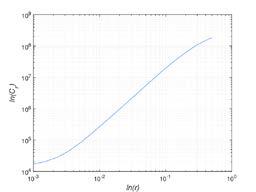
Beneficialtothemeasuringofroughnessinadatasetis anunderstandingoftheset’sdensity,accomplishedthrough thecalculationofitscorrelationdimension,wherebyballs ofradius ε areplacedcenteredatapoint x ofapointcloud and Nx (ε) representsthenumberofpointswithintheball (Ross).Theradiusisthenvaried,with Nx (ε) ∝ εd ,and theaveragevalueof Nx (ε) isfoundovervariouspointsto find C (ε),whichisalsoproportionalto εd .Toestimate d graphically,thegraphof ln(C ) and ln(ε) isplotted,andthe slopeofthecurveistakenasthedimension(Bishop).This excludestheleftmostandrightmostsidesofthecurve,as theseflattenduetobeingtoosmalltoreachotherpointsand engulfingtheentireset,respectively.
fractaldimensionofaset S inametricspace (X,d) (Albertovich&Aleksandrovna).Thisdimensionisinmanycases equivalenttoafigure’sHausdorffdimension,thoughincertainsetstheMinkowskidimensionexceedstheHausdorff dimension,suchasinthesetofrationalpointsbetween[0,1], wheretheyare1and0,respectively.However,itconsistently differsfromafigure’scorrelationdimension,asitdoesnot takeintoaccountthedensityofaset(Bishop).
Inordertocomputethisdimensionalvalue,boxesofside lengtharecreatedalongtheset,with N (ε) representingthe totalboxesthatcomeincontactwiththedata.Givenacurve oflength L,itcanbefoundthat N (ε) ∝ L ε (ross).Continuing,givenaplaneofarea A, N (ε) ∝ A ε2 ,andgivenathreedimensionaldatasetofvolume V , N (ε) ∝ V ε3 .Itcanthereforebeconcludedthat N (ε) ∝ 1 εd .Inordertoachievethe mostaccuratedimension, ε mustbereduced,producingthe equation d =limε→0 lnN (ε) ln( 1 ε ) (ifthelimitexists).However, thisdefinitionbeginstodeterioratewhenfiguressuchasthe Sierpinskitrianglecomeintoplay,consideringtheconsensusonitsareaismurkyatbest(Ross).Insuchinstances, log N (ε) isplottedagainst log 1 ε ,withitsslopetakenasthe dimension.
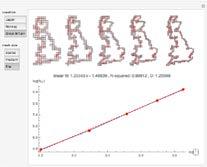
3.2CoastlineApplications
Growntobecomealmostsynonymouswithfractaldimensions,thecoastlineparadoxpresentsthequestionof howtocalculateinformationregardingacoastline,consideringitdoesnothaveaclearlydefinedlength,resultingfromridgesandinconsistenciesthatonlycompoundas thefieldofviewnarrows(Bishop).Coastlinelengthsvary greatly,therefore,basedonthescaleofmeasurement,eventuallyapproachinginfinity.Takingintoaccountacoastline’s shape–neithertrulyself-similar,noraprimitiveshape–the Minkowski–Bouliganddimensionisthemosteffectivedimensiontodetermineacoastline’sfractaldimension.
(Arshadetal.,2021)
3.1Minkowski–BouligandDimension
Whilecomputingafigure’sfractaldimensionusingHausdorffdimensionmaybedirectregardingsimpleorself-similarshapes,asEuclideanobjectsbecome morecomplex,itbecomesmoreeffectualtofindtheir Minkowski–Bouliganddimension,asubsetoffractaldimension.Minkowski–Bouliganddimension,additionallyknown asbox-countingdimension,isamannerofdeterminingthe
Throughtheslopeofthelineofbestfit,itisapparentthat thecoastlineofBritain’sfractaldimensionisapproximately
1.25,actingasaquantitativeindexofthecomplexityofthe region’scoastline,comparabletoothers.
4MathematicalExamplesofFractals
Fractalsarewhatareknowntobenever-endingpatterns, beinginfinitelycomplexandjagged.Thoughself-similarity isn’tnecessarilyarequisiteforfractals,duetotheiterative natureoffractalcreation,self-similarityinmathematicalexamplesiswidespread.

4.1DragonCurve
Dragoncurvesaredefinedasanymemberofafamilyof self-similarfractals,approximatedbyarecursivesystemof alternatingdirections,resultinginafractalresemblingthe shapeofthemythicalcreature.FirstinvestigatedbyNASA physicistsJohnHeighway,BruceBanks,andWilliamHarter,theHeighwaydragoncurveisarguablythemostprominentdragoncurve(Albertovich&Aleksandrovna.Starting fromasingleline,thecurveisconstructedbyaniterative processofthelinesplittingintotwoperpendicularsmaller linesandforminganisoscelestrianglewiththeoriginalline. Witheachiteration,thedirectionofthesplitalternatedbetweenrightandleft,creatingthecurve.Anothermethodin constructingthisshapeistopickapivotpoint,eitheronthe farleftorright,copytheoriginalfigure,androtateit90degrees,alternatingrightandleft.Afterundergoingjustseveraliterations,thedragoncurveisformed.Asthisparticular fractalrequiresarecursivesequenceofconstantcopyingand pasting,itisconsideredtobeaself-similarshape,withfractaldimension,orthedimensionalvalueforself-similarity, beingaround1.5236.
Davinchi.Thefractaldimensionofthisfractalisthegolden ratio,or1.618033.Asseenbythecomparison,thefractal dimensionofthegoldendragonfractalismoresimilarto thatoftheHeighwaydragonthantheTerdragon,thus,the shapeofthegoldendragonisalsomorealiketotheHeighwaydragon.However,insteadofutilizingaperfectlyperpendicularbisectingiterativesequence,theconstructionof thegoldendragonreliespredominantlyonthesidelengths ofthetwolinesegments(Albertovich&Aleksandrovna). Theratiobetweenthetwosidelengthsis r ,with r being definedas (1/Φ)( 1/Φ).Witheachiteration,thesidessplit intoevenmoreintricatesegments,alternatingrightandleft, maintainingthesameratio.Theresultantdragonfigureisa beautifulcurveofintricatedetail.
Thoughthedragoncurvesthemselvesdonothavemuch useinthedevelopmentofourknowledgeinanyfield,it demonstratestheideaofhowasimplecode,undermany iterations,canbecomecomplexandlarge.
4.2JuliaSet
DiscoveredbytherenownedFrenchmathematician,GastonJulia,theJuliasetisoneofthemostcrucialexamples ofamathematicalfractalwhenitcomestothefieldofcomplexdynamics(Bishop).TheJuliaset,alongwiththeFatouset,arecomplementarysetsdefinedbyuniquefunctions,withasetpointandconstanttoproduceafractal. FatousetsandJuliasetsaresimilarintheiriterationprocesses;however,theFatousetconsistsofnumericalvalues thatbehavesimilarlyevenwhenundergoingmultipleiterations,whereastheJuliasetconsistsofnumericalvaluesthat behavechaoticallywhenchanged,evenintheslightestquantity.Juliasetscanbecreatedusingavarietyofformulas, thoughthemostwidelyknownisthequadraticfunctiondefinedby w = z 2 + C .Themostsignificantfactorineach set’sdifferencearetheinitialvaluesof Z and C ,astheiterationprocessremainsconstant(Albertovich&Aleksandrovna).Boththevaluesof Z and C arecomplexnumbers, consistingofarealandimaginarypart,thusresultinginthe set’spositiononthecomplexplaneasopposedtothestandardCartesianplane.
Severallesser-knownversionsofthedragoncurveare alsopresent,suchasthetwindragon,terdragon,andgolden dragon.Thetwindragon,simplyput,istwoHeighwaydragonsplacedbacktoback,withoneofthedragonsrotated180 degrees.Theterdragonisamoreelaborateversionofthe Heighwaydragon;asopposedtobisectingtheinitiallineto form90-degreeangles,theterdragontrisectsandforms120degreeangles,resemblingasidewaysZ.Thedimensionfor self-similarityislessthanthatoftheHeighwaydragon,approximatelyat1.26186(Ross).
TheGoldenDragonfractalisonethatiscloselyrelated tothatoftheGoldenRatio,firstdiscoveredbyLeonardo
Thoughthevalueof Z consistentlyrepresentsthepoint ofinterest,andthevalueofCrepresentsasaconstant,the multitudeofcombinationsofthesevaluesallowsforaninfinitenumberofJuliasets.IneachJuliaset,the“fate”ofeach complexnumber Z isevaluated(Bishop).Inotherwords, whether,asitisintegrated,thenumberconvergesordiverges.Theresultantisamyriadofdifferentshapes,each visuallyrepresentedbyblackareasandvariedcolors.The blackregionsindicatepointswherethenumbersconverge orstaybetweenaboundedregionastheyundergoiterations. Thecoloredregions,ontheotherhand,representthecomplexnumbersof Z thatdiverge,withthechromaticityindicatingthespeedatwhichthenumbertendstowardinfinity (Ross).
4.3TheMandelbrotSet
StemmingfromtherevelationofJuliasets,theMandelbrotsetwascreatedbyBenoitMandelbrot,utilizingthe
samequadraticfunction, w = z 2 + C .Asopposedtothe Juliasets,however,theMandelbrotsetonlyhasasingular variabilityfactor, C ,andalwayssetstheinitialvalueof Z tozero(ross).Duetothis,theresultantisasingularimage, whichcanbeinterpretedasavisualrepresentationofallthe quadraticfunctionedJuliasets.
ItwasdiscoveredthatforanyJuliaset,thepoint(0,0) onthecomplexplanedeterminesthefateoftheset,ifthe pointisconnected,orshadedblack,thentheentiresetis connected;however,ifthepointisdisconnected,orcolored, thentheentiresetisinfinitelydisconnected(Albertovich& Aleksandrovna).Duetothis,bycompilingtheoriginsof eachJuliasetattheoriginpoint,theresultantimageofthe Mandelbrotsetvisuallyrepresentsthebehaviorofallthe complex C valuesintheJuliaset,eachpointrepresentinga uniqueJuliaset(Bishop).IfaJuliasetwithapairofspecific valuesfortheirvariablesdoesn’tdivergetoinfinitywheniterated,thecorrespondingpointisshadedblack.Conversely, if,underiteration,theJuliasetescapestoinfinity,thepoint iscolored,withthedifferenthuesrepresentingtherateat whichthecomplex C -valuesdivergetoinfinity.
simplyutilizingelementaryrules.
4.4NewtonFractals
Newtonfractalsarefractalsthathavebeenmadeusingthe generalizedformofNewton’siteration.Contrarytobelief, IsaacNewtonwasnotthecreatorofthisparticularfractalseries,andonthecontrary,wasn’tawareofitsexistence.Newton’siterationisundoubtedlyaconceptthatiswell-knownin thecalculuscommunity,usingderivativestoobtainaclose approximationoftheroot(s)ofafunction.Theiteration, alsoknownastheNewton-Raphsonmethod,isusuallyinthe generalformof x(n +1)= x(n) [f (x)/f ′ (x)],utilizing tangentlinesslopesasawaytoapproximate(Albertovich& Aleksandrovna).Pickingastartingpointclosetothatofthe approximationvalueleadstoalmostasuddenconvergence totheroot(s);however,whenthestartingapproximationis inaccurateandhasahigherrorbound,aninterestingphenomenonoccurs.Inthecontextofcalculus,theinitialapproximatevalueistypicallypickedwithintherealmsofreal numbers,butforNewton’sfractals,thisboundisexpanded toimaginarynumbers,andmainlyemployscomplexnumbers.
Newton’sFractalsareaspecialcaseofJuliasets,withintricatedetailsarisingfromsimplefunctionsduetotherepetitionofinteractivesequences.TheoutcomeofNewton’s fractalsishighlydependentonthestartingpointandcandiffergreatlyfromoneanother,despitethestartingpointyieldingsuchaminusculechange(Bishop).SimilartotheMandelbrotset,Newton’sfractalsaresetinthecomplexplane andcanberepresentedasamapofallthepossiblestarting valuesoftheapproximation.Undergoingmultipleiterations, whicheverrootvalueeachpointendsupwithisthecolorthat isassigned,andwhenthepointisplacedbackintoitsoriginalposition,Newton’sfractalisformed(Ross).Thefractal shapecanchangedramaticallybasedontheinitialfunction conditions,andthenumberofiterationsundergonecanenlargethedetailswithineachfractal.
TheoutlineoftheMandelbrotsetconsistsofamaincardioidshape,andasmallercircularshapewithconverging blackregionsoneitherside.Thesetwofiguresarewithin thex-valueboundariesof-2and0.25,ofwhichthereare C -valuestowhichtheJuliasetisconnected.Thecardioid shaperepresentsthevaluesofanattractivefixingpointof theJuliasets,ofwhicharebetweentheboundsof-0.75to 0.25(Ross).Thecircularshaperepresentsthevaluesofbehavinginadifferentmannerandissituatedwithin-1.25and -0.75.Theothervaluesareunabletoescapetowardinfinity,despiteconstantiterations;however,theydonotfallinto eithercriterionofbehavior.
TheMandelbrotsetitselfposesseveralinterestingphenomenons,includingmanyoftheJuliasetsthemselvesbeingembeddedintothemappingoftheMandelbrotset.InfinitelymanyJuliasetsofavarietyofshapesandsizescan befoundwithinallareasoftheMandelbrotset.Furthermore,asignificantlyscaled-downfigureoftheMandelbrot setcanbefoundcenteredaroundeachoftherespectiveJulia sets(Bishop).Takingtheroleofoneofthemorecelebrated mathematicalfractals,theMandelbrotsetisanexcellentexampleoftheideaofacomplexstructurebeingproduced
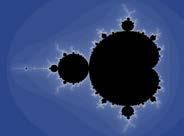
4.5TheFibonacciSequence
Anadditionalmathematicalexampleofafractalisthe Fibonaccisequence,thelessrenownedcounterpartofthe goldenratio.Thisparticularfractal,however,isunlikethat ofthepreviouslyexploredfractalsinthispaperandcan beclassifiedasanarithmeticfractalratherthanageometricfractal.NamedafterLeonardodaVinci’spenname, Fibonacci,theFibonacciSequenceisauniquepatternof whichisdefinedbytherecursiverulesof xn = xn 1 + xn 2
.Setting x0 at0and x1 at1allowsforthesequenceto emergeasthefollowing:0,1,1,2,3,5,8,13,21,34....
Thegoldenratioemergesfromthesenumbers;asthesequencecontinuesontoinfinity,theratiobetween xn and xn 1 becomescloserandclosertowhatwenowdefineas thegoldenratio,orabout1.618.Usingthisratio,DaVinci wasabletofigureoutthenthtermoftheFibonaccisequences,proventobe xn =(Φn (1 Φ)n )/√5.Within hisexploration,however,DaVincifoundthatsquaringthe numberswithintheFibonaccisequenceallowedforaperfectlyfittedarrangementofsquares,which,whenconnected,
becameaperfectspiral,translatingintothebasicofdivine proportions–thegoldenspiral.
5ApplicationofFractals
Thoughfractalswereinitiallyamoretheoreticaldiscovery,theyhavesincebeenfoundapplicableinvariousaspects ofourlives,inbothnaturalandindustrialsettings.With theirinitialfindings,fractalshavebeenproventruetobean incrediblyvaluabletoolinsynthesizingandanalyzingpatterns,evenwhenitisn’tblatantlyobvious.Usingthistool hasallowedforvariousadvancementsinthefieldofbiology,computerscience,andmedicine,andwillcontinueto assistinmakinggroundbreakingdiscoveries.
5.1FractalsinNature
Fractals,despitetheirbasisbeingmathematical,are presenteverywhereinnature.Fromthephysicalshapeof naturalfigures,totheformationoftheirgrowingpatterns, fractalsarehighlyprevalentinanalyzingnature’spatterns.
TheFibonaccisequence,duetoitsrecursiveruleofhavingthesumofthetwoprevioustermsbethenext,has thevaluablecharacteristicofspaceefficiency—atoolthat greatlyassistsineffectivelyutilizingthespaceprovided(Albertovich&Aleksandrovna).Consequently,treebranches, lightning,waterfalls,andevenorganisms’reproductionpatternsmimicthesequenceofFibonacci,allowingforexpansionwithefficientusageofspace.Furthermore,onaccount ofthegoldenratiobeingaprinciplelawpertainingtonatural figures,thegoldenspiralcanbefoundtranslatedintonature, suchasintheshapesofseashellsorthegalaxyitself.
TheJuliasetsembeddedintotheMandelbrotsetarealso seeninvariousnaturalreferences.Duetoitsflexibilityinits manipulationofshapeandsize,Juliasetsofdiverseformationscanbeappliedtosimilarorganismstobettertailorthe exactdetailsofeachone(Bishop).Theshapeofoctopustentacles,ferns,andwavesareallinaccordancewithabranch ofJuliasets,whetherthatbetheentiretyoftheJuliaset,or justaportion.
Inordertoachievethefigureofanoctopustentacleora wave,theentireJuliasetwouldhavetobeused.However, incontrast,onlyasmallportionoftheJuliasetwouldbe usedinmimickingtheshapeofafern.Theabilityfornature tobedescribedwithasingularfractalopensupanarrayof possibilitiesintheirapplication.
Asfractalsarehighlyrelevantinnature,itis,inturn, highlyrelevantinmodelingitwiththeassistanceofmoderntechnology.Asaforementioned,fractalsoftentimesresembletheshapeofanaturalfigure,withtheirsystemicbut notperfectlysymmetricalfigure.Asnaturebeingimperfect hasbeenanestablishedfact,havingafigurethatcanembed flawsintoitsdesignishighlyusefulinthefieldofcomputerscience(Bishop).Theiterativenatureoffractalsleadingtomorecomplexfiguresallowsforcodetobewrittenin amuchshorteramountoftime,whilstsimultaneouslycreatingamoreuniqueandaccuraterepresentationofnature asaresult.ThoughtheMandelbrotsetitselfisn’tfoundin naturalapplications,aspectsofithavebeenappliedinremodelingnature,coastlines,low-flyingterrainnavigation, areameasurements,andevencityplanning(Ross).Theassistanceoffractalshaslikewiseledtoanimprovementin thefieldofCGI,enablinggraphicdesignerstocreatemore realisticanimationsandmodels.
5.2FractalsinMedicine

Beyondseeminglyabstractanddisconnectedapplications,however,breakthroughsinthefieldofmedicineusing fractalshaveveritableimplicationsonhumanlifeandwellbeing.FromtheuseoffractalsinECGanalysistodetermine bloodvesselhealth,tothefractal-likenatureofthelungs, similartothatofatree,whosefunctionsbothconstituterespiration(Albertovich&Aleksandrovna).Surfaceareaisdirectlyproportionaltotheefficiencyofgasexchange,aprocessbywhichoxygenandcarbondioxidemovebydiffusionacrossasurface,andfractalbranchingisaneffectual methodtomaximizesurfaceareawhileconcurrentlyminimizingspace.
Fractalpatternsadditionallyhavethepotentialtoquantifytheprecisestageofdeteriorationoftheretinaduringthe clinicaldiagnosisofdiabeticretinopathy,acomplicationof diabetesthatdamagestheretinaandaffects80percentof allpatientswithdiabetesforovertenyears(Albertovich& Aleksandrovna).Thisquantificationofdeteriorationopens pathwaystoevaluatetheprogressoftreatmentovertimeand

determineareferencevaluetoactasanindicatorofpathologicalcases,developinganon-invasivemethodofearly detectionofretinalvasculardiseases.Diabeticretinopathy changesthestructureofbloodvessels,impactingthefractaldimensionoftheretina(Albertovich&Aleksandrovna). ApparentinFigure4,whensubjectedtofractalanalysis, pathologicalcaseshavealowerMinkowski-Bouliganddimension,ascomparedtoanormaleye,aidinginthediagnosisofsuchadisease.
6Conclusion
Thefieldoffractalgeometryisavastarenathathasextensivepotentialinitsapplicationsindiversedisciplines.Itwill unquestionablycontributetoamultitudeofmedicinaland technologicaladvances,facilitatingtherapidrevolutionizationoftheworld.
References
Albertovich,T.D.&Aleksandrovna,R.I.(2017,July26). TheFractalAnalysisoftheImagesandSignalsinMedical Diagnostics.IntechOpen.
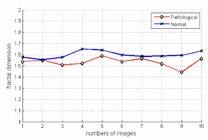
https://www.intechopen.com/chapters/55028
Arshad,M.H.,Kassas,M.,Hussein,A.E.,Abido,M.A. (2021,January4). ASimpleTechniqueforStudyingChaos UsingJerkEquationwithDiscreteTimeSineMap ResearchGate.
https://www.researchgate.net/publication/348243264 A Simple Technique for Studying Chaos Using Jerk Equation with Discrete Time Sine Map
Bishop,C.,Peres,Y.(2016).FractalsinProbabilityand Analysis(CambridgeStudiesinAdvancedMathematics). Cambridge:CambridgeUniversityPress.
doi:10.1017/9781316460238
Kelshiker,A.(2021,March16). HowMathCouldSave Lives–DartmouthUndergraduateJournalofScience https://sites.dartmouth.edu/dujs/2021/03/16/ow-mathcould-save-lives/ Mahieu,E.(2014,January). WolframDemonstrations
Project
https://demonstrations.wolfram.com/BoxCountingTheDimensionOf Coastlines/ Patterns-IndustryIoTConsortium.(2023,April4). IndustryIoTConsortium.
https://www.iiconsortium.org/patterns/ Ross,S.(2022).FractalDimension-Box-Counting CorrelationDimension[Video].https://www.youtube.com/ watch?v=IfP4wAC4HtA&ab channel=RossDynamicsLab TheMandelbrotSet.(n.d.).
http://www.math.utah.edu/alfeld/math/mandelbrot/mandelbrot.html
Uahabi,K.L.,M.Atounti.(2015). Applicationsoffractals inmedicine.AnnalsoftheUniversityofCraiovaMathematicsandComputerScienceSeries; https://www.semanticscholar.org/paper/Applications-offractals-in-medicine-UahabiAtounti/ab3a0a5bde175e501896ffab1ac8319d111bc8bf
08
Singular Value Decomposition and a Recommendation Algorithm
Written by Frank Xie SingularValueDecompositionandaRecommendationAlgorithm(ATLAProject)FrankXie
xie48478@sas.edu.sg
TeacherReviewer: Mr.Zitur
Abstract
GiventhedependenceofmostinternetusersonGoogle, Amazon,orothersearchandrecommendationengines,itis importanttorecallthebasisofmanyoftheseengines.This paperwillreconstructarudimentaryrecommendationalgorithmandpresentapotentialuseforitintheformofabook recommenderusingdatafromKaggle.Themaintoolusedin thealgorithmissingularvaluedecomposition,orSVD,and codewasexecutedinPython.
Keywords:recommendationalgorithm,SingularValueDecomposition(SVD),eigenvalues,diagonalization,Kaggle
Thesquarerootsofeach λn correspondto
,σ whichareindescendingorder.These
singularvaluesof A,andrepresentthelengthsofthevectors Av 1 , Av 2 ,..., Av n ,amongotherthings.Thesevaluesare keytocreatingaSVD.
SingularValueDecompositionandaRecommendationAlgorithm(ATLAProject)
FrankXie xie48478@sas.edu.sg
SingularValueDecompositionandaRecommendationAlgorithm(ATLAProject)
TeacherReviewer: Mr.Zitur
FrankXie
xie48478@sas.edu.sg
Abstract
TeacherReviewer: Mr.Zitur
Thesquarerootsofeach λn correspondto σ1 ,σ2 ,...,σn whichareindescendingorder.These σn = √λn arethe singularvaluesof A,andrepresentthelengthsofthevectors Av 1 , Av 2 ,..., Av n ,amongotherthings.Thesevaluesare keytocreatingaSVD.
Abstract
GiventhedependenceofmostinternetusersonGoogle, Amazon,orothersearchandrecommendationengines,itis importanttorecallthebasisofmanyoftheseengines.This paperwillreconstructarudimentaryrecommendationalgorithmandpresentapotentialuseforitintheformofabook recommenderusingdatafromKaggle.Themaintoolusedin thealgorithmissingularvaluedecomposition,orSVD,and codewasexecutedinPython.
Keywords:recommendationalgorithm,SingularValueDecomposition(SVD),eigenvalues,diagonalization,Kaggle
GiventhedependenceofmostinternetusersonGoogle, Amazon,orothersearchandrecommendationengines,itis importanttorecallthebasisofmanyoftheseengines.This paperwillreconstructarudimentaryrecommendationalgorithmandpresentapotentialuseforitintheformofabook recommenderusingdatafromKaggle.Themaintoolusedin thealgorithmissingularvaluedecomposition,orSVD,and codewasexecutedinPython.
TheSVDcanbestatedas A = UΣV T ,forany m × n matrix A withrank r ,and Σ adiagonalmatrixoftheform
Thesquarerootsofeach λn correspondto σ1 ,σ2 ,...,σn whichareindescendingorder.These σn = √λn arethe singularvaluesof A,andrepresentthelengthsofthevectors Av 1 , Av 2 ,..., Av n ,amongotherthings.Thesevaluesare keytocreatingaSVD.
TheSVDcanbestatedas A = UΣV T ,forany m × n matrix A withrank r ,and Σ adiagonalmatrixoftheform
1Introduction
Keywords:recommendationalgorithm,SingularValueDecomposition(SVD),eigenvalues,diagonalization,Kaggle
1Introduction
Asthedigitalworldgrowsincreasinglycompetitive, manyonlinecompanieshaveracedtomaketheirproducts andservicesmoreaddictive,personal,andattractivethan ever.Astheycatertomorepeople,however,itbecomesnext toimpossibletousehumantimetocustomiseoradjustto asignificantdegree-instead,algorithmsareused.Among themostfamous(orinfamous)aretheYouTubealgorithm, Spotify’srecommendations,andAmazon’s”Customerswho boughtthisitemalsobought...”Onemethodusedtomake thesealgorithmsissingularvaluedecomposition,orSVD.
Singularvaluedecompositionisanextremelyusefultechniqueinmanyareasofscience,mathematics,anddataanalysis,andisanextendedversionofeigendecomposition,also knownasdiagonalisation.Thereasonthatitismorepowerfulthandiagonalisationisbecauseitcanfactorallmatrices,whilediagonalisationcanonlybeperformedoncertain (non-defective)matrices.
Asthedigitalworldgrowsincreasinglycompetitive, manyonlinecompanieshaveracedtomaketheirproducts andservicesmoreaddictive,personal,andattractivethan ever.Astheycatertomorepeople,however,itbecomesnext toimpossibletousehumantimetocustomiseoradjustto asignificantdegree-instead,algorithmsareused.Among themostfamous(orinfamous)aretheYouTubealgorithm, Spotify’srecommendations,andAmazon’s”Customerswho boughtthisitemalsobought...”Onemethodusedtomake thesealgorithmsissingularvaluedecomposition,orSVD.
Singularvaluedecompositionisanextremelyusefultechniqueinmanyareasofscience,mathematics,anddataanalysis,andisanextendedversionofeigendecomposition,also knownasdiagonalisation.Thereasonthatitismorepowerfulthandiagonalisationisbecauseitcanfactorallmatrices,whilediagonalisationcanonlybeperformedoncertain (non-defective)matrices.
BeforecreatingaSVD,theconceptofsingularvaluesof an m × n matrix A shouldbeconsideredfirst.Theseare theeigenvaluesof AT A,whichmustnecessarilybe n × n, andtheremustexistanorthonormalbasisfor Rn consisting oftheeigenvectorsof AT A, v1 , v2 ,..., vn withassociated nonnegativeeigenvalues λ1 ,λ2 ,...,λn .Withsomerenumbering,itisalwayspossibletoassumethattheeigenvalues canbearrangedindescendingordersuchthat
BeforecreatingaSVD,theconceptofsingularvaluesof an m × n matrix A shouldbeconsideredfirst.Theseare theeigenvaluesof AT A,whichmustnecessarilybe n × n, andtheremustexistanorthonormalbasisfor Rn consisting oftheeigenvectorsof AT A, v1 , v2 ,..., vn withassociated nonnegativeeigenvalues λ1 ,λ2 ,...,λn .Withsomerenumbering,itisalwayspossibletoassumethattheeigenvalues canbearrangedindescendingordersuchthat
if σr istheleastnonzerosingularvalueof A;andwhere U and V areorthogonalmatrices.
2ConstructionofanSVD
if σr istheleastnonzerosingularvalueof A;andwhere U and V areorthogonalmatrices.
Theconstructionofasingularvaluedecompositioncan besplitinto3steps(”LinearAlgebraanditsApplications”). Thisexamplewillshowthedecompositionof
2ConstructionofanSVD
Theconstructionofasingularvaluedecompositioncan besplitinto3steps(”LinearAlgebraanditsApplications”). Thisexamplewillshowthedecompositionof
Step1. Findanorthogonaldiagonalisationof AT A.This isoftendifficultwithlargermatrices(duetothedifficultyin findingtheireigenvalues),butforsmallermatricesisdoable. First,findtheeigenvaluesof AT A,whichinthiscaseare25, 9,and0.Then,since AT A issymmetrictheeigenvectors mustbeorthogonal,sosimplycomputingthemisenough. Wefindtheeigenvectorsasunitvectors
322 23 2
Step1. Findanorthogonaldiagonalisationof AT A.This isoftendifficultwithlargermatrices(duetothedifficultyin findingtheireigenvalues),butforsmallermatricesisdoable. First,findtheeigenvaluesof AT A,whichinthiscaseare25, 9,and0.Then,since AT A issymmetrictheeigenvectors mustbeorthogonal,sosimplycomputingthemisenough. Wefindtheeigenvectorsasunitvectors
Then,findingavectororthogonaltobothvectors(i.e.notingthattheirdotproductwillequal0)yieldsthefinaleigenvector
wouldotherwiseberoughlylinear—notgreatfor,say,48 milliondatapoints.Thisimplementationwillbedonein python.
Thealgorithmisinroughlythreestages:preprocessing thedata,performingsingularvaluedecomposition,andinterpretingtheoutput.Theimportedlibrariesare
1 import numpyasnp
2 import pandasaspd
3 from scipy.linalg import svd
4 import matplotlib.pyplotasplt
5 from mpl_toolkits.mplot3d import Axes3D
6 import os
Step2. Setup Σ and V V issimply [v1 v2 v3 ],fortheir correspondingeigenvaluesindecreasingorder.Inthefinal SVD,thetranspose, V T isused,whichequals
whichareusedtoprocessandvisualisethedata.Anextremelyrigorouslycollectedsetofdataonfoodpreferences isusedasanexampledataset(whereA=Apple,B=Banana,C=Curry,D=Durian, ´ E= ´ Eclair,andF=Fries; scoresrangefrom0to10.Yes,Ireallyaskedpeoplethis. Yes,theywereconfused.):
ABCD ´ EF
AM 41010637
BU 6701033
JL 710105310
JZ 674367
HC 471382
HY 3610576
RY 5407610
Then,usingthesingularvalues(simplythesquareroots ofthenonzeroeigenvaluesinorder)5and3,
RP 690416
JK 550378
SB 2810497
ZK 511011010
WH 684340
AL 001001010
Notethe0columnpaddingoutthematrixintoa 2 × 3 matrix.
Step3.Construct U.Finally,usingtheformula
3.1PreprocessingtheData
Thisstepeitherrandomlygeneratesortakesa.csvfile andoutputsamatrixthatisusersbyitemsinsize.Thisis necessaryforthenextsteps,asthedatathatisgiveninthe mainmethod(seevisualisingthedata)isunpackedintoalist andneedstobeamatrix.
1 def randmatrix(users,items): # creates random matrix that is users x items
Then,thesingularvaluedecompositionofthematrixis
2 data=[]
3 for i in range(users):
4 user=[np.random.randint(11)/10 for in range(items)]
5 data.append(user)
6 mat=pd.DataFrame(data)
7 mat.index=["User " + str(i) for i in range(users)]
Thisprocesscanbecleverlymodifiedtoincreasecomputationspeedforcomputers,butthismethodwillsufficefor mosthumanrequirements.
3RecommendationAlgorithm
Thecodeusedherewillbeintentionallyreductive,asprogrammingafullimplementationofallthestepsinvolvedin SVDisunnecessarilycomplex.Forlargeralgorithms,some clevermathandprogrammingisrequiredtoreducetheprocessingpowerrequired,astheincreaseinprocessingpower
8 mat.columns=["Item " + str(i) for i in range(items)]
9 return mat 10
11
12 def matrix(users,values): # creates predefined matrix (values) that is users x items 13 data=[]
14 for i in range(users):
15 user=[values[6*i+k] for k in range(6)]
18 mat.index=["User " + str(i+1) for i in range(users)]
19 mat.columns=["Item " + str(i+1) for i in range(6)]
20 return mat
3.2ProcessingtheData
ThisstepsimplyperformsSVDonthematrix A thatis outputtedfromthepreviousstep,returningthesmallestpossible U, Σ,and V T .Whileitispossibletoprogramthisdecompositionmyself,thelibraryprovidedasignificantlyless computationallyintensivealgorithm.Usually,SVDisfairly difficultforacomputertoprocess.Thisalgorithmalsoreducesthedimensionalityof U and V inordertokeepthe matricesaseasytovisualiseaspossible.Thecolumnsthat arekept(k)correspondtothehighestsingularvalues.
1 def do_svd(mat,k=0,option=False): # performs singular value decomposition on matrix mat and returns sigma, u, and vt
2 u,sigma,vt=svd(mat)
3 u=pd.DataFrame(u[:,:k])
4 vt=pd.DataFrame(vt[:k,:])
5 if option:
6 return sigma
7 else:
8 return u,vt
3.3InterpretingtheOutput
Theoutputisprocessedhere.Thismethodtakesinanitem and V T ,returningthemost’recommended’itembasedon thepreferencesofeveryoneinthedataset.Thisiscomputed bydottingeachcolumnof V T withtheitem,andfindingthe itemtheleastdistance(which,bySVD,mustbethemost similar).
1 def recommend(item,vt,output_num=1): # recommendation using dot product distance
2 global rec
3 rec=[]
4 for item in range(len(vt.columns)):
5 if item!=item:
6 rec.append([item,np.dot(vt[ item],vt[item])])
7 final_rec=[i[0] for i in sorted( rec,key=lambda x:x[1],reverse=True) ]
8 return final_rec[:output_num]
3.4VisualisingtheData
Finally,thedataisvisualised.Themethoddefinedabove simplyplotsthedatausingmatplotlib,andthemainmethod usestheabovefunctionstoextractdatafromthe.csvand createabasicinterface.
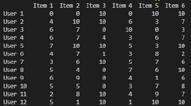
1 def plot_data(mat,data_type,camera= None): # plots data using matplotlib
2 fig=plt.figure()
3 ax=fig.add_subplot(111,projection =’3d’)
4 if camera!=None:
5 ax.view_init(elev=camera[0], azim=camera[1])
6 for index,row in mat.iterrows():
7 ax.scatter(row[0],row[1],row [2],alpha=0.8)
8 ax.text(row[0],row[1],row[2],’ {0} {1}’.format(data_type,index), size=10)
9 plt.show()
10
11 //skip// 12
13
14 if __name__== "__main__":
15 filename=os.getcwd()+"\\Downloads \\"+"likesdata txt"
16 a=matrix(12, list(np.array([*[[int (i) for i in line.split(",")] for line in open(filename, "r").readlines ()]]).reshape((-1)))) # this works
17 #a = randmatrix(20, 10)
Theoutputoftheprogramlookslikethis:
Figure2:Theuppernumberisuser-inputted;thealgorithm returnsthatifauserlikedcurry(2)thattheywouldmost likelyalsolikebananas(1)andfries(5)
Ineededbookrecommendations,butinteractingwith peopleiscringe.SoIusedmyalgorithmtocuremybook ennui.
4.1HowtoCureEnnuiwithMath
Havinggonethroughthelegworkofcreatingthealgorithm,myextensionismostlyinrefiningandapplyingthealgorithmtosomethingthatwillhelpmepersonally,andpotentiallyothers,withmotivation.Thefirst partoftheextensionisinfindingthedata,forwhichI turnedtothescourgeofBigData-Kaggle.Asmuch asIhatethemoderninvasionofprivacythattheinternethasprovided,Alphabet’sbenevolenceinprovidingthisdataisveryhelpful.ThedatasetIimported wasBookRatings:https://www.kaggle.com/arashnic/bookrecommendation-dataset?select=Ratings.csv
4.2Preprocessing
Thebookdatasetwasverylarge(340,556uniqueusers, eachratingalargenumberofbooks),soefficiencywasmore importantinanalysingthedataset.Thefirsttaskwastogenerateamatrix,withsizeusersxbooks,whichwasdoneusingthefollowingcode:
1 import os
2 import pandas
3 import numpyasnp
4 5 df=pandas.read_csv(os.getcwd()+"\\"+" Ratings.csv")
6 7 books=df["ISBN"].unique()
8 books=books[:5000]
9
10 df_small=df.loc[df["ISBN"].isin(books) ]
11 users=df_small["User-ID"].unique()
12
13 df=df_small.copy()
14
15 matrix=pandas.DataFrame(data=np.zeros( dtype=np.uint8,shape=(len(users),len( books))),index=users,columns=books)
16 for _,row in df.iterrows():
17 matrix.at[row["User-ID"],row["ISBN" ]]=row["Book-Rating"]
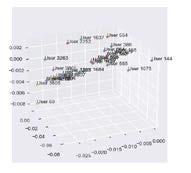
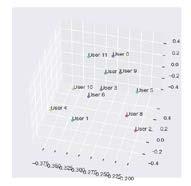
18
19 matrix.to_csv(os.getcwd()+"\\"+"matrix csv")
20 print(matrix)
whichIranseparatelyfromthemaincode,asthisremovesthenecessityofgeneratingthewholematrixevery timethisalgorithmisrun.
Thispreprocessingstepalsoservedtochooseasampling ofthebooks-thefirst5000uniquebooksbytheirISBN, whichwasrandomised.Thiswastoreduceprocessingtime, astheoriginalalgorithmIappliedtookextremelylongto run,andwouldhavegeneratedafilethatcontainedupwards of400GBofdata.
4.3Output
Theoutputofthealgorithmissimilartoearlier.Thematrixlookslikethis:
Mostusersfellalongaparticularline,butafewwereoutliers(theyratedalotofbooks!),andthemostpopularbooks alsobecameoutliers:
Notethattheplots,forreadability’ssake,donotploteverysingleuseroritem.Themostinterestingpartofthealgorithm,forme,wasgettingthebookrecommendation,which wasasfollows:
2023,fromhttps://towardsdatascience.com/understandingsingular-value-decomposition-and-its-application-in-datascience-388a54be95d SingularValueDecomposition(SVD)tutorial.(2023). Retrieved25January2023,from https://web.mit.edu/be.400/www/SVD/Singular Value Decomposition.htm
Lay,Lay,Mcdonald(2015)LinearAlgebraandIts Applications.Pearson.
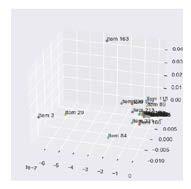
160correspondedtoTheCatcherintheRye,and173and 9toTheCatcherintheRye-Barron’sBookNotesand TheAdventuresofHuckleberryFinn,respectively.Conveniently,Ihaven’treadTheAdventuresofHuckleberryFinn before,soImayverywellreaditnow.Notethatthealgorithmisfairlyefficient;evenrunningwith16824500datapoints(33649 × 5000),itonlytakes10minutesorsotorun, afteranupdatetothewaythedataispacked(asamatrix .csv,ratherthanaplainlist).
5Summary
Thisalgorithmhasbeenshownnowtobeusefulenough inprovidingrecommendations.Thelargestbottlenecksin performancecomefromthegenerationofthematrixand thematrixcomputationsneeded.Otherimplementations ofthisalgorithm,orfutureusesofthisimplementation, shouldprobablyspendsometimedesigningamore friendlyGUIandoptimisingperformance.Otherdatasets availableonlinearealsousablewiththisalgorithm: https://www.kaggle.com/shadey/spotify-2010-2019/data, forexample,whichisaSpotifymusicpreferencedataset.
References
DeepDiveintoNetflix’sRecommenderSystem.(2021). Retrieved25January2023,from https://towardsdatascience.com/deep-dive-into-netflixsrecommender-system-341806ae3b48
UnderstandingSingularValueDecompositionandits ApplicationinDataScience.(2022).Retrieved25January
09 Natural Eigenvectors in Higher Number Systems
Written by Gaurav GoelNaturalEigenvectorsinHigherNumberSystems
GauravGoel
goel47628@sas.edu.sg
TeacherReviewer: Mr.Craig
Abstract
Abstract
Linearalgebraisgenerallyintroducedthroughworkingwith therealnumbersystemindifferentdimensions(R, R2 , R3 , andsoon).However,thereareavarietyofalternativenumber systemsthatarefields,whichembracemultidimensionalityin amuchmoreaccessibleandnaturalmanner.
Inthispaper,Iaimtoinvestigateafewofthesenumbersystems,interpretthemthroughlinearalgebra,anddiscovera highernumbersystemwhichembraceseigenvaluesinanaturalway.Essentially,Iwillextendonmyunderstandingof linearalgebraandeigenvectorstointerpretthebehaviourof differentnumbersystems.
Keywords: eigenvalues,CliffordAlgebra,multidimensionality,numbersystems
1ExplorationofDifferentNumberSystems
Thereareavarietyofdifferentnumbersystemsthatwe caninvestigate.Theseincludetherationalnumbers(Q), complexnumbers(C),quarternions(H),finitefields(Zn ), andmanymore.However,theaimhereisnottoinvestigateanarbitrarynumbersystem.Rather,wewanttoinvestigatenumbersystemsthatnaturallyincorporateelements andpropertiesoflinearalgebra.Thismeansthatwewantto findnumbersystemsthatnaturallycombinescalarandvectorproperties.Infact,aftersomeresearching,thereisindeed aclassofnumbersystemswhichdojustthis:CliffordAlgebras.
ACliffordAlgebra,denotedCla,b (R),isaclassofalgebraswhereanygeneralelement q = a + ⃗ v ,where a isthe scalarpartand ⃗ v isthevectorpart.Addingtwoelements simplymakesuseofscalarandvectoraddition,butmultiplyingtwoelementsgivesusaninterestingcombinationof scalarmultiples,dotproducts,andcrossproducts.
Moregenerallyspeaking,if ⃗ e1 , ⃗ e2 , ⃗ e3 ,... areorthogonal unitvectors,aCliffordAlgebraelementcanbedefinedas:
And,sinceCliffordAlgebrasalreadydefineadditionand multiplicationbetweenelementsforus,wecandirectlytake thesedefinitionstolinearalgebra,byusingvectoradditionandmatrixmultiplication.Thisgivesusanumbersystemframeworkthatnaturallyincorporatesvectorandmatrix properties.
NowthatwehaveabasicunderstandingofhowlinearalgebracanbeappliedtounderstandCliffordAlgebras,we seektounderstandhoweigenvectorscanbeappliedtothese algebras.Inparticular,justaseigenvectorsseektounderstandhowmatrixmultiplicationandscalarmultiplicationact equivalentlyonavector,intheseCliffordAlgebras,wewant todiscoverwhetherornotelement-wisemultiplicationand scalarmultiplicationactequivalentlyonelements. WemaybeginbyselectingafewbasicCliffordAlgebras andanalyzingwhetherornotthisispossible.
2ComplexNumbers
ThemostintuitiveCliffordAlgebratobeginwithis Cl1,0 (R),orthecomplexnumbersystem(C).Thisisbecauseeach z ∈ C canbewrittenintwocomponents(a + bi). Inordertodiscoverwhetherornoteigenvectorscanbeappliedtocomplexnumbers,wehavetotaketwosteps.First, weapplylinearalgebratocomplexnumbers.Second,we searchforeigenvectorsinthislinearalgebrarepresentation ofcomplexnumbers.
2.1ApplyingLinearAlgebratoComplex Numbers
Applyinglinearalgebratocomplexnumberstakesthree steps.First,weneedtorepresenteachcomplexnumberasa vectorinlinearalgebra.Second,weneedtodefineaddition inthisalgebra.Third,weneedtodefinemultiplicationin thisalgebra.
Inthiscase,thecolumnvectorrepresentingourelement q is:
First,itisnottoohardtorepresenteachcomplexnumber asavectorinlinearalgebra.Tomap C → R2 ,foreach z ∈ C,where z = a + bi (for a,b ∈ R),wehave:
Thisisjustnormalvectoraddition.
Thisisclearlynotnormalvectormultiplication.Instead, wecangive
Ingeneral,for
Thischecksout,soournewdefinitionofmultiplication holds.
2.2EigenvectorsintheComplexNumbers
Inordertofindeigenvectorsinthecomplexnumbers,we ask:isitpossibletofindasetofcomplexnumbers S such
Thiscanbeverifiedinafewsteps. First,supposeweknow
Sincethedeterminantoftheleft-handmatrixmustbe equalto 0,bytheeigenvectorcharacteristicequation,weget:
(λ1 a0 λ2 )2 +(λ1 b0 )2 =0
However,thisisonlysatisfiedifboth λ1 a0 λ2 =0 and λ1 b0 =0.If λ1 b0 =0,either λ1 =0 or b0 =0,bothof whicharetrivialsolutions.
2.3SummaryforComplexNumbers
Unfortunately,thesetrivialsolutionssuggesttousthat thereexistnosucheigenvectorsandeigenvaluesinthecomplexnumbers.Intuitivelythough,thisshouldmakesense. Whenmultiplyingbyacomplexnumber,theresult,forany othercomplexnumber,isarotationandadilation.Thisrotationsetsitofftheaxiswewouldideallywantittobeon. Thus,wemustlooktodifferentnumbersystemsforoursolution.
3Split-ComplexNumbers
Afterrecognizingthatthepreviousissueliedwithinthe sumofsquaresinthefinalcharacteristicequation,wemay approachadifferentCliffordAlgebratoovercomethisissue,namelythesplit-complexnumbersystem(Cl0,1 (R)), or R ⊗ R.Thisnumbersystemworksverysimilartothe complexnumbers,exceptthat i2 =1 instead.Inorderto discoverwhetherornoteigenvectorscanbeappliedtosplitcomplexnumbers,wetakethesametwostepsaslasttime. First,weapplylinearalgebratothisnumbersystem.Second, wesearchforeigenvectorsinthislinearalgebrarepresentationofsplit-complexnumbers.
3.1ApplyingLinearAlgebratoSplit-Complex Numbers
Onceagain,applyinglinearalgebratosplit-complex numberstakesthreesteps.First,weneedtorepresenteach z ∈ Cl0,1 (R) asavectorinlinearalgebra.Second,weneed todefineadditioninthisalgebra.Third,weneedtodefine multiplicationinthisalgebra.
First,justasbefore,itisnottoohardtorepresenteach z ∈ Cl0,1 (R) asavectorinlinearalgebra.TomapCl0,1 (R) → R2 ,foreach z ∈ Cl0,1 (R),where z = a + bi (for a,b ∈ R), wehave:
z = a b
Then,foraddition,given z1 = a1 + b1 i and z2 = a2 + b2 i, weknowthat z1 + z2 =(a1 + a2 )+(b1 + b2 )i.So,wehave:
This,onceagain,isjustnormalvectoraddition.
Finally,formultiplication,given z1 = a1 + b1 i and z2 = a2 + b2 i,weknowthat z1 z2 =(a1 a2 + b1 b2 )+(a1 b2 + a2 b1 )i.Notethedifferenceherefromlasttime.So,wehave:
Thisisclearlynotnormalvectormultiplication.Instead, wecangive z2 amultiplicationmatrix,say Az2 ,suchthat z1 z2 inthesplit-complexnumbersequals Az2 z1 inlinear algebra.
Ingeneral,for z = a + bi,say:
is:
Thischecksout,soournewdefinitionofmultiplication holds.
3.2EigenvectorsintheSplit-ComplexNumbers
Inordertofindeigenvectorsinthesplit-complexnumbers,weask:isitpossibletofindaset S ⊂ Cl0,1 (R) such thatforall z
(for λ
Thiscanbeverifiedinafewsteps.
First,supposeweknow z0 = a0 + b0 i ∈ S Then, z = a + bi ∈ S ifandonlyif z = λ1 z0 and
Breakingthisintotwoparts,onthetopwehave:
equalto 0,bytheeigenvectorcharacteristicequation,weget:
3.3SummaryforSplit-ComplexNumbers
Unfortunately,thesetrivialsolutionsalsosuggesttous thatthereexistnosucheigenvectorsandeigenvaluesinthe split-complexnumbersystem.Whilethereisnointuitiveexplanationhere,wemuststilllooktodifferentnumbersystemsforoursolution.
4Cl1,1 (R)
ItseemssofarthatthereisnoCliffordAlgebrawhichincorporateslinearalgebraandeigenvectorsinanaturalway. However,beforegeneralizingourconclusionstothewider classofCliffordAlgebras,itisworthconsideringanalgebrawithalargercolumnmatrix.Inparticular,wewillconsidertheCliffordAlgebraCl1,1 (R).Thisnumbersystem canalmostbeconsideredasacombinationofcomplexand split-complexnumbers.Basically,inthissystem,wehave twobasisvectors i and j ,suchthat i2 = 1 and j 2 =1 Thismeansthateach z ∈ Cl1,1 (R) canbeexpressedas z = a + bi + cj + dij .Inordertodiscoverwhetherornot eigenvectorscanbeappliedtoCl1,1 (R),wetakethesame twostepsaslasttime.First,weapplylinearalgebratothis numbersystem.Second,wesearchforeigenvectorsinthis linearalgebrarepresentationofCl1,1 (R)
4.1ApplyingLinearAlgebratoCl1,1 (R)
Onceagain,applyinglinearalgebratoCl1,1 (R) takes threesteps.First,weneedtorepresenteach z ∈ Cl1,1 (R) asavectorinlinearalgebra.Second,weneedtodefineadditioninthisalgebra.Third,weneedtodefinemultiplication inthisalgebra.
First,justasbefore,itisnottoohardtorepresenteach z ∈ Cl1,1 (R) asavectorinlinearalgebra.TomapCl1,1 (R) → R2 ,foreach z ∈ Cl1,1 (R),where z = a + bi + cj + dij (for a,b,c,d ∈ R),wehave:
This,onceagain,isjustnormalvectoraddition. Finally,formultiplication,given
Thisisclearlynotnormalvectormultiplication.Instead, wecangive z2 amultiplicationmatrix,say A( z2 ),suchthat
2 inthesplit-complexnumbersequals A( z2 ) · z1 in linearalgebra.
Ingeneral,for z = a + bi + cj + dij ,say:
Then,wehavethat
Thischecksout,soournewdefinitionofmultiplication holds.
4.2EigenvectorsintheCl1,1 (R)
InordertofindeigenvectorsinCl1,1 (R),weask:isitpossibletofindaset S ⊂ Cl1,1 (R) suchthatforall z1 ,z2 ∈ S , z2 = λ1 z1 and z1 z2 = λ2 z1 (for λ1 ,λ2 ∈ R)?
Thiscanbeverifiedinafewsteps.
First,supposeweknow z0 = a0 + b0 i + c0 j + do ij ∈ S
Then, z = a + bi + cj + dij ∈ S ifandonlyif z = λ1 z0 and z0 z = λ2 z0 .
So,since z = λ1 z0 :
Sincethedeterminantoftheleft-handmatrixmustbe equalto 0,bytheeigenvectorcharacteristicequation,we getaverycomplicatedequation.Aftersimplifyingandcancelling,weareleftwith:
Giventhatthisequationissocomplex,itisextremelyhard totreatitsimilarlytoourpreviouscharacteristicequations, whichonlyhadtwoterms.Rather,herewecansearchfor nontrivialsolutionsthatsatisfythisequation.
Forinstance,consider:
Aswecansee,forthesevalues,if λ =1,thecalculations checkout.
Aftersignificantlymoretrialanderror,weseethatour potentialnontrivialvaluesof z0 and z ,forarbitrary λ1 ,λ2 ∈ R arelimitedto:
Unfortunately,althoughthisisquitepromising,since
and z arenotscalarmultiples,thesespecificelementsdonot fulfilouroriginalexpectations.However,theseelementsdo haveaname:pseudoscalars,whichwewilltakealookatin ouroverallconclusion.
5Conclusion
Wehaveinvestigatedavarietyofnumbersystemsthat embracedlinearalgebrainamorenaturalmanner,bylookingatnumbersystemswhichnaturallyhadcolumnmatrices andvectorparts.Whilethegoalwastofindalineargroup ofnumbers,throughtheseinvestigations,wemayconclude thatnosuchgroupexists.
10 Evaluating Epidemiological Solutions through S-I-R Modeling
Written by Gaurav GoelEvaluatingEpidemiologicalSolutionsthroughS-I-RModeling
GauravGoel
goel47628@sas.edu.sg
TeacherReviewer: Mr.Craig
Abstract
Abstract
Throughpreviousinvestigation,Ihaveformedtheopinion thateventhoughlinearalgebraisaneattooltoconceptualizeoperationsinhighermath,theimportanceoflinearalgebratrulyliesinitsreal-worldcomputationalapplication.As aresult,forthisproject,Iexploredatopicwithreal-world implications.
Inthispaper,IaimtoreanalyzethederivationoftheSIR modelthroughdifferentialequationsandlinearalgebra,and thenmyextensionwillbetoadapttheSIRmodeltomeasure theimpactsofepidemiologicalsolutionssuchasvaccination andlockdownthroughthedeathssustainedunderdifferent scenarios.
Keywords:SIRModel,pandemic,differentialequations,epidemiology,computationalmodelling
1ExplorationoftheBasicSIRModel
ThebasicSIRmodelconsistsofthreecompartments:Susceptible,Infected,andRecovered.Theflowofpeopleinand
therecoveryrate,ortheproportionofinfectedindividuals thatrecoveroveraperiodoftime.
Withthisinformation,wecansaythat:
• theinstantaneousbirthrateis µN
• thedeathratesoutofeachcompartmentare µS , µI µR respectively
• therecoveryrateis γI
• theinfectionrateis βSI
Atthispoint,ourdefinitionsraisethequestion:Whatis β ?Thisvariableisslightlymorecomplicatedthantherest.
Inessence, β = kp,where k isthenumberofinteractions apersonmakeswithacertainpopulationand p istheproportionthattheaverageinteractionbetweenasusceptible individualandaninfectedindividualspreadstheinfection.
Giventhediagram,wecancreateasetofdifferential equationstomodelthisidea.
TeacherReviewer: Mr.Craig
Abstract
Throughpreviousinvestigation,Ihaveformedtheopinion thateventhoughlinearalgebraisaneattooltoconceptualizeoperationsinhighermath,theimportanceoflinearalgebratrulyliesinitsreal-worldcomputationalapplication.As aresult,forthisproject,Iexploredatopicwithreal-world implications.
therecoveryrate,ortheproportionofinfectedindividuals thatrecoveroveraperiodoftime.
Withthisinformation,wecansaythat:
• theinstantaneousbirthrateis µN
EvaluatingEpidemiologicalSolutionsthroughS-I-RModeling
• thedeathratesoutofeachcompartmentare µS , µI ,and µR respectively
• therecoveryrateis γI
Inthispaper,IaimtoreanalyzethederivationoftheSIR modelthroughdifferentialequationsandlinearalgebra,and thenmyextensionwillbetoadapttheSIRmodeltomeasure theimpactsofepidemiologicalsolutionssuchasvaccination andlockdownthroughthedeathssustainedunderdifferent scenarios.
GauravGoel
• theinfectionrateis βSI
goel47628@sas.edu.sg
TeacherReviewer: Mr.Craig
Keywords:SIRModel,pandemic,differentialequations,epidemiology,computationalmodelling
1ExplorationoftheBasicSIRModel
Abstract
ThebasicSIRmodelconsistsofthreecompartments:Susceptible,Infected,andRecovered.Theflowofpeopleinand outofthesethreecompartmentscanbesummarizedbythe diagramIhavedrawnbelow:
Throughpreviousinvestigation,Ihaveformedtheopinion thateventhoughlinearalgebraisaneattooltoconceptualizeoperationsinhighermath,theimportanceoflinearalgebratrulyliesinitsreal-worldcomputationalapplication.As aresult,forthisproject,Iexploredatopicwithreal-world
1ExplorationoftheBasicSIRModel
Atthispoint,ourdefinitionsraisethequestion:Whatis β ?Thisvariableisslightlymorecomplicatedthantherest. Inessence, β = kp,where k isthenumberofinteractions apersonmakeswithacertainpopulationand p istheproportionthattheaverageinteractionbetweenasusceptible individualandaninfectedindividualspreadstheinfection. Giventhediagram,wecancreateasetofdifferential equationstomodelthisidea.
therecoveryrate,ortheproportionofinfectedindividuals thatrecoveroveraperiodoftime.
Withthisinformation,wecansaythat:
dS
• theinstantaneousbirthrateis µN
dt = birth death infection = µN µS βSI
• thedeathratesoutofeachcompartmentare µS , µI ,and µR respectively
dI
dt = infection death recovery = βSI µI γI
• therecoveryrateis γI
dR
• theinfectionrateis βSI
dt = recovery death = γI µR
Fromhere,thereisalotofadditionaltheoreticalanalysis wecoulddo.
Forinstance,wecouldderivethebasicreproductionrate (theaveragenumberofindividualsthateachinfectedindividualinfects).Inparticular,wecanaskourselves:When areinfectionsgrowing?Weseethatinfectionsaregrowing when dI dt > 0.Thisgivesus:
Atthispoint,ourdefinitionsraisethequestion:Whatis β ?Thisvariableisslightlymorecomplicatedthantherest. Inessence, β = kp,where k isthenumberofinteractions apersonmakeswithacertainpopulationand p istheproportionthattheaverageinteractionbetweenasusceptible individualandaninfectedindividualspreadstheinfection. Giventhediagram,wecancreateasetofdifferential equationstomodelthisidea.
βSI µI γI> 0
Let’sdefinesomevariablesandthenexaminewhateach rateis.
ThebasicSIRmodelconsistsofthreecompartments:Susceptible,Infected,andRecovered.Theflowofpeopleinand outofthesethreecompartmentscanbesummarizedbythe diagramIhavedrawnbelow:
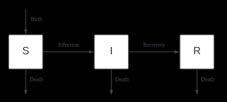

First, S , I ,and R arethenumberofpeopleineachofthe respectivecompartments.Furthermore, S + I + R = N , whichisthetotalpopulationweareobserving.Next,we needtodefineabirth/deathrate.Wewillconsiderthese equal,andusethevariable µ tosignifytheproportionofpeoplethatdieoveraperiodoftime.Last,weuse γ torepresent
dS
Figure1:SIRmodel
Let’sdefinesomevariablesandthenexaminewhateach rateis.
First, S , I ,and R arethenumberofpeopleineachofthe respectivecompartments.Furthermore, S + I + R = N , whichisthetotalpopulationweareobserving.Next,we needtodefineabirth/deathrate.Wewillconsiderthese equal,andusethevariable µ tosignifytheproportionofpeoplethatdieoveraperiodoftime.Last,weuse γ torepresent
dI
βSI>µI + γI
dt = birth death infection = µN µS βSI
βSI
µI + γI > 1
dt = infection death recovery = βSI µI γI
dR
βS µ + γ > 1
dt = recovery death = γI µR
Infact,thisvalue, βS µ+γ ,isthebasicreproductionrate,or R0 .Conceptually,thiscanbeexplainedbytheideathatthe
Fromhere,thereisalotofadditionaltheoreticalanalysis wecoulddo.
Forinstance,wecouldderivethebasicreproductionrate (theaveragenumberofindividualsthateachinfectedindividualinfects).Inparticular,wecanaskourselves:When areinfectionsgrowing?Weseethatinfectionsaregrowing when dI dt > 0.Thisgivesus:
βSI µI γI> 0
βSI>µI + γI
βSI
µI + γI > 1
βS
µ + γ > 1
Infact,thisvalue, βS µ+γ ,isthebasicreproductionrate,or R0 .Conceptually,thiscanbeexplainedbytheideathatthe
rateofinfectionisgrowingifeachinfectedpersonisinfectingmorethanoneotherindividual,justasweseeinour equation.
Wecouldalsoanalyzepotentialequilibriumstates.Inparticular,wereachanequilibriumstatewhen dI dt =0.This givesus:
βSI µI γI =0 (βS µ γ )I =0
Thisimpliesoneoftwothings,First,when I =0,there arenoinfections,whichisknownasthedisease-freeequilibrium,Second,whenwehave βS µ γ ,wherethere arestillinfections,wehavewhatisknownasanendemic equilibrium.
However,thesesameconclusionscanbederivedfromobservingalinearalgebraicmodeloftheSIRmodel.
2ApplyingLinearAlgebratotheSIRModel
InordertoapplylinearalgebratotheSIRmodel,wemust firstdiscretizeourdifferentialequations.Inorderwords, ratherthantakinginstantaneousrates,wemaylookatthe changeintheSIRvaluesoverasmall,macroscopicperiod oftime,perhapsaweek.Then,wegetnewequations,identicalbefore,butusingmacroscopicratherthaninfinitesimal increments:
Wemustmakeonechangehere.Inparticular,weseethat wecannothavethe βS terminsideourmatrix,as S will continuetochange.Thus,whilethismayincreaseerrorin ourfinalmodel,simplyforthesakeofourcalculations,we willapproximate S to N .Thisgivesusthefinaltransition matrixof:
γI
Considertheinitialstatewithapopulationof N =1000 and I0 =2 infectedpeople.Letusapproximatevaluesfor therestoftheparameters(notethatthesevaluesareexaggeratedforthesakeofthesimulation).Aproportionofapproximately µ =0 01 peoplearebornanddieeachweek.A proportionof γ =0 08 peoplewillrecovereachweek.And, wecanassign k =0.005 and p =0.05,givingusavalueof β =0.0025. Wenowgetaninitialmatrixof:
t = recovery death = γI µR
Here,oneapproachwouldbetofindtheJacobianmatrix ofthecolumnvectorofthesedifferentialequations,andthen buildthenextgenerationmatrixofthesedifferentialequations.However,aswewillseelater,thatdoesnotserveour purposeoflookingattheoverallmodelasawhole,andthus, wewantasimplerlinearalgebraicmodel.
ThesimplermodelistocreatebasicMarkovChainmatrix,giventheinformationweknowaboutthechangesinthe respectivevalues.
Inparticular,ifwethinkofeachvalueasitsprevious valueplustheincrementalchange(e.g. Sn+1 = Sn +∆Sn ), thenwegettheequationsbelow.
Sn+1 = Sn +(µN µS βSI )∆t
In+1 = In +(βSI µI γI )∆t
Rn+1 = Rn +(γI µR)∆t
Oneeditwemustmakeistorewritethe S equationwithouttheconstant,givingus:
Sn+1 = Sn +(µI + µR βSI )∆t
Ifweconsidereachratetobeamacroscopicraterather thananinfinitesimalone,the ∆t termvanishes.Thus,when representedasamatrix,weobtainthetransitionmatrix:
Wegetatransitionmatrixof:
1 2 490 01 03 410 00 080 99
Aftersimulatingthisdiseasespread,wegettheseresults (roundedtothenearestnaturalnumbers):
yrs/wksSIR
0/099820
0.5/268639047
1/52244278479
1.5/7821198691
2/10429848655
2.5/13037641582
3/15641453533
3.5/18239974527
4/20836184554
Figure2:SIRmodelincludinginfectiousdeath
Furthermore,ournewdifferentialequationsareasfollows:
dS
dt = birth death infection = µN µS βSI
dI
6/31236568567
6.5/33836571564
dt = infection death infectiousdeath recovery = βSI µI αI γI
dR
dt = recovery death = γI µR
dD
dt = infectiousdeath = αI
Throughthemethodweusedbefore,wecantakethese differentialequationsintolinearalgebraonceagain.Our transitionmatrixis:
Aswecansee,thediseasespreadtoaround 65% ofthe population,andreachedasteadystaterightaroundthesixth year.
Now,let’susethisunderstandingtodevelopmoresophisticatedmodels.
3TheInfectiousDeathSIRModel
Thefirstthingwewillattempttodoisintroducetheidea ofdeathbyinfection.Inthisway,wecanquantifyexactly howlargethemortalityimpactoftheinfectionactuallywas. Usingthis,wecancompareresultsacrossdifferenttreatmentsandsolutions.
Weintroducethisideabyaddinganextracompartment, D ,fordeathbyinfection.
Wecannowdefineafewmorevariables.
Wewillcalltheproportionofinfectedindividualswho diefromthedisease(notfromnaturalcauses) α.Thismeans thattherateofflowfrom I to D is αI .
Thisisdepictedinthediagrambelow:
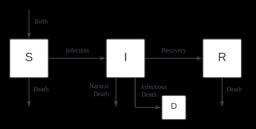
Usingthesamevalueswehadlasttime,butnowincluding that α =0 015,wegainanewsimulation. Ourinitialmatrixisonceagain:
However,ourtransitionmatrixisnow:
0/0998200
0.5/2689165367
1/5232823236477
1.5/7823877550135
2/10430928509154
2.5/13038918432162
3/15645018364169
3.5/18248224317177
4/20847736299199
6/31239133322241
6.5/33840328303266
Wecanseehowtheseresultsdifferedslightlyfromlast time.Withtheincorporationoftheinfectiousdeathscompartment,weseeadecreaseinthenumberofinfectiouspeopleandrecoveredpeopleleftover(probablybecausealotof themdied).
Wewillusethissimulationasacontroltomeasureagainst thesolutionswepropose.
4TheLockdownSIRModel
Thefirstsolutionwecanlookatisputtingcitizensinto lockdown.Whateffectdoesthissolutionhave,andhow shoulditimpactourmodel.Well,inessence,lockdowndoes nothelpwithanything,exceptforthefactthatitdecreases thenumberofinterpersonalinteractionsinacountry.Inparticular,thismeansthat k willdecrease.Saythatthenew valueof k is kl ,forsomelockdownfactor l .Then,forour newvalueof β , klp = βl Ourdiagramisasfollows:
Onceagain,wecreateatransitionMarkovMatrixfor thesedifferentialequations:
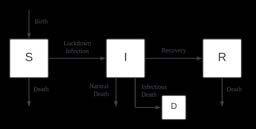
0/0998200
0.5/26985672
1/5295018266
1.5/78869417317
2/1047456315537
2.5/1306406123762
3/1565954327883
3.5/1825962827997
4/20861620258106
Intermsofourequations,thereareafewimplications.
First,weusethevariable ρ torepresenttheproportion ofindividualswhogetvaccinatedatbirth.Thisgivesusa rateof µ(1 ρ)N babiesbeingbornintothesusceptible compartmentand µρN babiesbeingbornintotherecovered compartment.
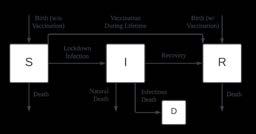
Second,weusethevariable ν torepresenttheproportionofsusceptibleindividualswhochoosetogetvaccinated duringtheirlifetime.Thisgivesusarateof νS individuals flowingfromthesusceptiblecompartmenttotherecovered compartment.
Giventhesechanges,hereareournewdifferentialequations:
dS
dt = birth(w/outvaccine) death vaccination infection
dI
= µ(1 ρ)N µS νS βSI
dt = infection death infectiousdeath recovery
= βSI µI αI γI
6/31270511157127
6.5/33871512142131
dR
dt = birth(wvaccine) + vaccination + recovery death
= µρN + νS + γI µR
Aswecansee,evenbyjustlimitinginteractionsbetween peopleby 40%,lockdownisasolutionthatcanliterally halvethenumberofpotentialdeaths.
5TheVaccinationSIRModel
Thenextsolutionwecanlookatisimplementingvaccination.Thiscanbeimplementedbothatbirthandduring people’slifetimes,sowewillassumebothhappen.Inparticular,thishastwoimplications.One,someindividualsare borndirectlyintotherecoveredcompartmentasaresultof beingvaccinatedfrombirth.Two,individualswhogetvaccinatedduringtheirlifetimesskipovertheinfectedstageand godirectlyfromsusceptibletorecovered.
Thiscanbeseeninthisdiagram:
dD
dt = infectiousdeath = αI
OurtransitionalMarkovMatrixis:
Let’schoosevaluesfor ρ and ν .Atbirth,thevaccination ratecanbe ρ =0.009.Duringalifetime,thevaccination ratecanbe ν =0.01.
Thesevaccinationstatisticsgiveusresultsof:
0/0998200
0.5/26744372375
1/5242210947336
1.5/782906462371
2/1043002764088
2.5/1303381461696
3/1563739591100
3.5/1824007572103
4/2084207561106
dS
dt = birth(w/outvaccine) death vaccination infection
=
dI
dt = infection death infectiousdeath recovery
dR
= βlSI µI αI γI
dt = birth(wvaccine) + vaccination + recovery death
= µρN + νS + γI µR
6/31244511564119
6.5/33844313572123
Aswecanseeonceagain,theselevelsofvaccination provetobeextremelyeffectiveincurbingthenumberof deaths.Evenifonly 0 9% ofthepopulationgetsvaccinated eachweek,whichmeansaround 750 outof 1000 peopleover thecourseof 2 5 years,wecanseemassivebenefitsinterms ofreducingthenumberofdeathssustained.
dD
dt = infectiousdeath = αI
OurtransitionalMarkovMatrix:
Finally,ourresultsare:
6CombiningtheTwoSolutions
6 Combining the Two Solutions
Finally,wecancombinethetwosolutions,asinthediagrambelow: Ourdifferentialequations:
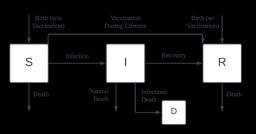
4/20855305728
6/31257706078
6.5/33858406158
Here,thecombinationofthetwosolutionsprovestobefar moreeffectivethanwecouldevenimagine!Thisisbecause theybothpreventthespreadofthediseaseindifferentways. Vaccinationincreasesthenumberofindividualsintherecoveredcompartment,whilelockdowndecreasesthelikelihoodasusceptibleindividualwilltransitionintotheinfected compartment.Thismodelprovestobequitevolatile,asthe rateofinfectionisdirectlydependentonthenumberofinfectionspresent.Thus,bycontainingthenumberofinfected individualswellfromthebeginning,weseemassivebenefits inthelong-run.
7Conclusion
Toconclude,wefirstsawthatwecanadapttheSIRmodel inavarietyofwaystomimiccertaineventsandphenomena, andwewereabletodevelopavarietyofmorecomplexmodelsinordertoanalyzepotentialsolutionstothespreadof aninfectionordisease.Furthermore,wecanseethatusing methodsoflockdownandvaccinationtocontainthespread ofdiseaseare,infact,extremelyeffective,especiallywhen usedintandem.
Ithinkperhapsthemostimportantpartofthisprojectis thewaythatitcanbetranslatedintoreal-worldapplications, duringpandemicsandepidemicssuchas,say,COVID-19. BecauseoftheadaptabilityoftheSIRmodel,wecanmodel theeffectofsolutionsrangingfarbeyondjustvaccination andlockdown.Thismeansthatthismodelcanbeanexcellentpredictorforworldcrisessuchasthesediseases,andit amazesmejusthowmuchlinearalgebraandmathcanbe appliedtomakeanimpact.
SourcesUsed
HerearetherangeofsourcesIusedinordertounderstand thistopic:
PurdueUniversity(DifferentialEquationsandLinearAlgebra)
MathematicalAssociationofAmerica(TheSIRModelfor SpreadofDisease)
AndrewBrouwer(UnderstandingtheBasicReproduction NumberthroughLinearAlgebra)
Wikipedia(FundamentalMatrix-LinearDifferentialEquations)
duringpandemicsandepidemicssuchas,say,COVID-19. BecauseoftheadaptabilityoftheSIRmodel,wecanmodel theeffectofsolutionsrangingfarbeyondjustvaccination andlockdown.Thismeansthatthismodelcanbeanexcellentpredictorforworldcrisessuchasthesediseases,andit amazesmejusthowmuchlinearalgebraandmathcanbe appliedtomakeanimpact.
May 2023
SourcesUsed
HerearetherangeofsourcesIusedinordertounderstand thistopic:
PurdueUniversity(DifferentialEquationsandLinearAlgebra)
MathematicalAssociationofAmerica(TheSIRModelfor SpreadofDisease)
AndrewBrouwer(UnderstandingtheBasicReproduction NumberthroughLinearAlgebra)
Wikipedia(FundamentalMatrix-LinearDifferentialEquations)
7
11 Finding an Alternate Model to Malthusian Population Growth Model
Written by Vyjayanti Vasudevan, Irene Choi, Morgan AhnFindinganAlternateModeltoMalthusianPopulationGrowthModel
VyjayantiVasudevanIreneChoiMorganAhn
vasudevan773999@sas.edu.sg,choi790186@sas.edu.sg,ahn787838@sas.edu.sg
TeacherReviewer: Mr.Son
Abstract
Abstract
TheMalthusianPopulationGrowthModelhasbeenusedfor decadestopredicttheoutcomeofanation’slivingstandards. However,manycriticizethismodel,statingthatitoverlooks themajortechnologicaladvancementtoday.Inthispaper,we willprovideanintroductiontotheMalthusianGrowthModel, itsprosandcons,aswellasanexaminationofalternatefactorsthatshouldbeconsideredwhenmakingpredictionsregardingpopulationgrowthmovingforward.
Keywords: MalthusianCheckpoints,populationgrowth model,lineargrowth,analysis,predictions
1Introduction
FirstobservedbyThomasRobertMalthusinthefirst editionofhis1798paper,theMalthusiangrowthmodelis onethathasbeentrustedtodemonstratepopulationstagnationforcenturies.Malthus’spublication‘AnEssayon thePrincipleofPopulation’suggestedthatfoodproduction growsarithmeticallywhilepopulationnumbersgrowexponentially,statingthat‘MalthusianCheckpoints’arenecessaryinordertomaintainequilibriumbetweenpopulation growthandfoodproduction.MalthusianCheckpoints,asdefinedbyMalthus’s1798publication,categorizemeansof populationregulationintotwo:one,positivechecks,defined aschecksthatpromotepopulationregulationthroughreducinglifeexpectancy,andtwo,preventativechecks,definedas checksthatlowerthefertilityratesofapopulation.
ThispaperaimstoexaminetheMalthusianGrowthModel andproposeanalternativewaytoillustratepopulationmanagement,accountingforotherfactorsinfluencingpopulation growthorstagnation.OnecommoncritiqueoftheMalthusianPopulationGrowthModelisthatitdoesnotaccount formodernsustainedeconomicgrowthinthepost-Industrial Revolutionera.
2GeometricandLinearGrowth
Thecombinedequation, F (0)+ r2 t = P (0)e(r1 t) (given theconditions P0 = P (0) and F0 = F (0) mustbesatisfied),isdesignedsothatitscyclicalpatternappropriately managespopulationsize.‘r1 ’representsthegrowthrateof thepopulationdensity;‘t’representsthedurationoftime; P (0) representstheinitialpopulationdensity(incounts); ‘ r2 ’representstheproportionofgrowthinfoodproduction;
F (0) representstheinitialamountoffoodproduction.We modelthisusinglogarithmicandlineargrowth,whichthe followingequationsdisplay: P (t)= P (0)e(r1 t) andF (t)= F (0)+ r2 t
Thesignificanceofthedisparitiesinpopulationgrowth versusthatofconsumergoodsisthateventhroughoutthe sametimeperiod,thepopulationwillbecomelargeenough suchthattheresourcesavailablecannotmaintainit.Malthus arguedthatthe“MalthusianCatastrophe”wouldoccurduringtheintersectionofavailableresourcesandthepopulation,statingthatthiswaswherefurtherpopulationgrowth wouldonlyresultintheoverexploitationoftheeconomy.
3KeyTerminology
3.1Neo-Malthusianism
Neo-Malthusianismisamovementthatembodiedthe panicoftheBritishpeoplefollowingtheBlackDeathin England.ManyusedMalthus’sinitialhypothesistoadvocateinfavoroftheirownpolicies.ThemainpurposeofNeoMalthusianismistopromotepopulationplanning;however, moremodernversionsofNeo-Malthusianismalsodiscuss theuseofmoderncontraceptives,strayingfromMalthus’s initialcommendationofabstinence.Suchideologiesthat povertywouldonlybeworsenedthroughcharitabilityand theincreaseinthereproductionofthelowerclasswerealso usedtoimplementlawsthatdecreasedimmigrationquotas.
3.2PreventativeChecks
Preventativechecksincludepopulationmanagementprior tothe“MalthusianCatastrophe,”whereresourcesavailable areunabletosatisfypopulationdemand.Malthuspromoted abstinenceuntilmarriageandlawsthatpunishedparents whohadchildrentheycouldnotprovidefor(ie.schooling, food,andshelter).
3.3PositiveChecks
PositivechecksoccurduringtheMalthusiancrisis,or whennationshavealreadyreachedexcessiveeconomic strain,rangingfromfaminestodroughtsanddeathlywars whichlimitthelifespanofcitizens.Malthus’sargument wasthatasnationsreachresourcescarcity,thequalityof theirhealthcareandotheressentialservicesdecline.Thisin-
natelylowersthelifeexpectancyofapopulation,resulting inpopulationdecline.
4MalthusianModelApplicationintheReal World
TheMalthusianpopulationgrowthmodelisbasedonthe ideathatpopulationgrowthwilloutstripfoodproduction, leadingtoapopulationcrash.Themodelarguesthatpopulationgrowthwillincreaseatageometricrate(i.e.2,4,8, 16,etc.)whilefoodproductionwillonlyincreaseatanarithmeticrate(i.e.2,4,6,8,etc.).Thiswilleventuallyleadtoa populationcrashduetostarvationanddisease.TheMalthusianmodelcanbeappliedtootherreal-worldcontexts,includingpopulationstudies,economicanalysis,andenvironmentalresearch.
OneofthemostcommonapplicationsoftheMalthusian modelisstudyingpopulationgrowthindevelopingcountries.Themodelcanbeusedtoanalyzethepotentialconsequencesofhighpopulationgrowthratesinthesecountries, suchasfoodinsecurity,poverty,andenvironmentaldegradation.Forexample,researchershaveusedtheMalthusian modeltostudypopulationgrowthinsub-SaharanAfrica, wherepopulationgrowthrateshavebeenamongthehighestintheworldandfoodproductionhasstruggledtokeep pace.
TheMalthusianmodelisalsorelevantineconomicanalysis,whichcanbeusedtounderstandtherelationshipbetweenpopulationgrowthandeconomicdevelopment.For example,someeconomistshaveusedthemodeltostudy howpopulationgrowthaffectseconomicgrowthandthedistributionofwealth.
Inaddition,theMalthusianmodelhasbeenappliedinenvironmentalresearch,particularlyinthestudyofresource depletion.Themodelcanbeusedtounderstandhowpopulationgrowthcanstrainwater,land,andenergyavailability, contributingtoenvironmentalproblemssuchasdeforestationandpollution.
What’smore,Malthusbasedhistheoryonobservationsof populationgrowthinhistime,particularlyinEurope,where populationgrowthhadbeenincreasingrapidly.TheMalthusianmodelwasmodeledoffofhistoricaleventsmarkedby overpopulation,foodscarcity,andahighdeathrate.The BlackDeath,whichravagedEuropeinthe14thcentury,and TheGreatFamineinIrelandduringthe19thcenturyareexamplesofsuchevents.
Insummary,theMalthusianPopulationGrowthModel highlightsthepotentialconsequencesofuncheckedpopulationgrowth,anditisstillarelevanttopicintoday’sworld. Ithasdiverseapplicationsinreal-worldcontexts,suchas populationstudies,economicanalysis,andenvironmental research.
5DrawbacksoftheMalthusianPopulation GrowthModelbasedonHistorical Evidence
TheMalthusianpopulationgrowthmodelhasbeenused toexplainpopulationgrowthanditspotentialconsequences
invariousreal-worldsituations.However,themodel’spredictionshavenotalwayscometopass,andtherehavebeen instanceswherethemodelhasnotbeenabletopredictpopulationgrowthaccurately.
OneexampleofasituationwheretheMalthusianmodel hasbeenusedtoexplainpopulationgrowthisinsubSaharanAfrica.Inmanycountriesinthisregion,population growthhasoutpacedfoodproduction,leadingtoconcerns aboutfoodsecurity.ThisisconsistentwiththeMalthusian model’spredictionthatpopulationgrowthwilloutstripfood production,leadingtoapopulationcrash.
AnotherexampleofasituationwheretheMalthusian modelhasbeenusedtoexplainpopulationgrowthisin thehistoryofEurope.Somehistorianshavearguedthatthe Malthusianmodelcanhelpexplainthepopulationcrashes duringtheBlackDeathinthe14thcentury,andtheGreat FamineinIrelandinthe19thcentury.Thesehistoricalevents fitwellwiththeMalthusianmodel’spredictionsofpopulationcrashesduetostarvationanddisease.However,there arealsoexamplesofsituationswheretheMalthusianmodel cannotpredictpopulationgrowthaccurately.Oneexample isindevelopedcountriessuchasJapanandEurope,where populationgrowthhasslowedorevendecreasedinrecent years.ThisisinconsistentwiththeMalthusianmodel’spredictionthatpopulationgrowthwillcontinuetoincrease. Anotherexampleistheglobalpopulationgrowthinrecent decades,wheretheavailabilityofbirthcontrolandother familyplanninghasplayedacrucialroleincurbingpopulationgrowth.Thishasledtosomecountriesexperiencingbelow-replacementfertilityrates,whichisalsoinconsistentwiththeMalthusianmodel’spredictionofpopulation growth.
TheMalthusianPopulationGrowthModelhasbeenused toexplainpopulationgrowthanditspotentialconsequences invariousreal-worldsituations.Still,itisnotaone-size-fitsallmodel,andthereareexampleswherethemodel’spredictionshaveyettocometopass.Themodel’sprediction thatpopulationgrowthwilloutstripfoodproduction,leadingtoapopulationcrash,hasbeenseeninsomedeveloping countriesandhistoricalevents.Also,itdoesnotconsiderthe availabilityofbirthcontrolandotherformsoffamilyplanning.Themodelalsodoesnotconsiderthetechnological advancementinfoodproduction,whichhasallowedfora higherfoodsupply.
6AlternateModels
AlthoughtheMalthusiantheoryofpopulationsuggests amethodtoanalyzetherelationshipbetweenpopulation growthandfoodsupplies,itstillhassomelimitationsin itsapplications.Oneofthemaincriticismsisthatthetheorydoesnotreflectthetechnologicaladvancementsofcurrentsociety.SincethetheoryrootsinearlyEurope,where thefoodsupplywasunstable,itassumesfoodavailabilitytobethemostimportantfactorinpopulationgrowth. Malthusfailedtopredictthetechnologicaldevelopmentthat decreasedfoodinsecurity,reducingthecorrelationbetween foodavailabilityandpopulationgrowth.Todealwiththe problemsthatarisefromtheMalthusiantheory,twomain theoriesofthepopulationweredeveloped.
Oneofthetwotheoriesiscalledtheoptimumtheoryof population.Theoptimumpopulationisthestateinwhich giventheresourcesavailable,producesmaximumreturnsof incomeperhead.
Asshownbythegraph,whenthepopulationreaches point M ,thepercapitaincomeismaximized.Thus,accordingtotheoptimumtheoryofpopulation,societywill favorpopulationincreaseordecreasebasedonthepercapita income;thus,whenthesocietyisunderpopulatedthesocietywillshifttoincreaseitspopulationandviceversa. Point M changeswiththechangeofanyofthefollowing factors:naturalresources,productiontechniques,stockof capital,habitsofthepeople,theratiooftheworkingpopulation,workinghoursoflabor,andmodesofbusinessorganizations.Tonumericallymeasurehowmuchthecurrent populationdeviatesfromtheoptimumpopulation,inother words,Maladjustment,Daltonsuggestedthefollowingformula: M = A O O ,when M standsformaladjustment, A fortheactualpopulation,and O fortheoptimumpopulation.When M ispositive,thecountrycanbeassumed tobeoverpopulatedandwhen M isnegative,thecountry isunderstoodasunderpopulated.However,duetothecurrentinabilitytopreciselymeasuretheoptimumpopulation, theequationisonlyusedforacademicpurposes.Theoptimumtheoryofpopulationhassomesuperioritiesoverthe Malthusiantheorem.Forexample,whileMalthussuggestsa directlyproportionalrelationshipbetweenfoodsupplyand populationgrowth,Canaan,oneofthefoundersoftheoptimumtheoryofpopulationgrowth,relatedtheproblemof thepopulationtoboththeindustrialandagriculturaloutputofthecountry.Moreover,sincetheoptimumtheoryof populationgrowthtakesimprovementsinknowledgeand otheradvancementsintoaccountwhiledecidingtheoptimumpopulationforthecountry,theoptimumtheoryofpopulationgrowthisknowntobemorepracticalandapplicable inreallife.Yet,therearestilllimitationstothetheory.Since theoptimumpopulation (O ) isyetimpossibletocalculate, themathematicalmodelofpopulationgrowthstillremains vague.Althoughitmaybeoneofthenewtheoriesforpopulationgrowthwithstrongtheoreticalevidence,itstillhas somelimitationstobeingpracticallyapplied.
Theothertheoryexplainingpopulationgrowthisthetheoryofdemographictransition.Thetheoryofdemographic transitionisbasedonobservedpopulationchangesincountries.Accordingtothetheory,althoughtheexactnumbers maydifferbasedonhowpeopledistinguishphases,there areabout5differentstagesofpopulationchange:highsta-
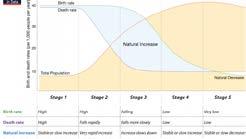
Figure2:(Source:Top3TheoriesofPopulation,Kwatiah)
tionarystage,earlyexpandingphase,lateexpandingphase, lowstationarystage,anddecliningphase.Duringthehigh stationarystage,alsoknownasthepre-transitionstage,both thebirthrateandthemortalityrateremainhigh.Asthe stagerepresentstheperiodbeforetheindustrialrevolution, parentswhoneededmorefamilymemberstosupportthe worktendedtohavemorechildren,whilethehighmortality rateduetopoorhealthserviceskeptthepopulationgrowth lowandstable.Next,duringtheearlyexpandingphase,also knownasthepopulationexplosionstage,thebirthratekeeps onincreasingwhilethedeathratedecreases.Duetoanincreasedsupplyoffoodandimprovementinsanitaryconditions,deathratesstartedtosignificantlyfallwhilebirthrates werestillkepthighduetoaneedformoreworkforcesin thefamily.ThisstageisoftenshowninLeastDeveloped Countries(LDCs).Duringthelateexpandingstage,both thebirthrateandthedeathratestarttodecrease.Aseconomicconditionsgotbetterandtheoveralleducationlevel startedtoincrease,peoplestartedtofavorlessonhavinga childandstartedspendingmoretimeonthemselves.However,thereisstillagapbetweenthedeathrateandthebirth rateduringthethirdstage.Mostofthedevelopingcountries areinthethirdphase.Thelowstationarystageiswhenthe birthratesanddeathratesofcountriesareapproximatelythe same.Duringthisstage,thepopulationsteadilyrises.Most ofthedevelopedcountriesareinthisstage.Duringthedecliningphase,mortalityratesstarttoexceedthebirthrates ofcountries.Duetopeople’swillingnesstohaveasmaller familywithfewerchildren,theelderlypopulationincreases whiletheyoungerpopulationdecreases.Theinformationis alsoshownbelow.
7AnalysisofDifferentModels
Asthispopulationgrowththeoryisbasedonreal-lifeevidence,itdoesnothaveaclearmathematicalformulatofollow.However,becauseitreflectshowsocietyhaschanged overtime,itisoneofthemostwell-acceptedtheoriesofpopulationgrowth.Insituationswheremathematicalcalculationsarerequiredandexactnumbersareasked,theMalthusiantheorymaybethebesttheorytofollow.However,to seetherealchangeinpopulationovertimeinregardtobirth anddeathrates,thedemographictransitionmightbethebest

theorytorelyon.
8Conclusion:TheFutureofMalthusian
Theorem
theorytorelyon.
8Conclusion:TheFutureofMalthusian Theorem
Withourever-evolvingworld,wemayneverseeapop-
RobertMalthushimselfreferencedtheMalthusiancheck-
Withourever-evolvingworld,wemayneverseeapopulationgrowthmodelthatperfectlyreflectsreality;however,thefoundingprinciplesofallproposedtheorieslink twomainconceptstogether—supplyanddemand.Thomas RobertMalthushimselfreferencedtheMalthusiancheckpointasoccurringwhentheeconomicstrainontheeconomy,causedbyscarcity,willleadtostarvationandwar. Manybelievehismodelstillappliesinthecurrentday,usingJapanasanexampleofanationwithmoreresourcesthan peoplethatdemandit.However,wehavealsoseenitfailundermanycircumstances.WhetheritbeinChinawithmassiveunemploymentratesdespitehavingmoreresourcesthan necessarytomaintainitspopulation.Unevenlydistributed wealthandunpredictabilityinthedevelopmentofnations gocompletelyunaccountedforbytheMalthusiantheorem. Asaresult,multiplecriticismsofthemodelhavebeenmade inthecurrentday.Ratherthandiscardthemodelasawhole, scientistsandpoliticiansshouldcometogetherinthefuture inordertoenhancethecapabilitiesofnations’inpopulation management.
References
peoplethatdemandit.However,wehavealsoseenitfailundermanycircumstances.WhetheritbeinChinawithmassiveunemploymentratesdespitehavingmoreresourcesthan necessarytomaintainitspopulation.Unevenlydistributed wealthandunpredictabilityinthedevelopmentofnations gocompletelyunaccountedforbytheMalthusiantheorem. Asaresult,multiplecriticismsofthemodelhavebeenmade inthecurrentday.Ratherthandiscardthemodelasawhole, scientistsandpoliticiansshouldcometogetherinthefuture inordertoenhancethecapabilitiesofnations’inpopulation management.
References
HowPopulationsGrow:TheExponentialandLogistic Equations—LearnScienceatScitable.(2023).Retrieved 29January2023,from
HowPopulationsGrow:TheExponentialandLogistic Equations—LearnScienceatScitable.(2023).Retrieved 29January2023,from https://www.nature.com/scitable/knowledge/library/howpopulations-grow-the-exponential-and-logistic-13240157/ Sachs,J.(2008).AreMalthus’sPredicted1798Food ShortagesComingTrue?(Extendedversion).Retrieved29 January2023,from https://www.scientificamerican.com/article/are-malthuspredicted-1798-food-shortages/ ThomasMalthus.(2023).Retrieved29January2023,from https://ucmp.berkeley.edu/history/malthus.html
ThomasMalthus—Biography,Theory,Overpopulation, Poverty,Facts.(2022).Retrieved29January2023,from https://www.britannica.com/biography/Thomas-Malthus Top3TheoriesofPopulation(WithDiagram).(2016). Retrieved29January2023,from https://www.economicsdiscussion.net/theory-ofpopulation/top-3-theories-of-population-withdiagram/18461
https://www.nature.com/scitable/knowledge/library/howpopulations-grow-the-exponential-and-logistic-13240157/ Sachs,J.(2008).AreMalthus’sPredicted1798Food ShortagesComingTrue?(Extendedversion).Retrieved29 January2023,from
https://www.scientificamerican.com/article/are-malthuspredicted-1798-food-shortages/ ThomasMalthus.(2023).Retrieved29January2023,from https://ucmp.berkeley.edu/history/malthus.html
WhoIsThomasMalthus?.(2023).Retrieved29January 2023,from https://www.investopedia.com/terms/t/thomas-malthus.asp
ThomasMalthus—Biography,Theory,Overpopulation, Poverty,Facts.(2022).Retrieved29January2023,from https://www.britannica.com/biography/Thomas-Malthus Top3TheoriesofPopulation(WithDiagram).(2016). Retrieved29January2023,from https://www.economicsdiscussion.net/theory-ofpopulation/top-3-theories-of-population-withdiagram/18461
WhoIsThomasMalthus?.(2023).Retrieved29January 2023,from https://www.investopedia.com/terms/t/thomas-malthus.asp
12 Investigating Applications of Linear Algebra Concepts in Natural Language Processing
Written by Gyulim Jessica KangInvestigatingApplicationsofLinearAlgebraConceptsinNaturalLanguage Processing(ATLAProject)
GyulimKang
kang782455@sas.edu.sg
TeacherReviewer: Mr.Zitur
Abstract
Abstract
DuetotherapiddevelopmentoftheInternetthroughoutthe 21stcentury,researchersnowhaveanabundanceofinformationattheirfingertips.Thisoverflowofinformationhas producedmanypositiveconsequences—suchasprovidingresearcherswithmoredatatoanalyse,ensuringincreasedaccuracy—butalsopresentsseveralcriticalchallenges,especially inthefieldofnaturallanguageprocessing(NLP).Thisbranch ofartificialintelligencecentersaroundthestructureoflanguage,constructingrulestoestablishintelligentsystemswith theabilitytoextractmeaningfromspeechandtext.Acrucial NLPtechniquewidelyusedtodayislatentsemanticanalysis (LSA),whichdissectstherelationshipsbetweentermswithin asetofdocumentstoproducecommontopics.LSAestablishesthesetopicsfirstbyanalysingwordfrequenciesacross differentdocuments,thenbyperformingsingularvaluedecomposition(SVD).SVDisacrucialstepinLSAthatperformsdimensionalityreductionupontheoriginalmatrixthat depictsthefrequencyofeachwordineachdocumentwithin thecorpus.ThefoundationofSVDlieswithinconceptsin linearalgebra—thestudyofthepropertiesofvectorspaces andmatrices—suchasmatrixfactorization,eigenvalues,and eigenvectors.Linearalgebraformsthebasisofcountlessareasofcomputersciencesuchasmachinelearning,imageprocessing,naturallanguageprocessing,andmore.Thisstudy aimstoinvestigatetheapplicationsofspecificlinearalgebra conceptswithinLSAandtheirlimitations.Finally,thestudy seekstoextendtheseapplicationstogainmoreinsightinto theperformanceofLSAinbroader,real-lifecontextssuchas withininformationretrievalthroughsearchengines.
Keywords: NaturalLanguageProcessing(NLP),Latent SemanticAnalysis(LSA),SingularValueDecomposition (SVD),eigenvalues,eigenvectors
1Introduction
1.1BackgroundandPurposeofResearch
Thepurposeofthispaperistoexploretheimplementationsoflinearalgebraconceptswithinlatentsemanticanalysisindifferentsettingsandanalyzetheirlimitations.The growingprevalenceoftheInternethasproducedarichand accessiblesourceofdataforresearchinunprecedenteddegrees.Asaresult,researchersinthefieldofnaturallanguage processing(NLP)areoftenabletocompilealargecollection ofdocuments—sometimeshundredsofthousands—when investigatingtheirresearchquestions.However,itisoften
thecasethatresearchersarenotabletoindividuallyunderstandandanalyzeeachdocumentduetothemassivesample size.Thischallengehasledtothedevelopmentofkeymachinelearningtechniquessuchastopicmodelingthatare abletoextracttopicsfromasetofdocumentsandclassify documentsintoclustersbasedonthesetopics.
Figure1:Abasicvisualrepresentationoftopicmodeling processes
Theunderlyingprinciplesofmanytopicmodelingtechniquessuchaslatentsemanticanalysisarerootedinlinear algebra.Thispaperwillexaminethestep-by-stepprocess oflatentsemanticanalysis,analyzetheextentoftheuseof certainlinearalgebraconcepts,andfinally,assessthelimitationsoflatentsemanticanalysis.Thispaperassumesa familiaritywithbasiclinearalgebra.
2ExplanationofLatentSemanticAnalysis Process
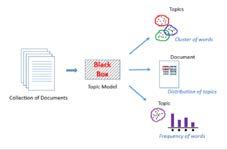
2.1BasicPrinciples
Latentsemanticanalysisislargelyfoundedupontwofundamentalprinciples.Thefirstisthatthemeaningofsentences,documents,andindividualwordsiscalculatedmathematically.The“meaning”ofawordisdefinedasitsaverage frequencyacrossallofthedocumentsitoccursin,andthe meaningofsentencesanddocumentsisdefinedthesumof the“meanings”ofallofthewordstheycontain.Thesecond
principlestatesthatwithinLSA,associationsbetweendifferentwordsandsentencesaredescribedimplicitly(Foltz, 1996).Thismeansthatlatentsemanticanalysiscannotidentifyspecifictopicsbutisabletoorganizedocumentsinto clusterscontainingthemostrelevancetoaspecifictopic.
Overall,theTF-IDFscoreplacesweightsonwordsbased ontheirrarity,ensuringthatmoresignificanceisplaced uponthewordsthatoccurfrequentlywithinadocument butinfrequentlyacrossthecorpus,ortheentiresetofdocuments.AhighTF-IDFscoreisachievedifthetermappears frequentlyinaspecificdocumentbutlessfrequentlyacross thewholecollectionofdocuments.
2.3SingularValueDecomposition
ThenextstepofLSAinvolvesreducingthedimensions oftheterm-documentfrequencymatrix.Thisisanimportantstepoftheprocessbecauselarge,complexdatasets oftencontainhigherdimensionsthataremoredifficultfor thecomputertoprocessandinterpret(“Singularvaluedecomposition”,2017).SVDisaprocessthatcanoptimizethe amountofinformationpreservedwithinthematrixwhile stillloweringthedimensiontoenablefasterandmoreaccurateanalysis.Thedecompositioncanbeexpressedinthe form A = UΣV T ,where U and V areorthogonalmatrices and Σ isadiagonalmatrix.
2.2InitialSteps
ThefirststepwhenperformingLSAistoconstructatermdocumentfrequencymatrix.Therowsarerepresentedby eachuniqueword,andthecolumnsarerepresentedbyeach documentwithinthecorpus.Theentryattheintersection ofrowiandcolumnjwillberepresentedbythetermfrequencyvalueofwordiwithindocumentj.Thisfrequency canbecalculatedinmultipleways,butthepreferredmethod istouseTermFrequency-InverseDocumentFrequency.
wi,j = tfi,j × log ( N dfi )
Theequationabovedescribesthemethodusedinlatent semanticanalysistocalculatetheTermFrequency-Inverse DocumentFrequency(TF-IDF)score,whichistheproducttwostatistics:termfrequencyandinversedocumentfrequency. tfi,j representstermfrequency(TF)and log ( N dfi ) representsinversedocumentfrequency(IDF). tfi,j denotes therawnumberofoccurrencesofword i indocument j , dfi denotesthenumberofdocumentscontainingword i, and N denotesthetotalnumberofdocumentswithinthe dataset.Sincethetermfrequencycountsonlythenumber ofoccurrencesofawordwithineachdocument,theinverse documentfrequencywasincorporatedtooffsettheincorrectemphasisthatmaybeplacedoncommonwordssuchas “a,”“an,”“the,”“she,”and“they”withoutgivingsufficient weighttomoremeaningfulwords.Thisisbecausehigher frequencydoesnotalwayswarranthighersignificance(Kaur &Kaur,2021).
Theinversedocumentfrequencyisobtainedbytakingthe logarithmoftheresultwhendividingthetotalnumberof documentsbythenumberofdocumentscontainingtheterm. Itisimportanttonotethatthisquotient (Ndfi ) willalways begreaterthanorequalto1;asaresult,theIDFandTF-IDF scorewillapproach0asthetermappearsinmoredocuments andthequotientapproaches1.
Figure3:ArepresentationoftheprocessofSVDleadingup todimensionalityreduction
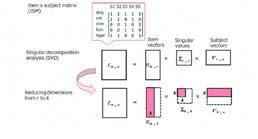
U and V representrotationsand Σ representsadilation ineachcoordinatedirection.RotationsanddilationsareexamplesoflineartransformationsandareutilizedinSVDto reconfigurethedimensionsoftheoriginalterm-document frequencymatrix.Bythedefinitionofanorthogonalmatrix, UT = U 1 (theinverseof U)and V T = V 1 .SVD isacrucialstepwithintheprocessoftopicmodellingbecauselarge,complexdatasetsoftencontainhigherdimensions,makingthemsparse;theyarealsonoisy,meaningthat theycontainmanylow-frequencywords.Thesecharacteristicsmakeitmoredifficultforthecomputertoprocessandinterpretthedocumentstoproduceacommonsetoftopicsand documentclusters.SVDoptimizesthepreservationofvaluableinformationwhilereducingdimensionsforfaster,more accurateanalysis(Kherwa&Bansal,2017).Weareableto findmatrix U byfindingthediagonalizationsof AT A:
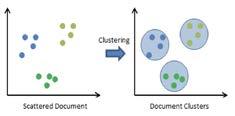
First,theeigenvaluesmustbederivedusingthefollowing equation: det(A λI)=0.Afterfindingthecorresponding eigenvectors,theymustbeorganizedindescendingorder. Thecolumnsof U willbetheeigenvectorsof A.Theeigenvectorsmustalsobenormalized,meaningthateachtermin thevectorshouldbedividedbythevector’smagnitudeto scaleittoaneigenvectorthathasaunitlengthof1.Next,we canfind Σ :thediagonalentriesareequivalenttothepositivesquarerootoftheeigenvaluesorganizedindescending order.
Finally, V canbefoundusingthefollowingequation:
0 65520174 0 75545396
0 755453960 65520174
Thediagonalentriesof Σ willbeequivalenttothesquare rootsofthetwopositiveeigenvalues(whichwere5(3+)and 5(3-))indescendingorder:
5.398345640 00 92620968
Finally,wefind V usingthefactthat V = A 1 UΣ, then normalize:
0 923880 382683
0 382683 0 92388
Nowthatwehaveallthreematrices—U, V ,and Σ—we willbeabletoconstructourSVDfactorization(UΣV T )of matrix A:
0 65520174
0 75545396
0 755453960 65520174
5 398345640 00 92620968
Thevectorsof V mustalsobenormalized.
Thefirststepwouldbetofindthediagonalizationsof AAT and AT A tofindmatrices U and V ,respectively.
0.923880.382683 0.382683 0.92388
3ApplicationofLSA 3.1Walkthrough
Toapplytheseconceptsinareal-life,adatasetonKaggle waschosenthatcontainedinformationaboutvariousnews articlesacrossarangeofmediaoutlets—includingtheNew YorkTimes,CNN,andmore—fromtheyears2016to2017. ThefeaturesofthedatasetincludedtheID,title,publication, author,date,year,month,URL,andfulltextofeacharticle.
Thecharacteristicpolynomialof AAT isthefollowing:
Usingthequadraticformula,wecandeducethatthe eigenvaluesof AAT are5(3+22)and5(3-22).Thecorrespondingeigenvectorsarethefollowing: 1+5√2 7 1 5√2 7
Arrangingtheeigenvaluesindescendingorder,wearrive atthefollowingmatrixfor U (thisisbeforenormalizing):
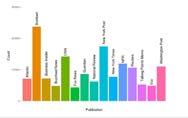
1+5√2 1 5√2 77
Afternormalizing,wegetthefollowingfinalmatrixfor U:
Figure4:Publicationsrepresentedwithindataset Fortheanalysis,themainfocuswasonthe“title”and “content”columns,asthesewerethecolumnsthatcontained informationmostrelevanttothetopicscoveredwithinthe article.Beforeconstructingthewordfrequencymatrix,the datasetwaspre-processedtoremoveextraneousinformation suchaspunctuation,numbers,orarticles(eg.‘a’)thatdonot contributemeaningtothearticle’scontentandriskhindering accuracyofanalysis.
1 stop_words= set(stopwords.words(’ english’))
2 newHeadlines=[]
3
4 for x in headlines:
5 x=x.lower()
6 x=x.replace(" " , "")
7 x=x.replace(" " , "")
8 for character in string.punctuation:
9 x=x.replace(character, ’’)
10 x=x.replace("the new york times", ’’)
11 x= ’’.join(c for c in x if not c. isdigit())
12 x=x.strip()
13 newHeadlines.append(x)
Afterward,thenextstepwastoconstructthetermfrequencymatrixandperformtheSVDfactorization,respectively.Thiswasachievedbyusingthebuilt-infunctionsof theScikitLearnlibrary,aPythonlibrarythatcontainsmany usefulmachinelearningtoolssuchasdimensionalityreduction,regression,andmore.
1 tfidfvectorizer=TfidfVectorizer( analyzer=’word’,stop_words= ’english’ )
2 tfidf_wm=tfidfvectorizer.fit_transform (df[’New Headlines’])
3 tfidfvectorizer1=TfidfVectorizer( analyzer=’word’,stop_words= ’english’ )
4 tfidf_wm1=tfidfvectorizer1. fit_transform(df[’New Content’])
5 svd=TruncatedSVD(n_components=100)
6 lsa=svd.fit_transform(tfidf_wm)
Afterconstructingtheterm-documentmatrices,wecan observethefeatures—theuniquewordsthatcomprisethe rowsofthematrices.Thefeaturescanbederivedusingthe codebelow.
Figure6:Constructingtheterm-documentfrequencymatrix containingtheTF-IDFscoresforeachtermwithintheTitle andContentcolumns
1 dictionary=tfidfvectorizer. get_feature_names()
2 print(dictionary)
3.2Results
Afterward,documentclusterswereidentifiedbyimplementingadditionalcode.Beforeobservingtheclusters,the silhouettescoresoftheclusterswerereviewedtoconfirm howeffectivelythedocumentclusterswerecreated.Viewing thesilhouettescoresenablesustoassesstheperformanceof theLSAmodelonthedatasetanddeterminewhetherspecificconditions(suchasthoseinpre-processing)mustbe adjustedtoobtainthedesireddegreeofaccuracy.
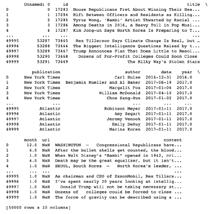
1 s_list=[]
2
3 for clus in tqdm(range(2,21)):

4
5 km=KMeans(n_clusters=clus,n_init =50,max_iter=1000) # Instantiate KMeans clustering
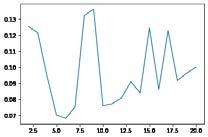
6
7 km.fit(lsa) # Run KMeans clustering
8
9 s=silhouette_score(lsa,km.labels_ ) 10
11
s_list.append(s)
12 plt.plot(range(2,21),s_list)
13 plt.show()
Thisplotshowsthatmostofthesilhouettescoresare onthehigherendofthescale,suggestingthatmostofthe
clustersarelinearlyseparableorthereislittletomoderate amountofoverlapsamongthem.Toverifythisresult,aTdistributedStochasticNeighborEmbedding(TSNE)scatterplotwascreated.ATSNEscatterplotenablesustoview higher-dimensionaldatainalowdimensionalspace—in thiscase,two-dimensionalsincetheplotcontainstwo axes—whilepreservingtheoverallstructure.Thismeans thatsimilarpointsthatareclosetoeachotherinthehigherdimensionalspacewillalsobeclosetogetherintheTSNE scatterplot.


datasetandverifytheaccuracyofthevisualizationscreated above(Appendix).
4Extension
4.1Walkthrough
Inordertoextendthisapplicationandinvestigateacommonreal-lifeuseofLSA—informationretrievalthrough searchengines—asearchenginewascreatedbasedonthe samedataset.LSAisanidealtechniquetoutilizeforcreatingsearchenginesasitdoesnotrelyonkeywordsearches, meaningthatonlyresultscontainingtheliteralkeywordsinputtedintothesearchenginewillappear,butratheronsemanticsearches.Thisallowsthesearchenginetoreturnrelevantresultswithoutnecessarilycontainingtheexactwords inputted.
Usingtheterm-documentmatrixforthe‘content’columnthatwascreatedpreviouslyintheApplicationsection, awordcloudwasconstructedtoobservethewordsthatoccurredthemostoften.
Althoughmostoftheclustersarerepresentedwiththe colorpink,makingthedistinctionsbetweenclustersabit difficulttodiscern,itcanbeseenthatmostoftheclusters areorganizedinanorderlymannerofcircularshapesrather thanbeingspreadout.Figure9,whichdepictsLSAperformeduponaverysmallsetofdocuments(thereforedirect topicassignmentwaspossible),illustratesthisdifference;it canbeobservedthatwhilethedocumentspertainingtothe green,purple,blue,andredtopicsareclusteredinarelativelyorderlyway,thedocumentspertainingtotheorange topicareveryspreadout.Thisexplainsthereasonwhythe majorityofthesilhouettescoresforthisdatasetareonthe lowerendofthescale.
Tobegincreatingthesearchengine,afunctioncalled search resultswasconstructed.Thisfunctioninvolvedusing theterm-documentmatricescontainingeachterm’sTF-IDF scoreforeachdocumenttocompilealistofthearticlesthat containedwordswiththehighestsimilaritytothosewithin thesearchquery.
ThePythonlibraryprimarilyusedforthisextension wasGensim,whichcontainsnumerousfunctionsfordocumentindexing,topicmodeling,andsimilarityretrievalwith largecorpora.TheMatrixSimilarityfunctionseenbelow calculatesthesimilarityofeachfeature—termsanddocuments—withinthecorpusagainsttheotherandstoresthis informationinanindexmatrix;wewillusethismatrixlater tocomparethesimilaritiesofthewordswithinoursearch querytothesefeatures.
1 from gensim.similarities import MatrixSimilarity
3.3LimitationsofLSA
AkeylimitationofLSAisthatitdoesnotdeterminespecifictopicsfromasetofdocumentsasitisanunsupervised algorithm.Asaresult,itismainlyutilizedtoclustersimilar documentstogether.Additionaltopicmodelingtechniques thatarenewertothefieldofNLPsuchasBERTopicleveragesTF-IDFtocreateeasilyinterpretabletopicsandkeywordswithineachtopicdescription.TheBERTopictechniquewasutilizedtoconductamorein-depthanalysisofthe
2 articleIndex=MatrixSimilarity(lsa1, num_features=lsa1.num_terms)
Afterwritingthecodethatwouldanalysethetermswithin thesearchqueryandfetchthemostrelevantarticles(by identifyingthetermswithintheTF-IDFterm-documentmatrixthenusingtheresultstoinvestigatethesimilaritiesof thetermstoothertermsanddocumentsthroughtheindex matrix),thesearchengineprintedthelistofthefivemost relevantarticlesalongwiththepercentageofrelevanceusingthesimilarityvaluefromtheindexmatrix.

4.2Results
Thefollowingfiguredepictsasamplequeryanditssearch resultsfromthesearchengine.Althoughsomeofthearticles didnotexplicitlycontainthewordswithinthequeries,these articlesstillcameupasresultsbecausetheycontainedthe wordsmostsimilartothewordsinthequery.
References
Carlsson,Gunnar.”Topologyanddata.”Bulletinofthe AmericanMathematicalSociety46.2(2009):255-308. Garin,A.,&Tauzin,G.(2019,December).Atopological” reading”lesson:ClassificationofMNISTusingTDA.In 201918thIEEEInternationalConferenceOnMachine LearningAndApplications(ICMLA)(pp.1551-1556). IEEE.
Koplik,G.(2022,June16).Persistenthomology:A Non-MathyIntroductionwithExamples.Medium. RetrievedJuly5,2022,from https://towardsdatascience.com/persistent-homology-withexamples-1974d4b9c3d0
Uponafurtherinvestigationintotheseresultsbyreading thearticlecontent,itwasobservedthatallofthearticles weresufficientlyrelevanttotheinputtedsearchqueries.To furthertesttheperformanceofthesearchengine,however, itmaybebeneficialtoinputlonger,morecomplexphrases (eg.“impactofcontroversialartongalleriesnationwide”, “statisticsofhatecrimes”,etc.)toobservewhethertheresultsarerelevantnotonlytothespecificwordswithinthe querybuttheoverallmeaningofthequery.

5.1Summary
5Conclusion
Insummary,eigenvaluesandeigenvectorshavenumerous applicationswithinthefieldofNaturalLanguageProcessingthatformthebasisofLSA,aprominenttopicmodelling technique.SingularValueDecompositionisakeyprocess baseduponlinearalgebraconceptsthatisutilizedwithin LSAtoperformdimensionality.LSAhasseveralimportant advantagesanddisadvantages.Byanalysingareducedrepresentationoftheoriginalterm-documentfrequencymatrix (throughSVD)thatpreservesthecorrelationoftermsbetweendocuments,LSAisabletoensuretheaccuracyofits analysistosomeextent.However,somedisadvantagesare thatLSAisnotabletoexplicitlydescribetopicswithinthe corpusandthatitsaccuracycandiminishovertimeasthe sizeofthecorpusincreases.SomelimitationsofthisinvestigationarethatadditionalapplicationsoflinearalgebraconceptsintopicmodellingsuchasNon-negativeMatrixFactorization(NMF)werenotcoveredindetail.Theevaluation ofthesearchengineresultscouldalsohavebeenmorecomprehensivebyinvestigatingthesearchengine’sperformance basedonmorediverse(eg.inlength,complexity,andtopic) searchqueries.Thefieldoftextualanalysisisever-evolving, andtherearenumerouscomplexandinnovativemethodsregardingtheautomationofthisanalysisthatcanbeexplored.
Infuturestudies,IwouldliketodivefurtherintoNMFand experimentwithusingdifferentsearchqueriesonsearchenginescreatedusingLSAtoovercomethelimitationswithin theinvestigationofthecurrentstudy.
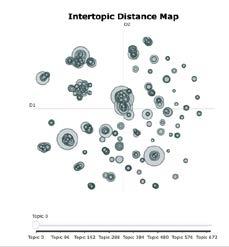
Otter,Nina,etal.”Aroadmapforthecomputationof persistenthomology.”EPJDataScience6(2017):1-38. Talebi,S.(2022,June17).PersistentHomology.Medium. RetrievedJuly6,2022,from https://medium.datadriveninvestor.com/persistenthomology-f22789d753c4
Tauzin,Guillaume,etal.”giotto-tda::ATopologicalData AnalysisToolkitforMachineLearningandData Exploration.”J.Mach.Learn.Res.22(2021):39-1. Zomorodian,Afra,andGunnarCarlsson.”Computing persistenthomology.”Discrete&ComputationalGeometry 33.2(2005):249-274.
6Appendix
FigureA1:Plotrepresentingsimilaritiesbetweentopics Itcanbeobservedthattheclustersoftopicsare well-organized,whichalignswiththehighsilhouettescores thatwearrivedatpreviouslyusingLSA.Thebarchart belowshowsthemostcommontopicsandtheirkeywords.
FigureA2:Commontopicsbarchart Forexample,wecaninferthatTopic0isrelatedto healthcare,Topic2isrelatedtopoliceand/orpolice violence,Topic3isrelatedtofirearmsandfirearm-related policies,andsoon.
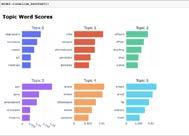
13 Creating a Machine Learning Pipeline To Perform Topological Data Analysis
Written by Gyulim Jessica KangCreatingaMachineLearningPipelineToPerformTopologicalDataAnalysis
GyulimKang
kang782455@sas.edu.sg
TeacherReviewer: Mr.Son
Abstract
Abstract
Inappliedmathematics,topologicaldataanalysis(TDA)utilizesconceptsfromtopologytoextractqualitativefeatures fromdatasuchasitsshape.TDAhasavarietyofapproaches toextractstructurefromunstructureddata,orpointclouds, anditiswell-suitedforhigh-dimensionalandnoisydatasets. Pointcloudsareafinitesetofpointswithinthedata,and persistenthomologyisusedtorepresentthedataasasimplicialcomplex:acomplexofsimplexes,ortrianglesgeneralizedinmultidimensionalspaces.ThefirststepofTDA involvesrepeatedlyusingfiltrationonthepointcloudtoarriveatafilteredcomplex.Second,thekeytopologicalfeaturesofthefilteredcomplex—thenumberofconnectedcomponentsandholes—areanalyzedthroughpersistenthomology.Finally,thetimelineofthebirthanddeathoftopological featuresthroughouttheprocessoffiltrationisdisplayedina persistentdiagram.Thecomputationofpersistenthomology isafast-evolvingareawithnumerousintriguingchallenges; newalgorithmsandsoftwareimplementationsinthefieldare beingupdatedandreleasedrapidly.Premisedontheideathat theshapeofdatasetscontainsrelevantinformation,TDArepresentsapromisingbridgebetweentopologyanddatascience thatwarrantsfurtherexploration.
Keywords: TopologicalDataAnalysis(TDA),pointcloud, simplicialcomplex,Vietoris-Ripscomplex,persistenthomology,persistencediagram,filtration,vectorizationmethods
1Introduction
1.1BackgroundandPurposeofResearch
Thispaperexplorestopologicaldataanalysis,anon-therisedatasciencetool,anditsapplicationsinmachinelearning.ThegrowingprevalenceoftheInternethasproduced arichandaccessiblesourceofdataforresearchtounprecedenteddegrees.Theapplicationofpersistenthomologyindatascienceprovidesarobusttheoreticalfoundation foramathematicallyrigorousanalysisofshapewithindata (Carlsson,2009).Theshapeofthedatacanbeinterpreted inseveralformsdependingonthetypeofdata.Forexample,let’ssaywehavedataconsistingofafinitenumberof pointsscatteredinthecoordinatespace;younaturallystart thinkingabouthowthesepointsareroughlyshapedorclustered.Thisissimilartohowwelookupatthestarsinthe nightskyandseeconstellationsintheshapesofpolarbears
orscorpions.Thatisbecauseitisoneofourhumantendenciestoextractfamiliar,meaningfulshapesfromseemingly randomandscattereddata.Hereisanotherexample:ifyou havehandwrittenimagedata,youcanenvisioncharacteristicssuchashowmanyholesthereareinthenumbers.TDA aimstoencodethepersistenthomologyofadatasetinanaccessiblevisualrepresentationcalledthepersistentdiagram. Theprinciplesoftopologicaldataanalysisarerootedinpersistenthomologyandthepremisethattheshapeofadataset containsrelevantinformation.Thispaperwillexaminethe frameworkofTDA,provideexamplesofTDAresultson variousdatasets,andanalyzeitsapplicationsinmachine learningalongwithitslimitations.
2KeyDefinitions
2.1PointClouds

Let’ssayourdataisgivenasafinitesetofpointsinEuclideanspaceRd.Wecallthissetofpointsapointcloud. Forexample,asetcontainingeachreflectionofalaserpulse fromalidarformsa3-dimensionalpointcloudwith(x,y, z)coordinates.Asetofpointsmightappeartoberandomly scatteredonthesurface,buttheremightbesomehiddengeometric,ortopologicalpatterns.Ultimately,TDAuseshomologytoanswermeaningfulquestionssuchas‘Howcan weidentifygeometricfeaturesfromdata?’and‘Howdowe knowthatthesegeometricfeaturesaresignificant?’
2.2SimplicialComplex
Asimplexisthegeneralizationofatriangle,thefundamentalshapeofgeometry,inmultidimensionalspaces.For example,a0-simplexisapoint,a1-simplexaline,a2simplexatriangle,a3-simplexatetrahedron,andsoon(Koplik,2022).WithinTDA,wecanusepersistenthomology
totranslatedataintoacollectionoftriangles:asimplicial complex.Theformaldefinitionofasimplicialcomplexisas follows,satisfyingthetwoconditionsbelow:Everyfaceof asimplexfromKisalsoinK.Thenon-emptyintersection ofanytwosimplices ϵ1 , ϵ2 inKisafaceofboth ϵ1 and ϵ2 WhenperformingTDA,weusethefollowingstepsto transformthedatasetintoasimplicialcomplex.First,we plotourdatainanN-dimensionalspace,withadimension foreachuniquevariable.Second,wechoosearadius ϵ and drawanN-dimensionalballofradius ϵ aroundeachdata pointinthepointcloud.Third,iftwoballsoverlapweconnectthecorrespondingpointswithaline,ora1-simplex. Ifthreeballsoverlap,wefillintheareabetweenthemto formatriangle,ora2-simplex.Thiscontinuesinthesame patternforsubsequentintersectionsandsimplices.Through thesimplicialcomplex,wecanderivethehomologygroup, composedofconnectedcomponents,holes,andcavities. H0 commonlyrepresentsthegroupofconnectedcomponents, H1 thegroupofholes,and H2 thegroupofcavities.A naturalquestionarises:Howarewesupposedtoknowthe bestradiusattheoutset?Thisiswherepersistenthomology comesin.
2.3Vietoris-RipsComplex
TheVietoris-RipsComplexisawayofformingatopologicalspacefromdistancesinasetofpoints(Garin&Tauzin, 2019).Inotherwords,wecreateasimplicialcomplexthat canbedefinedfromanydistance δ byformingasimplex foreveryfinitesetofpointsinthedatathathasadiameter atmost δ .Formally,weconstructaVietoris-Ripscomplex throughthefollowingprocess:
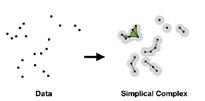
1.Drawacirclearoundeachpointwitharadiusof ϵ.
2.If ϵ isgreaterthanthedistancebetweenpointsiandjin thepointcloud,inotherwords,iftheintersectionoftwo circlesincludesboththeircenters,weconnectthetwo centerpointswithalinesegment.

3.Ifthreepointsformatriangle,wefillintheareatocreate a2-simplex.

Below,wewillcreateaplotofourowntoanalyzethrough TDA.First,weuseNumpyarraytogenerate8random pointsforourpointcloud.
Lookingatthischart,wecanthinkaboutwhatgeometricintuitionwecangainfromthecollectionofpoints.For example,itmayappearthatthefourdotsclusteredatthe topleftoftheplotaregoingtoformasquare.Inthisway,

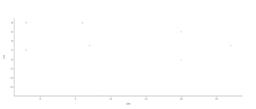
humansstrivetoextractfamiliargeometricshapesfromrandomcollectionsbyconnectingpointsthatareclosetoeach other.Theapproximationoftopologicalspacefromthepoint cloudwiththissimpleideaiscalledtheVietoris-RipsComplex.
Thescreenshotsaboveshowcasethetransformationofthe simplicialcomplexastheepsilonvaluegetslarger:overlap increases,andmoreconnectedcomponents(H0 )andholes (H1 )arebirthedinthecomplex.Itcanbeobservedfromthe diagramsthattrianglesandedgesappear,merge,anddisappearwiththechangeofepsilon.Additionally,thetotalnumberofcomponentsdecreasesovertime;if ϵ issufficiently large,therewillonlybeoneunitedconnectedcomponent remaininginthesimplex.Insummary,thenumberofcomponentsandholescanbeimportantindicatorsofkeygeo-
metricfeatures,andwecanobtainthembycomputingthe homologyofthecomplex.
Byvisualizingthecomplexes,weareabletogaingeometricintuition.However,itisdifficulttodeterminewhichepsilonvaluebestrepresentstheshapeofdatamerelythrough observation.Foreveryepsilon,wemustbeabletosummarizehowthenumberofcomponentsandholesarebeingchanged.Persistenthomology,analgebraicmethodfor computingtopologicalfeaturesinaspace,allowsustodo this(Otteretal.,2017).Itistheconceptofmeasuringwhich featuresarebornanddiefromthecomplexastheepsilon value,orradius,changes.Persistenthomologyistheprimary methodusedinTDAtostudyqualitativefeaturesofdata thatpersistacrossmultiplescales.Ithasmanyadvantages aswell;itisrobusttoperturbationsofinputdata,independentofdimensionsandcoordinates,andprovidesacompact representationofthequalitativefeaturesoftheinput.
3TDAFramework
3.1Filtration
TheinitialstepofTDAistorepeatedlyusefiltrationtoarriveatafilteredcomplex.Filtrationisdefinedastheprocess ofadjustingtheparameterofepsilon,ortheradius,toassess changesinthedataset.Filtrationhasnumerousapplications inreallife,includingheightfiltrationonimages.Performing heightfiltrationallowsustoconductimagesegmentation. Forexample,inthepictureofwoodcellsbelow,wecanuse heightfiltrationtoextracttheconnectedcomponents(inthis case,individualcells)fromtheimage.Althoughimperfect, thisalgorithmhasahighlevelofaccuracy;thisisimpressive consideringonlyafewparameters,suchastheblurparameter,needtobeadjusted.
3.2PersistenceDiagram
Apersistentdiagramrepresentsthebirthanddeathof connectedcomponentsandholesofaVietoris-Ripscomplexthroughoutthechangeofepsilon.Inordertoconstruct thediagram,persistenthomologytrackswhentwoballsof radiusepsilon,eachcenteredaroundapointonthepoint cloud,intersect.Apointisaddedtothediagramwhenthe ballinoneconnectedcomponentfirstintersectsaballof anotherconnectedcomponent,becausethemergingoftwo connectedcomponentssignifiesthedeathofoneofthem. Thefinalremainingsimplexdiesatinfinity.Apointlocated nearthediagonalmeansthatthisfeaturediedalmostimmediatelyafteritwasborn.Inotherwords,thismeansthat thefurtherthefeatureislocatedabovethediagonal,the greateritspersistence.Highpersistencefeaturesaregenerallythoughttobestatisticallysignificant,whilelowerpersistencefeaturesmorerepresentativeofstatisticalnoise.
ComparingTwoPersistentDiagrams(bottleneck/Wassersteindistance)Whencomparingthepersistentdiagramsof twopointclouds,weareabletoutilizemetricssuchasthe Wassersteindistance.TheWassersteindistanceisadistance functionbetweenprobabilitydistributionsonaparticular metricspaceM.Thismetriccomparestheprobabilitydistributionsoftwodifferentvariables,whereonevariableis derivedfromtheotherbyrandomordeterministicperturbations.
Now,wewilltryexperimentingwithusingTDAandpersistencediagramstodiscriminatebetweentwopointclouds extractedfromdistributionsthatlooksimilartothenaked eyebutare,inreality,completelydifferent.

Thefirstpointcloudconsistsof200pointsextractedfrom aGaussiannormaldistribution.Therefore,statistically,the geometricinformationofthispointcloudwillbesimilarto thegeometricinformationthatanormaldistributionsurface wouldhave.
Thesecondpointcloudconsistsof200pointsscatteredby


firstrandomlyselecting200anglesandapplyingconstant noisetotwoadjacentcircles.Althoughthesepointclouds werecreateddifferently,it’sdifficulttodistinguishbetween thetwopointcloudstodeterminewhichwascreatedthrough whichdistribution.Nowwewillseeifwecanobserveadistinctpatternwithintheirrespectivepersistentdiagrams.One differencethatcanbeobservedisthatinthesecondpersistentdiagram,unlikethefirst,thepersistenceoftheH1group isespeciallystrong.
Regardingtheapplicationofpersistentdiagramsinmachinelearning,however,persistentdiagramsaren’tsuitable foruseasinputvectorsbecausethenumberofpointsconstitutingthediagramwilldifferdependingontheimage.In otherwords,eachdatasetwillberepresentedasavectorofa differentdimension.Asaresult,itisnecessarytotransform thepersistentdiagramintoavectorofsomefixeddimension byusingvectorizationmethodssuchasHeatKernel.
4SampleApplicationinMachineLearning
VectorizationMethods(HeatKernel)Onevectorization methodoftenusedinTDAisHeatKernel.Givenapersistencediagrammadeupofthetriples[b,d,q]representing birth-death-dimension,subdiagramscorrespondingtovarioushomologydimensionsaretakenintoaccountindividuallyandseenassumsofDiracdeltas.Then,arectangular gridoflocationsuniformlysampledfromsuitableranges ofthefilteringparameterisusedtoperformtheconvolutionusingaGaussiankernel.Thereflectedpicturesofthe subdiagramsaroundthediagonalareprocessedinthesame way,andthedifferencebetweentheoutputsofthetwoconvolutionsiscomputed.A(multi-channel)rasterpicturecan becomparedtotheoutcome.MachineLearningPipeline MNIST:Binarization → Filtration → PersistentDiagram Thispipelineusesamixofvariousfiltering,distancemetrics(eg.Wasserstein,bottleneck),andvectorizationmethods includingHeatKernel.Thispipelinecanbeusedtoperform
efficientmachinelearningandTDAanalysisonthetraining data.What’snoteworthyisthatwhenweusethispipeline, we’renolongerusinganyinformationfromtheimagepixels themselves.Instead,we’reonlyusingthetopologicalfeaturesoftheimagedataseenfrommultipleperspectives.
5Conclusion
Inconclusion,persistenthomologyhasmanyapplications indatascience.Persistenthomologyistheprimarymethod usedinTDAtostudyqualitativefeaturesofdatathatpersistacrossmultiplescales.Ithasalotofadvantagestoo;it’s robusttoperturbationsofinputdata,independentofdimensionsandcoordinates,andprovidesacompactrepresentationofthequalitativefeaturesoftheinput.Forfuturework,I wouldliketodivedeeperintothemathematicalbackground ofpersistenthomologyalongwiththevariousapplications ofTDAinreallife.
References
Carlsson,Gunnar.”Topologyanddata.”Bulletinofthe AmericanMathematicalSociety46.2(2009):255-308. Garin,A.,Tauzin,G.(2019,December).Atopological” reading”lesson:ClassificationofMNISTusingTDA.In 201918thIEEEInternationalConferenceOnMachine LearningAndApplications(ICMLA)(pp.1551-1556). IEEE.
Koplik,G.(2022,June16).Persistenthomology:A Non-MathyIntroductionwithExamples.Medium. RetrievedJuly5,2022,from https://towardsdatascience.com/persistent-homology-withexamples-1974d4b9c3d0
Otter,Nina,etal.”Aroadmapforthecomputationof persistenthomology.”EPJDataScience6(2017):1-38. Talebi,S.(2022,June17).PersistentHomology.Medium. RetrievedJuly6,2022,from https://medium.datadriveninvestor.com/persistenthomology-f22789d753c4
Tauzin,Guillaume,etal.”giotto-tda::ATopologicalData AnalysisToolkitforMachineLearningandData Exploration.”J.Mach.Learn.Res.22(2021):39-1. Zomorodian,Afra,andGunnarCarlsson.”Computing persistenthomology.”DiscreteComputationalGeometry 33.2(2005):249-274.


Evaluating Affirmative Action in School Choice: Comparing Mechanisms with Minority Reserves
Written by Gyulim Jessica KangEvaluatingAffirmativeActioninSchoolChoice:ComparingMechanismswith MinorityReserves
GyulimKang
kang782455@sas.edu.sg
TeacherReviewer: Mr.Son
Abstract
Intheeconomictheoryoftwo-sidedmany-to-onematching,a particularproblemofinterestisthemechanismofschoolassignment.Eversincethedeferredacceptancealgorithmwas firstproposedbyGaleandShapley(1962),therehasbeen muchresearchaboutmechanismsthatoptimallymatchstudentstoschoolsinreal-worldsituations.PathakandSönmez(2013)triedtoincorporatetruncatedpreferencesintothe existingmatchingframework,whereasHafalir,Yenmezand Yildirim(2013)consideredreservesforminoritystudents.In thispaper,weexploretherelativelyundevelopedareaoftruncatedpreferencesinschoolmatchingwithminorityreserves. Specifically,wepresentanovelframeworkformechanism analysiswithminorityreservesandcomparemechanismsby theirstability,Paretooptimality,andvulnerabilitytomanipulation.OurresultsshowthattheoldChicagomechanismis atleastasmanipulableasanyotherstablemechanismandis strictlymoremanipulablethantheserial-dictatorshipmechanism.
Keywords: Gale-Shapleyalgorithm,marketdesign,mechanismdesign,schoolchoice,truncatedpreferences
1Introduction
Givenasetofmenandwomenwhosepreferencesarein theoppositegender,howshouldweformpairssuchthatno agenthastheincentivetorematch?ThisquestionwasoriginallyproposedandansweredbyGaleandShapleyin1962; sincethen,thesolutionstothevariantsofthequestionhave beenappliedtoschoolchoice,medicalresidencymatching, andtheassignmentofcadetstomilitarybranches.Galeand Shapleytriedtofindaone-to-onestablematching(asetof pairingsinwhich(1)allmenandwomenfindtheirpartners acceptableand(2)noman/womanpairpreferseachotherto theirassignedpartners).Byaprocesscalledthedeferredacceptancealgorithm,GaleandShapleyprovedthatastable matchingexistsforanyfinitesetofmenandwomenandtheir preferences.Thealgorithmisdescribedasfollows:
1)Eachmanproposestohismostpreferredwoman.Each womanselectshermostpreferredmanoutofthosewho proposedtoherandputshimonherwaitinglist;therest arerejected.
2)Eachmanthatwasrejectedproposestohisnextpreferredwoman.Eachwomanselectshermostpreferred
manamongthosethatproposedtoher,includingtheman onthewaitinglist.
3)RepeatStep2untilnomenwhoareavailabletopropose areleft.
GaleandShapleyprovedthatthematchingobtainedatthe terminationofthealgorithmisstable.Forexample,consider thefollowingsituationwith5menand4women:
����5 wouldratherstaysinglethanbematchedwith
.Assumethatthepreferencesofthewomenareasfollows:
Ifweapplythedeferredacceptancealgorithmtothisspecificexample,
,whoonlyholds
proposeto ����4 ,whoonlyholds ����2 .Thisyieldsa tentativematching
Inaddition,eachmanweaklyprefershismatchunderthe deferredacceptancealgorithmcomparedtoanyotherwoman thathecouldhavebeenmatchedtoinanotherstablematching.AdditionalpropertiesofthedeferredacceptancealgorithmincludeParetooptimality,whichdescribestheexistenceofamatchingwherethereisnoothermatchingthat makessomeagentsbetteroffwithoutmakinganyoneworse off,andmanipulability,whichisequivalenttoanagent’sabilitytoprofitfromamechanismbymisrepresentinghispreferences.
1.1IntroductiontoSchoolChoiceContext
Aninterestingapplicationofthedeferredacceptancealgorithmisthatmanyofitsconsequencescanbeextendedto many-to-onematchings;examplesincludesituationswhere anagentononesideismatchedtomorethanoneagenton theotherside,suchastheinternshipassignmentproblemor collegeadmissionproblem.
Applicationsofmatchingsinschoolchoicehavebeen madetomimicreal-lifescenarios.Ehlers,Hafalir,Yenmez, andYildirimstudiedcontrolledchoiceoverpublicschools; Benabbou,Chakraborty,Ho,Sliwinski,andZickinvestigatedtheimpactofdiversityconstraintsonpublichousing allocation.PathakandSönmezcomparedvariousmechanismsbytheirsusceptibilitytomanipulation.
Thispaperisstructuredasfollows.InSection2,wewill comparemultiplematchingalgorithmsthatareknownto recordtruncatedpreferencesunderdiversitysituations.More specifically,wewillbediscussingfactorsincludingstableness,manipulability,andParetooptimalityforeachmechanism.
2GeneralFramework
Wefirststartwithsometraditionaldefinitionsoftenused inthemarketdesigntheoryofschoolchoice.
1.afinitesetofstudents ���� = ����1 ,...,�������� ;
2.afinitesetofschools ���� = ����1 ,...,�������� ;
3.acapacityvectorq=(��������1 ,...,������������ ),where �������� isthecapacity ofschool ���� ∈ ���� orthenumberofseatsin ���� ∈ ���� ;
4.astudents’preferenceprofile �������� =(��������1 ,...,������������ ),where �������� isthestrictpreferencerelationofstudent ���� ∈ ���� over ���� .Inotherwords, ���� �������� ���� ′ meansthatstudent ���� strictly prefersschool ���� toschool ���� ′ ;
5.aschools’priorityprofile ≻���� =(≻����1 ,...,≻�������� ),where ≻���� is thestrictpriorityrankingofschool ���� ∈ ���� over ����; ���� ≻���� ����′ meansthatstudent ���� hashigherprioritythanstudent ����′ to beenrolledatschool ���� ;
6.atypespace ���� = ����1 ,...,�������� ;
7.atypefunction ���� : ���� ←→ ���� ,where ���� (����) isthetypeofstudent ����;
8.foreachschool ���� ,thetypespecificconstraintvector ���� ���� ���� = (���� ����0 ���� ,...,���� �������� ���� ) suchthat ���� ���� ���� ⩽ �������� forall ���� ∈ ����
3SchoolChoiceApplications
Toincorporatediversityquotasintoschoolchoicemechanisms,westartwithsomedefinitions.
1.Foreachschool �������� , ����0 (�������� ) oftheseatsaredeterminedby thestudents’compositescores,while �������� (�������� ) oftheseats aresetasideforstudentsineachofthe ���� types,withcompositescoredeterminingrelativepriorityamongstudents intype ����.Therefore, Σ���� �������� (�������� )= ���� (�������� ).
2.Thematchingalgorithmtreatseachselectiveenrollment highschoolas ���� +1 hypotheticalschools:Theset �������� of seatsateachschoolbispartitionedintosubsets �������� = ����0���� ∪ ����1���� ∪ ∪ ������������ .Theseatsin ����0���� are“openseats,” forwhichstudents’prioritiesaredeterminedentirelyby compositescores.Seatsin ������������ are“reserved”forstudents oftypei—theygivetypeistudentspriorityoverother students,andusecompositescorestorankstudentswithin typei.
3. Thematchingalgorithmmustconvertstudents’true preferences �������� intostrictpreferencesoverthefullset ofhypotheticalschools.
Thelastdefinitionisofparticularinterest,sinceweare givenfullautonomyoverhowwewillsetthepreferenceof hypotheticalschoolsoveroneanother.Toelaborate,takestudent ���� oftype ����.Willheprefertobeplacedintheset ����0���� or ������������ forschool ����?Obviously,heisineligibleforaplacein ������������ where ���� ≠ ���� and ���� ≠ 0,sothatpreferenceistrivial—just place ������������ suchthata �������� ������������ .Thepreferencebetween ����0���� and ������������ ismuchlessobvious;tosolvethisdilemma,weapplythe Gale-Shapleyalgorithmforeachcase.
Assumewehavestudents ����1 ,����2 ,����3 ,����4 andschool ���� with preference ����1 ≻����2 ≻����3 ≻����4 .Students ����1 and ����4 are intype1andstudents ����2 and ����3 areintype2. ���� hasa quotaof3andmusttakeinatleastonestudentfromeach type.Inotherwords, |����0���� | = |����1���� | = |����2���� | =1.Ifwe assume ����0���� �������� ������������ foreachstudent ���� oftype ����,theGaleShapleyalgorithmyields, (����0 ����1 ����2
����1 ����2 ����4 ) whichisunstablewithablockingpairof (����3 ,���� ).Ontheotherhand,if ������������ �������� ����0���� ,theGale-Shapleyalgorithmyieldsastablematching of (����0 ����1 ����2
����3 ����1 ����2 )
Accordingtothisobservation,itonlyseemsrightthatwe adapttheassumptionof ������������ �������� ����0���� .Underthisdefinition,we getthefollowingresult: Theorem 3.1. ThematchingobtainedfromtheGale-Shapley algorithmwithminorityreservesisstable.
Proof)Assumethereexistsaschool ���� andastudent ���� intype ���� suchthat ������������ ���� (����).Atsomepointaappliedto �������� andS0 andwasrejected.Everystudentin ����0 isrankedhigherthan student ����.Additionally,everystudentin �������� isrankedhigher thananystudentoftype ���� in ����0 .Therefore, (������ ���� ) cannotform ablockingpairandthematchingisstable. ■
WenowwonderwhetherthequalitiesoftheoriginalGaleShapleyalgorithmwilltransfertothisframework.
Theorem 3.2. ThematchingobtainedfromtheGale-Shapley algorithmwithminorityreservesisPareto-efficientforstudents(student-optimal)outofallstablematchings.
Proof)BecausetheGale-Shapleyalgorithmisstudentefficient,thismatchingisoptimalforstudentsoutofallstablematchings.However,wemustalsoobservewhetherthe matchingisParetoefficientforallmatchings.Considerthe followingexample:
intheGale-Shapleyalgorithm.Sinceall ���� ∈ ���� ′ haverejectedacceptablestudentsfrom ����′ , ���� hadsomestudent ���� onthewaitlistwhenitreceiveditslastapplication.Then, (������ ���� ) isthedesiredblockingpairbecause ���� isnotin ����′ becauseifso,afterhavingbeenrejectedby ���� ,hewouldhave appliedagaintoanothermemberof ���� ′ ,contradictingthe factthat ���� receivedthelastapplication.Butaprefers ���� to hisschoolunder �������������������� andsinceheisnobetteroffunder ���� ,heprefers ���� to ���� (����).Ontheotherhand, ���� wasthelast studenttoberejectedby ���� so ���� musthaverejectedanother studentunder ���� beforeitrejected ����.Hence ���� prefers ���� to thelaststudentin ���� (���� ).
FromClaim1,wegetacontradiction. ■
NowthatwehavediscussedthefeaturesoftheGaleShapleyalgorithm,wecomparetheperformanceoftheGaleShapleyandChicagomechanisms.Forthis,weneedtoexaminethebehavioroftheChicagomechanismunderthe sameminority-reservesconditionsastheGale-Shapleyalgorithm.
Theorem 3.4. ThematchingobtainedfromtheChicagoalgorithmwithminorityreservesisnotstable.
Proof)ItissufficienttoprovethattheChicagoalgorithm withoutminorityreservesisnotstable.Considerasetofstudents
suchthat
IfweapplytheGale-Shapleyalgorithmwherethestudentappliestotheschool,wegetastablematching
.However,theParetooptimalmatchingforstudentsis
,sotheGale-Shapleyalgorithmisnot Pareto-efficientoutofallmechanisms. ■
TheGale-Shapleyalgorithmisstudent-optimaloutofall stablemechanismsbutmaynotbeParetoefficientforthestudents.Anothercharacteristicwemustobserveisthestrategyproofness(non-manipulability)oftheGale-Shapleymechanism.
Theorem 3.3. ThematchingobtainedfromtheGale-Shapley algorithmwithminorityreservesisstrategy-proof. Proof)Assumeotherwise.Then,therewillbeastudentschoolmatchingthatastudentcouldmisreporthispreferences.
Claim1:Themechanismthatyieldsthestudent-optimal stablematching(intermsofstatedpreferences)makesita dominantstrategyforeachstudenttostatehistruepreferences.
Proof.Considerforcontradictionthatsomenonempty subset ����′ ofstudentsmisreporttheirpreferencesandare strictlybetteroffundersomematching ���� ,whichisstable for ����′ .Thiswouldimplythat ���� (����) ≻���� �������������������� (����) forevery ���� ∈ ����′
1. ���� (����′ ) ≠ �������������������� (����′ ).Choose ���� ∈ ���� (����′ )∖�������������������� (����′ ),for example ���� = ���� (����′ ).Then, ����′ prefers ���� to �������������������� (����′ ),so���� prefers �������������������� (���� )= ���� to ����′ .But ���� isnotin ����′ since ���� is notin ���� (����′ ),so ���� prefers ���� to ���� (����).Thus (������ ���� ) blocks ���� .
2. ���� (����′ )= �������������������� (����′ )= ���� ′ .Let ���� bethelastschoolin ���� ′ toreceiveanapplicationfromanacceptablestudentof ����′
ThentheresultingmatchingfromtheChicagoalgorithm withoutminorityreservesis ( ����1 ����2
1 ����2 ) ,whichisnotstable since(����2 �� ����3 ) isablockingpair. ■
Theorem 3.5. ThematchingobtainedfromtheChicagoalgorithmwithminorityreservesisnotPareto-efficientoutof allstablematchings.
Proof)Assumethatthereisamatching ���� suchthatall studentsarebetteroff.Thenthereisastudent ����1 suchthat ���� (����1 )����( ����1 )�������� (����1 ).Letusdefine ����1 = �������� (����1 ) and ����2 = ���� (����1 ).Since ���� strictlydominates �������� ,weknowthat ���� (����2 ) ≻( ����2 )�������� (����2 ),meaningthatthereexistsastudent ����2 suchthat ranked ����2 prefers ����2 ,andeither ����2 ranked ����2 higherthan ����1 ranked ����2 or ����1 and ����2 ranked ���� 2inthesameranking,but ����2 prefers ����2 .Denote ����(�������� �� �������� ) astheranking �������� gaveto �������� , andinductivelydefine ����( ���� +1)= ���� (�������� ) and ����( ���� +1)= �������� (���� (�������� )).Then
����(����( ���� +1)�� ����( ���� +1))= ����(�������� (���� (�������� ))�� ���� (�������� )))
⩽ ����(�������� �� ���� (�������� )) <����(�������� �� �������� ) ,andbythemethodofinfinitedecent,wefindthatthereisa contradiction. ■
Theorem 3.6. ThematchingobtainedfromtheChicagoalgorithmwithminorityreservesisnotstrategy-proof.
Proof)Wecontinuewiththeexampleofstudentsand schoolsgivenin3.4:
rankorderlist,shecanmanipulate ������������ ���� byrankingstudent ����’sassignmentashertopchoiceagaincontradicting ������������ ���� isnotmanipulableforproblem ���� .
2.Letstudent ���� bethehighestscoringstudentinwhoranked lowerthanthenext Σ���� ���� 0 ���� students.Sincestudent ���� hasa completerankorderlist,shecanmanipulate ������������ ���� by rankingstudent ����’sassignmentashertopchoiceagain contradicting ������������ ���� isnotmanipulableforproblem ���� .
Claim3.InproblemP,thematchingobtainedthrough ������������ ���� (���� ) istheuniqueweaklystablematching.
TheChicagomechanismisneitherstablenorstrategyproofwhenevaluatedinthecontextofminorityreserves withinaschoolchoicesystem.However,itisPareto-optimal. WhenboththeChicagoandGale-Shapleymechanismsare subjectedtotruncatedpreferences,theyarefoundtobeneitherstablenorPareto-optimal,andbotharemanipulable. Therefore,thequestionarisesastowhichmechanismismore manipulablethantheother.Whileitispossiblethatneither mechanismismoremanipulable,ifitcanbedemonstrated thattheGale-Shapleyalgorithmproducesamorefavorable matchingthantheChicagoalgorithmundertruncatedpreferences,itcanbeconcludedthattheGale-Shapleyalgorithmis objectivelysuperiortotheChicagoalgorithminthiscontext.
Theorem 3.7. Supposeeachstudenthasacompleterankorderingand ������ 1.TheoldChicagoPublicSchoolsmechanismwithminorityreserves ������������ ���� ������������ isatleastasmanipulableasanyweaklystablemechanism.
Proof)First,fixaproblem ���� andlet Φ beanarbitrary mechanismthatisweaklystable.Supposethat ������������ ���� isnot manipulableforproblem ����
Claim1:Anystudentassignedunder ������������ ���� ������������ (���� ) receives hertopchoiceschool.
Proof.Theremustbeastudentthatisassignedtoaschool shehasnotrankedfirst.Ifnot,sinceeachstudenthasacompleterankorderlist, |�������� | �� �������� foralltypes ���� and ������ 1, theremustbeastudent ���� thatisassignedtoaschoolshehas notrankedfirst.Considerthehighestcompositescorestudent ���� whoisunassignedandisinthesametypeasstudent ���� Student ���� canrankschool ���� firstandwillbeassignedaseat thereinthefirstroundof ������������ ���� mechanisminsteadofsome studentwhohasnotrankedschool ���� first.Thatcontradicts ������������ ���� isnotmanipulableforproblem ����
Claim2:Thesetofstudentswhoareassignedaseatunder ������������ ���� (���� ) isequaltothesetoftop ���� ���� ���� ���� compositescore studentsintypetandthenext ���� ���� 0 ���� studentswhoarenot assignedaseat.
Proof.Ifnot,thereisaschoolseatassignedtoastudenty whodoesnothaveatop ���� ���� ���� ���� scoreintype ���� ortoastudent ���� whorankedlowerthanthenext ���� ���� 0 ���� students.
1.Letstudent ���� bethehighestscoringtop ���� ���� ���� ���� studentin type ���� whoisnotassigned.Sincestudent ���� hasacomplete
Proof.Letusdefinetheterm“topstudents”asthetop Σ���� ���� ���� ���� compositescorestudentsintype ���� andthenext Σ���� ���� 0 ���� studentswhoarenotassignedaseat.ByClaims1and2, itispossibletoassignthetopstudentsaseatattheirtop choiceschoolunder ���� and ������������ ���� (���� ) picksthatmatching. Let ���� ≠ ������������ ���� (���� ).Thatmeansunder ���� thereexistsatop student ���� whoisnotassignedtohertopchoice ����.Pickthe highestcompositescoresuchstudent ����.
Sinceallhigherscorestudentsareassignedtotheirtop choices,eitherthereisavacantseatathertopchoice ���� orit admittedastudentwithlowercompositescore.Itistrivial thatthepair (����,����) stronglyblocksmatching ���� intheformer case,andinthelatter,thereisalwaysastudentrankedlower than ���� whoisnotinthequotaofhistype.Hence ������������ ���� (���� ) istheuniqueweaklystablematchingunder ���� .Wearenow readytocompletetheproof.ByClaim3, Φ(���� )= ������������ ���� (���� ) andhencemechanism Φ assignsalltopstudentsaseatat theirtopchoices.Noneofthetopstudentshasanincentiveto manipulate Φ sinceeachreceiveshertopchoice.Moreover, nootherstudentcanmanipulate Φ becauseregardlessoftheir statedpreferences, Φ(���� )= ������������ ���� (���� ) remainstheunique weaklystablematchingandhence ���� picksthesamematching forthemanipulatedeconomy.Hence,anyotherweaklystable mechanismisalsonotmanipulableunderP. ■ Proposition3.8 Supposethereareatleast ���� schoolsandlet ������ 1.ThetruncatedoldChicagomechanismforminorities (������������ ���� ������������ )ismoremanipulablethanthetruncatedGaleShapleymechanism (�������� ���� ������������ ) forminorities.
Proof)Ifwelookataproblemwiththreeschoolsandthree studentswhosepreferencesaretruncatedasthefollowing:
TheGale-Shapleymechanismyieldsthefollowingmatching:
,whichisstrategy-proof.However,theChicagomechanism resultsin
,whichismanipulablesince ����3 canfalselyreporthispreferencesas ���� (����3 )= ����3 ,����2 andbebetteroffbybeing matchedwith ����3 .Therefore, ������������ ���� ������������ ismoremanipulable than �������� ���� ������������ ■
Hence,wecanconcludethatinaminority-reservecontext, whenpreferencesaretruncated,theChicagomechanismis moremanipulablethantheGale-Shapleymechanism. Conjecture3.9. Wecanfindcounterexamplesintheproof aboveregardlessofthenumberofschoolsandstudents,numberoftypes,andquotaforeachschool.
Explanation)Todothis,wefirstdefine ����(����,���� ) asthequotaof type ���� forschool ���� (���� startsat 1, ���� startsat 0).Forexample, ����1,5 isthequotaoftype5studentsforschool1.Also,define Σ���� ��������,���� by �������� (> |�������� | for ���� ⩽ 1),whichisthenumberofstudentsin school ����.Wearecuriouswhetherwecanalwaysfindaset ofpreferencesforany ���� and ��������,���� .Thisproblemisyettobe solved.
4Conclusion
Thefocusofourresearchwastocomparetheperformance oftwodifferentmechanisms,theGale-Shapleyalgorithm andtheChicagomechanism,inaschoolchoicecontext.We evaluatedwhetherthesemechanismspossessedthepropertiesofstability,Pareto-efficiency,andmanipulability,and comparedtheirperformancewhenpreferencesaretruncated.
Ourfindingsindicatedthatwhenpreferencesaretruncated,theChicagomechanismismoremanipulablethanthe Gale-Shapleyalgorithm.Thishasimportantimplicationsfor understandingthestrengthsandweaknessesofeachmechanisminpracticalapplications.
Furthermore,thisstudycontributestotheexistingbody ofresearchbyfillingagapintheliterature.Weconstructed aframeworkthatenablesresearcherstoassesstheperformanceofmatchingmechanismsinminorityreserves.Overall,thisresearchprovidesvaluableinsightsintotherealworldapplicationsofmatchingmechanismsandunderscores theneedforcarefulconsiderationofspecificcharacteristics whenselectinganappropriatemechanism.
References
Abdulkadiroğlu,A.,Sönmez,T.(2003).Schoolchoice:A mechanismdesignapproach.Americaneconomicreview, 93(3),729-747.
Benabbou,N.,Chakraborty,M.,Ho,X.V.,Sliwinski,J., Zick,Y.(2018,July).Diversityconstraintsinpublic housingallocation.In17thInternationalConferenceon AutonomousAgentsandMultiAgentSystems(AAMAS 2018).
Ehlers,L.,Hafalir,I.E.,Yenmez,M.B.,Yildirim,M.A. (2014).Schoolchoicewithcontrolledchoiceconstraints: Hardboundsversussoftbounds.JournalofEconomic theory,153,648-683.
Gale,D.,Shapley,L.S.(1962).Collegeadmissionsandthe stabilityofmarriage.TheAmericanMathematical Monthly,69(1),9-15.
Pathak,P.A.,Sönmez,T.(2013).Schooladmissions reforminChicagoandEngland:Comparingmechanisms
bytheirvulnerabilitytomanipulation.AmericanEconomic Review,103(1),80-106.
Roth,A.E.,Sotomayor,M.(1992).Two-sidedmatching. Handbookofgametheorywitheconomicapplications,1, 485-541.
Sönmez,T.,Switzer,T.B.(2013).Matchingwith (branch-of-choice)contractsattheUnitedStatesMilitary Academy.Econometrica,81(2),451-488.
CONTRIBUTORS
First, we would like to express our deepest gratitude to the following contributors for helping create Singapore American School’s very first pure and applied mathematics journal:
TEACHER REVIEWERS
Mr. Saylar Craig, Mathematics Department
Mr. Jason Son, Mathematics Department
Ms. Darlene Poluan, Mathematics Department
Mr. Tim Zitur, Mathematics Department from Singapore American School
Contact kang782455@sas.edu.sg
40 Woodlands Street 41, Singapore 738547
Singapore American School
Welcome to the launch of the SAS Mathematics Journal, the school’s first-ever publication dedicated to showcasing the diverse and fascinating world of math!
This journal was brought to life through the hard work of our teacher reviewers and talented team of editors who share a passion for helping people understand and appreciate the power and beauty of math. With this journal, we aim to engage and inspire readers of all ages and levels of mathematical knowledge; whether you’re a seasoned mathematician or just starting to explore this intricate field, there’s something for everyone.
We’re excited to embark on this journey, and we look forward to your feedback and ideas for future issues. Happy reading!
STUDENT AUTHORS
Editors-in-Chief
Gyulim Jessica Kang (11th grade, class of 2024)
Frank Xie (11th grade, class of 2024)
Editors
Gaurav Goel (12th grade, class of 2023)
Morgan Ahn (11th grade, class of 2024)
Irene Choi (11th grade, class of 2024)
Hyeonseo Kwon (11th grade, class of 2024)
Akshay Agarwal (10th grade, class of 2025)
Benjamin Cheong (11th grade, class of 2024)
Sunghan Billy Park (10th grade, class of 2025)
Application of Eigenvectors and Eigenvalues: SVD Decomposition in Latent Semantic Analysis
Finding an Alternate Model to Malthusian Population Growth Model
Evaluating Affirmative Action in School Choice
Contact: kang782455@sas.edu.sg
40 Woodlands Street 41, Singapore 738547
Creating a Machine Learning Pipeline to Perform Topological Data Analysis
2023
